Canaima
A paradise poisoned by gold
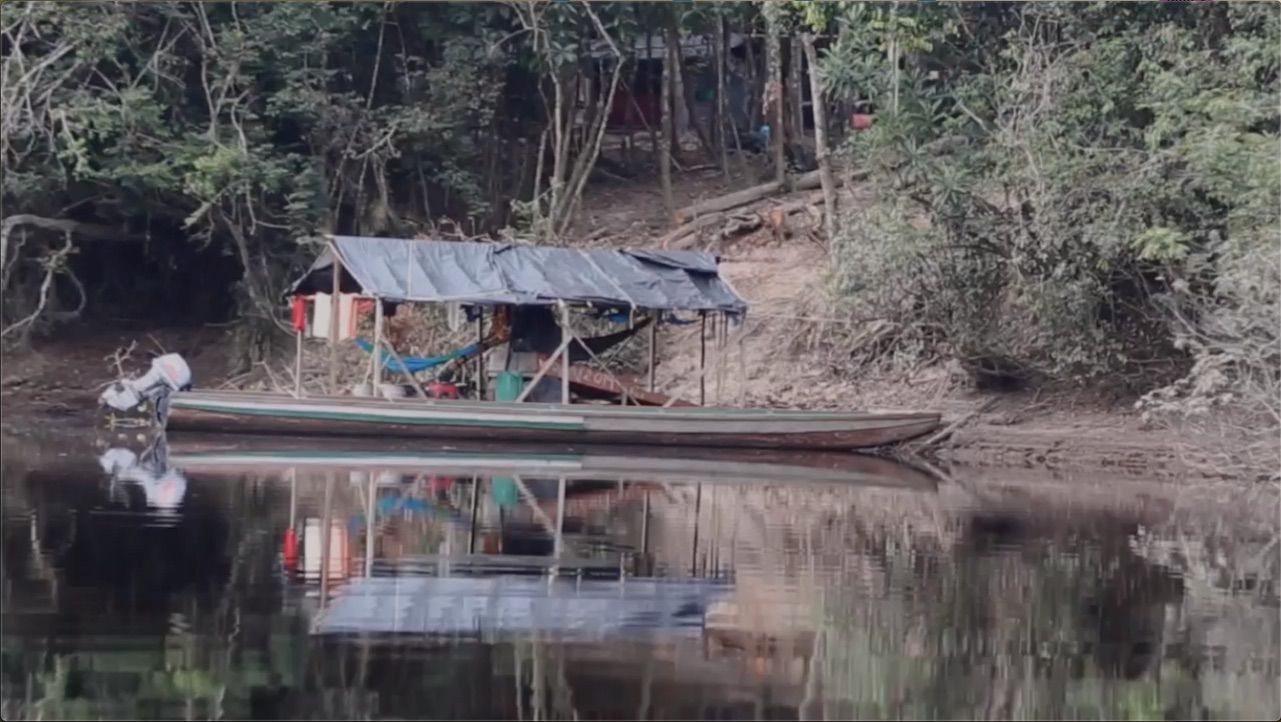
Just 14 miles from the renowned Angel Falls, the highest waterfall on the planet that inspired the movie Up, there is at least a score of makeshift barges and an open-pit mine where hundreds of men and women go to work every day.
After a flyover of the western section of Canaima and more than 30 hours of navigation on the Carrao River, Runrun.es got a firsthand account of how these miners work inside Canaima National Park. Declared a World Heritage Site by UNESCO, the park was placed under an “orange alert” in 2018, after significant concern was raised over mining activities in the area as well as its devastating impact on the environment and local residents.
Mining sites in Canaima are controlled by the original inhabitants: the Pemón ethnic group. Driven by the collapse of tourism in the area, they have turned to illegal mining in order to survive.
Gold extracted from this ancient landscape is taken on board light aircrafts owned by a local businessman who has been accused by the Venezuelan Public Prosecutor’s Office of being a member of a trafficking network that transports the metal from Venezuela to the Caribbean islands.
This same person is linked to a luxury lodge located inside Canaima National Park. According to the Pemón indigenous people, an armed attack ordered by the President of Venezuela, Nicolás Maduro, “to put an end to mining” was planned here on December 8, 2018. Once perpetrated, it forever altered Canaima and its inhabitants.
Gold mining in Canaima is recognized by indigenous organizations which, according to sources, originated in the last five years to regulate the mining activity.
The danger of small-scale and artisanal mining in Canaima is that the mercury employed is highly contaminant and affects not only the rivers’ water, but also the fauna and local population. It also causes rainforest deforestation and sedimentation of the Carrao River, a tributary of the already contaminated Caroní River which flows into the Guri Reservoir. 85% of Venezuela’s electricity is generated here. With an ongoing energy crisis throughout the country, more damage to this natural area would be catastrophic.
Esta investigación la encuentra en español gracias al apoyo de nuestros lectores y clientes, y se puede visitar haciendo clic en este enlace https://alianza.shorthandstories.com/canaima-el-paraiso-envenenado-por-el-oro/index.html
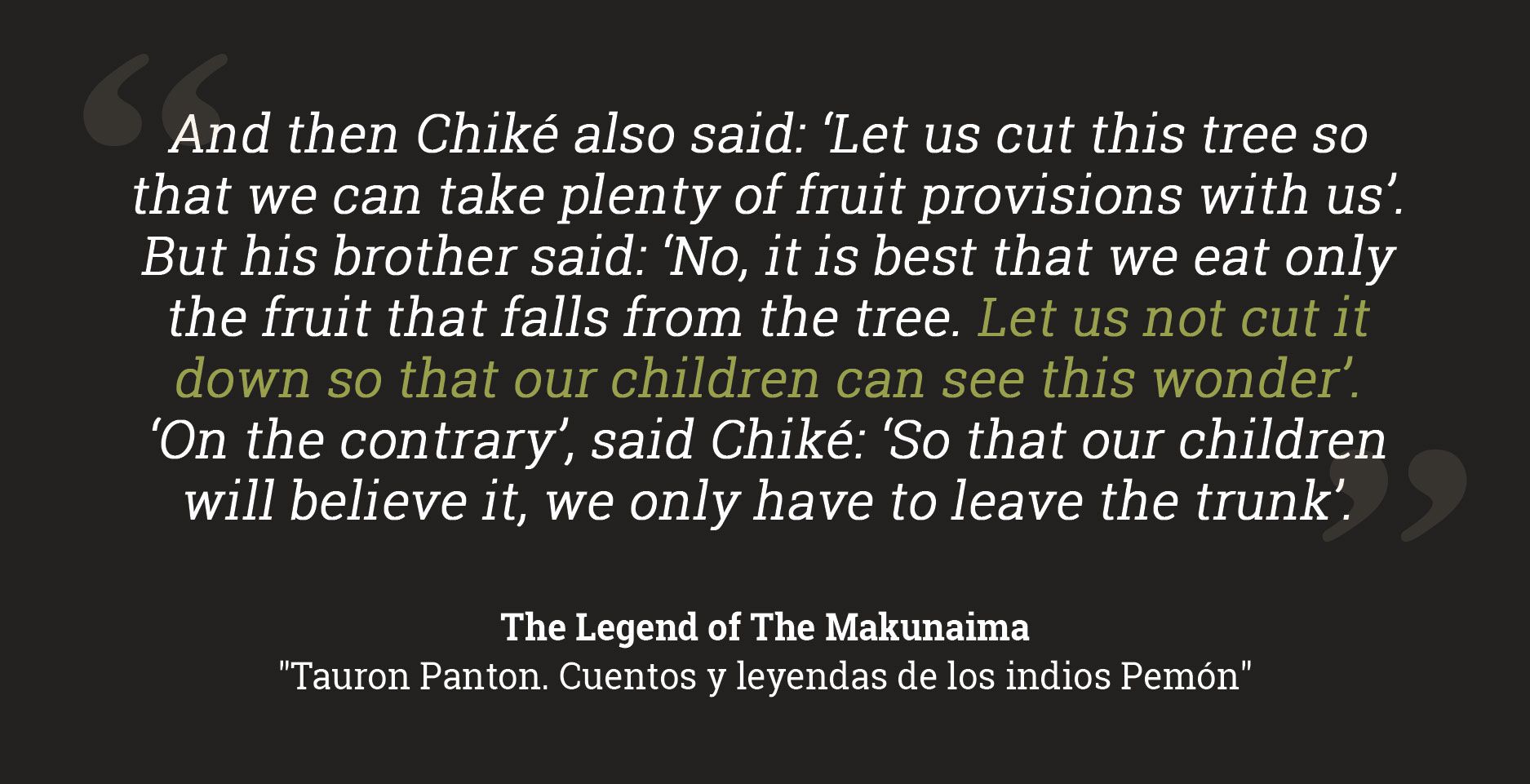
A night among the mines
Indigenous peoples extract gold in the dark
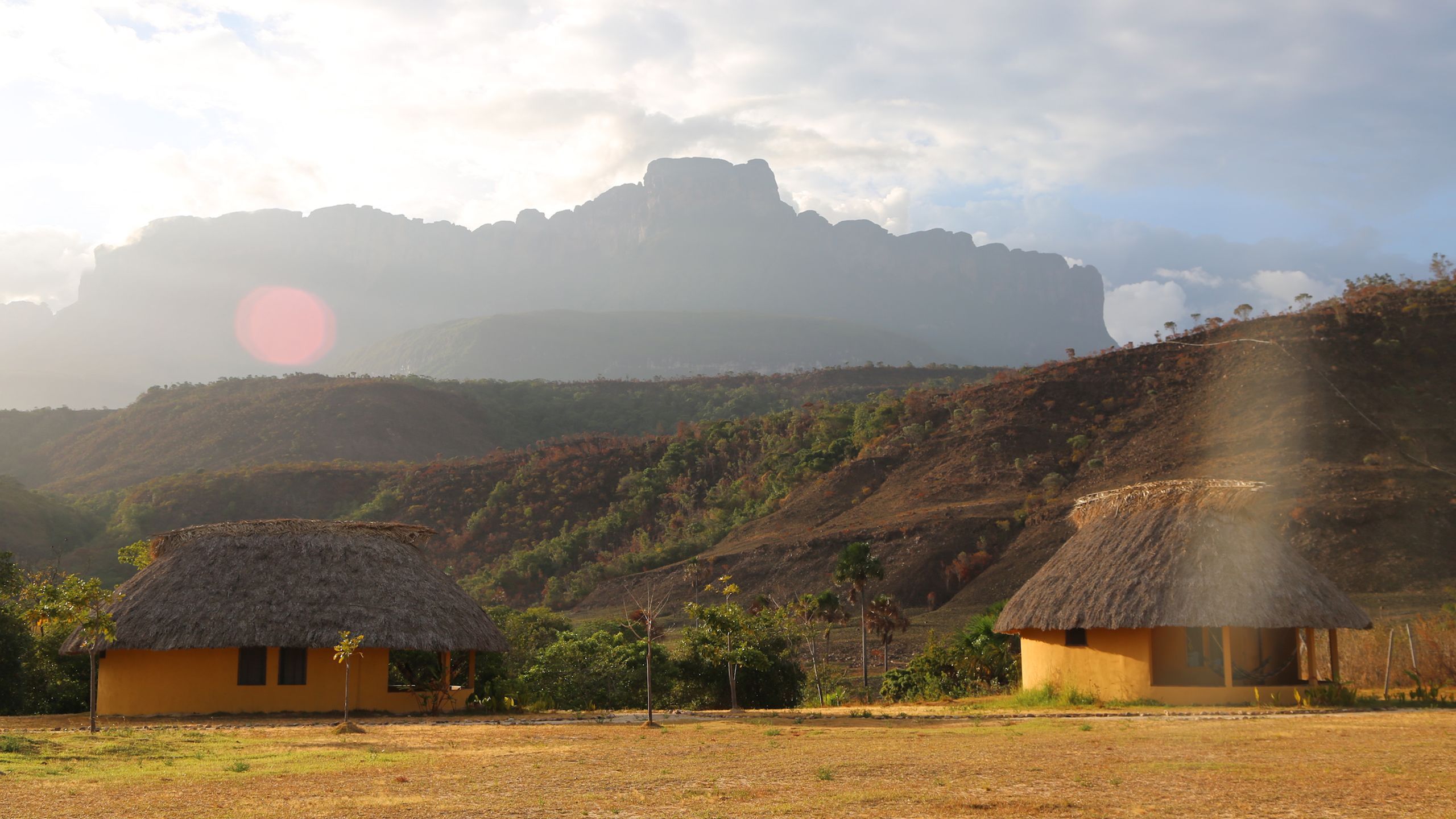
An unexpected blow pulls the curiara from its course. It is nighttime and the dugout is navigating through the Carrao River, in the banks of the Auyantepui, one of the largest tabletops in the Guiana Highlands. A map will show that the boat is right in the heart of Canaima National Park, located in Southern Venezuela. Darkness keeps the travelers guessing as to what exactly crashed into and almost capsized the narrow vessel. Only the motorista (steerer) and the proero (bowman), veteran indigenous people belonging to the Pemón ethnic group, can tell that the obstacle in question is an artificial sand mound. Ever since gold searchers began swarming the area, there are plenty of them lying below the river’s dark waters.
From a distance, lights signal the proximity of an open-pit mine, the likes of which abound downstream the Arenal sector of the Carrao River. The purring sound of the dugout’s engine makes the lights go out completely. The boat reaches a camp traditionally reserved for tourists. It is dark and occupied by the women in charge of preparing meals and washing clothes for the nearby miners. They hurriedly leave as the travelers disembark. After dinner, the travelers quickly wrap themselves in their hammocks. Mosquito nets protect them against malaria, a disease endemic to gold mining. They go to sleep amidst the sounds of frogs croaking, yet there is another unmistakable sound lulling about: it is the distant rattle of machines processing gold extracted from the sandy depths of the Carrao River. Such is the scene in front of the majestic Wei-Tepui or the tepui of the Sun.

A tourist camp is provisionally occupied by the indigenous people who work in the mines of Carrao River. Photo: Lisseth Boon.
A tourist camp is provisionally occupied by the indigenous people who work in the mines of Carrao River. Photo: Lisseth Boon.
In the Western sector of Canaima National Park, there is an agreement between the Pemón, traditional inhabitants of these ancient lands, to work in the mines only at night. They do so to avoid being seen by the ever less frequent tourists who visit this natural reserve. Declared a World Heritage Site by UNESCO in 1994, nowadays there is no way to hide the destruction. In broad daylight, one can see gasoline drums dumped on the shores of the rivers while the so-called “balsas mineras”, a poor man’s version of a barge, float nearby. These makeshift barges are not meant for navigation. Their sole purpose is to float and hold the machines that dredge river beds in search for gold.
On a 36-hour journey down the rivers of Canaima National Park, Runrun.es was able to count 21 active barges: one in the mouth of the Akanan River, five throughout the waters of Carrao River and 14 in the Arenal sector. All of them float around the millenary landscape with no specific order or direction. Yet, they are not the only evidence of mining in the area. Navigators must avoid their curiaras from becoming tangled with the floating “puntos”, buoys crafted with rope and plastic bottles, which signal a soon to be mined gold vein.
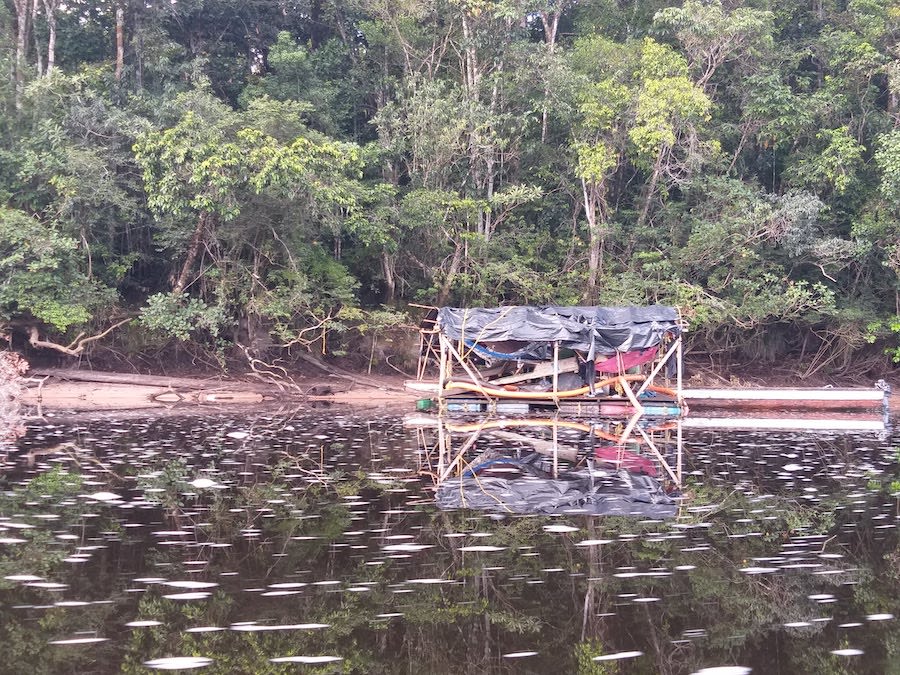
A makeshift barge in the Carrao River. Photo: Lisseth Boon.
A makeshift barge in the Carrao River. Photo: Lisseth Boon.
“If they keep on mining gold like this, the Carrao River is going to end up like the Arekuna (camp) in the Caroní River which is all brownish because of the amount of barges surrounding it”, says R.C., a veteran tour guide in Canaima and a fierce critic of gold mining. He watches the soft wake the curiara leaves on the caramel colored waters. It is the color of the Carrao River. Years before, the Caroní River, the second most important river in Venezuela, used to have this color. Today, mining has troubled its waters.
An aerial view from the light plane which will shortly land in Canaima’s small airport shows the streaks mining has left on the borders of these theoretically sacred grounds which were declared a national park by former president Rómulo Betancourt on June 16, 1962. There is a sharp contrast on this side of tepui kingdom. On one side, are these unique, massive tabletops surrounded by jungle, savannahs and waterfalls. On the other, artificial sand quarries and radioactive green lagoons that ooze mercury gnaw at the banks of the Caroní River. Mercury is used to separate gold from sand.
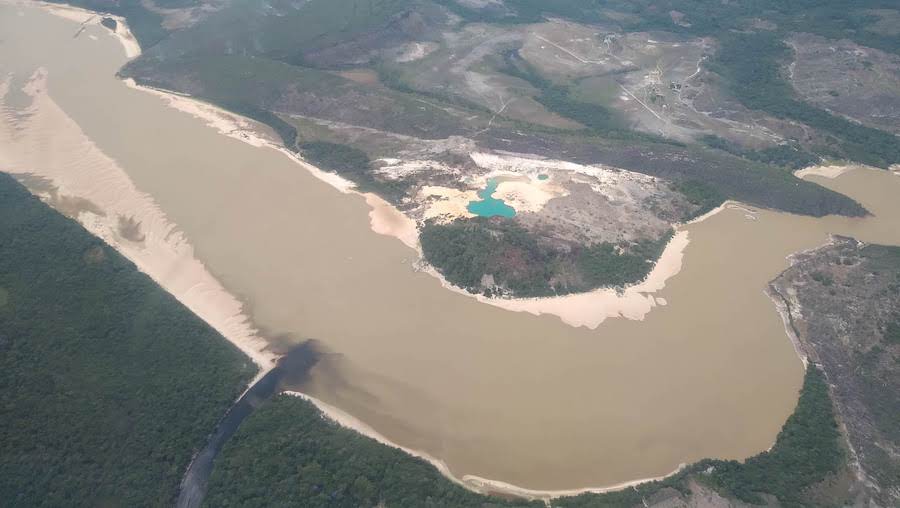
An aerial view of the Caroní River in the borders of Canaima National Park. Photo: Lisseth Boon.
An aerial view of the Caroní River in the borders of Canaima National Park. Photo: Lisseth Boon.

Not even the sacred Auyantepui has freed itself from gold fever. The search for the mythical “ore bed” was the real reason behind the expedition organized by American pilot Jimmy Angel (1899-1956) with Venezuelan captain Félix Cardona Puig to fly over this heart-shaped tabletop on May 21, 1937. They returned in October, where Angel landed on the summit, damaging his plane in the process. They spent the next 11 days walking through the Auyantepui’s jungle to return to base camp, a feat which certainly fed their legend. The aviator never found gold mines in Canaima but two years later the Ministry of Public Works christened Venezuela’s iconic waterfall -“Salto del Ángel”- in his honor
A Lack of Tourism
On the banks of the Carrao River, a man with a naked torso and defiant jawbone waves through the air when he sees cameras and cellphones pointed at him from the curiaras. Nobody wants their picture taken here, much less answer questions from the few foreigners who travel through these riverbanks during the dry season.
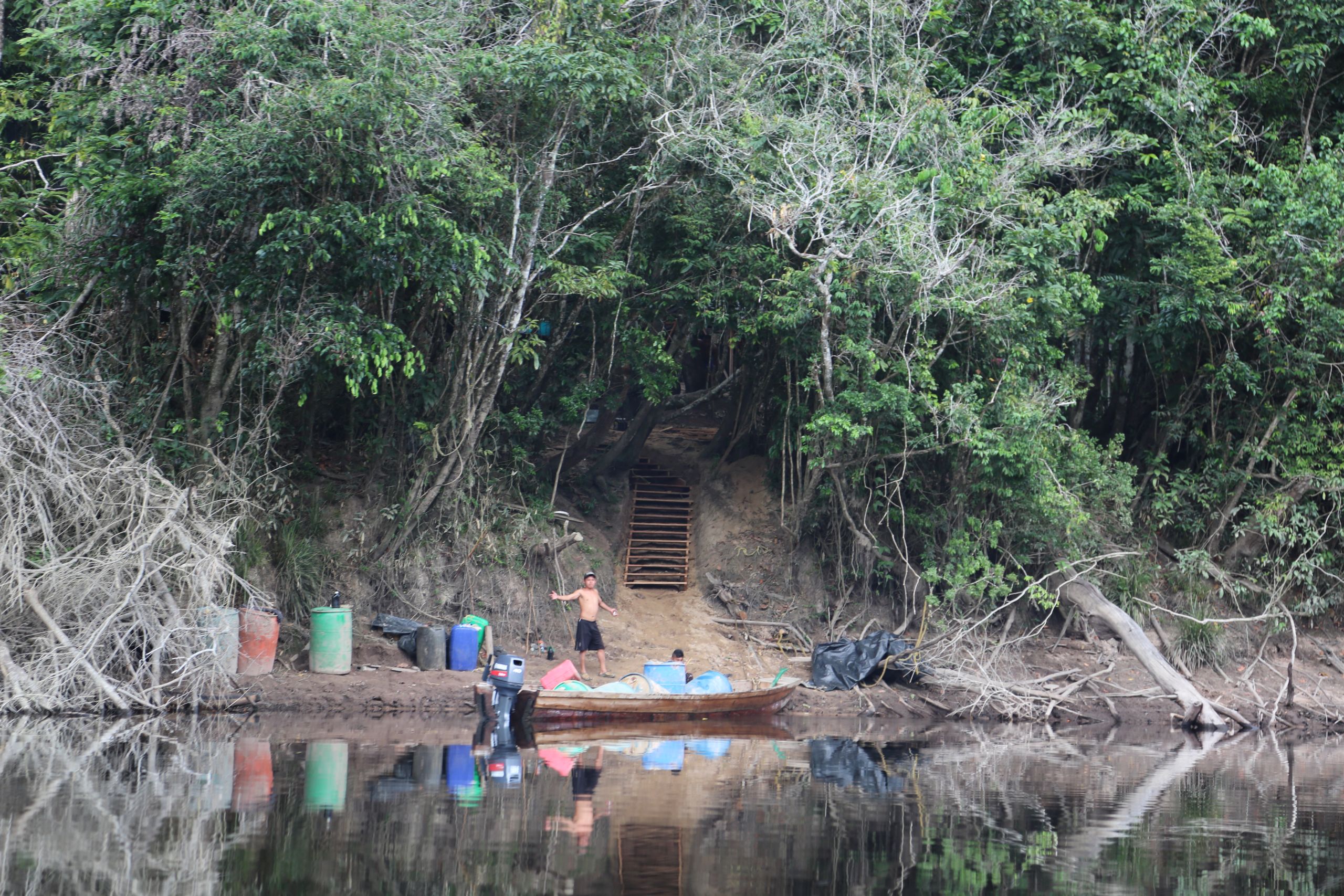
Miners in the Carrao River. Photo: Lorena Meléndez.
Miners in the Carrao River. Photo: Lorena Meléndez.
The Pemón miners have a great lack of confidence towards strangers in this particular area. More so after the December 2018 assault which took place in the sector of Arenal. Undercover agents from the DGCIM murdered an indigenous man from Canaima and left two other wounded. This event caused a commotion throughout the Pemón tribe and transcended onto Miraflores Palace, headquarters of the Venezuelan national government in Caracas.
The fact that the Pemón, traditional inhabitants of the lands where Canaima was established, are mining gold from rivers and open-pit terrains is a reality which most would prefer to turn a blind eye. Those who have dared to speak against these practices are either ignored or attacked. Such was the case of Valentina Quintero, a journalist specialized in tourism. In November 2018 she condemned gold mining in Campo Carrao and was promptly declared “persona non grata” by the Council of General Caciques. This council, led by indigenous leaders, is a political organization created to address the rise of mining in the area.
On June 4, 2019, the Minister of Environmental Mining Development and the Minister of Indigenous Peoples met with 15 caciques in the municipality of Gran Sabana, Bolívar, where Canaima is located. In that meeting the ministers reiterated that the government would protect national parks from mining operations. They also emphasized that all mining operations were to be held inside the Orinoco Mining Arc, a mining mega project which covers 43,183 square miles, roughly 12.2% of Venezuelan territory. What the government failed to mention at that meeting is that indigenous people are also involved in mining.
Runrun.es was able to prove on site that mining is not only being operated in Canaima’s borders. There is also evidence of makeshift barges dredging river beds in search for gold inside the park. An open-air pit, Campo Carrao, is just 14 miles away from the Auyantepui, the place where the largest waterfall in the planet, Angel Falls or Kerepakupai Vená (its name in Pemón language), falls at 3,212 feet high.
Gold extracted from the water and soil of this paradise is not only traded as local currency inside the park. It also appears to be smuggled outside the country as part of a contraband network. In August 2019, Tarek William Saab, the Attorney General designated by the National Constituent Assembly, issued an arrest warrant for a businessman in the tourism sector who owns several hotels in the region. Mr. Saab accused this man of using his charter planes to transport tons of gold to the Caribbean islands.
The journalists of this report went undercover through the banks of the Carrao River and the Auyantepui with the intention of documenting the events of an illegal practice in a World Heritage Site area which has been no stranger to organized crime. The protection of witness identities was imperative.
Part of the field work at Canaima National Park involved more than 20 interviews to biologists, attorneys, environmental activists, indigenous inhabitants of the region’s communities, tour operators, geologists, mining engineers and journalists. The coverage of the site was contrasted with satellite imagery.
Requests for interviews were sent out to representatives from the ministry offices of Environmental Mining Development, Indigenous People, Eco Socialism and Tourism, all of whom have authority on the matter of illegal mining in Venezuela’s national parks. As this edition went to press, there was no official response given on the evidence of mining in Canaima.
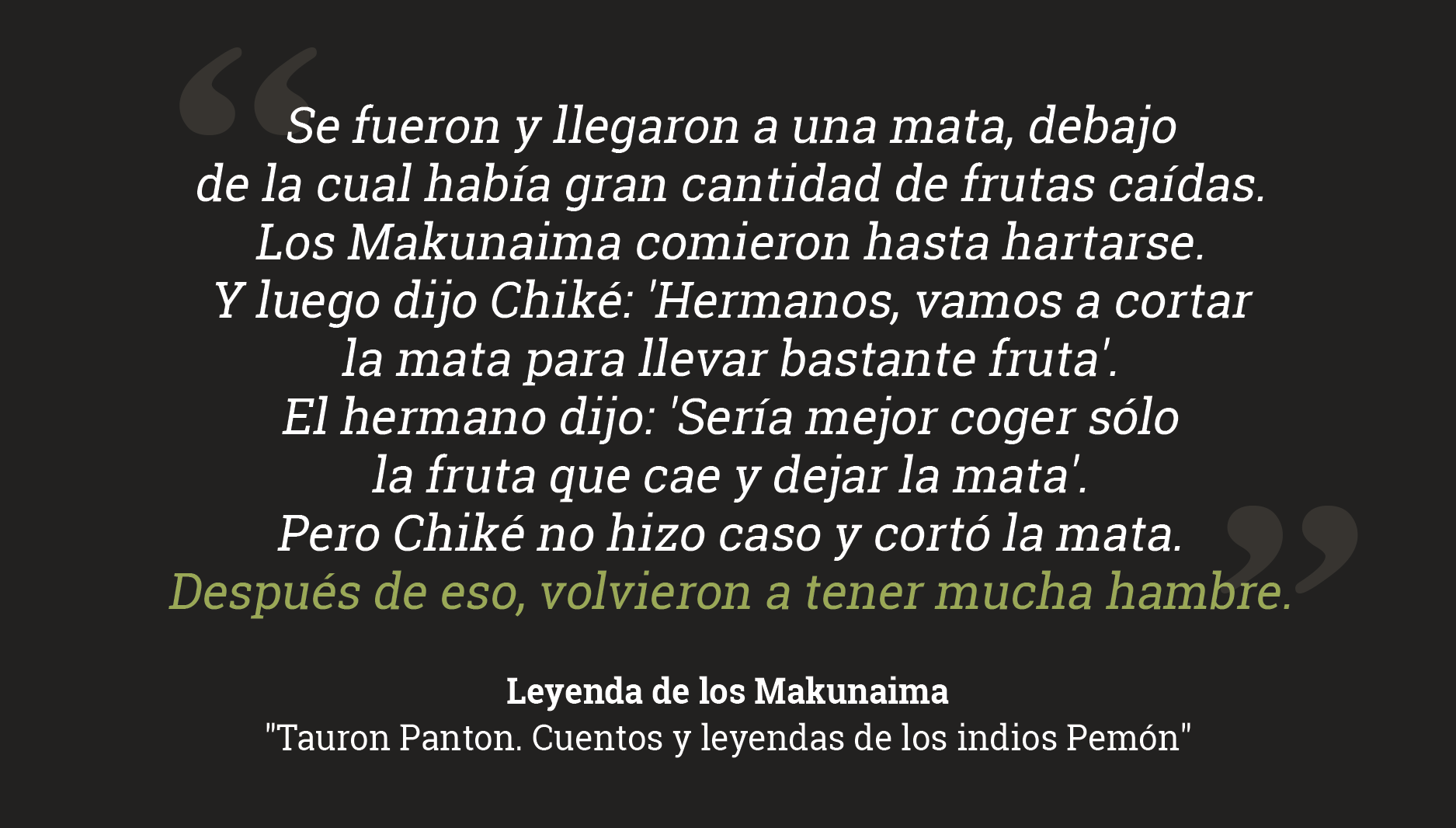



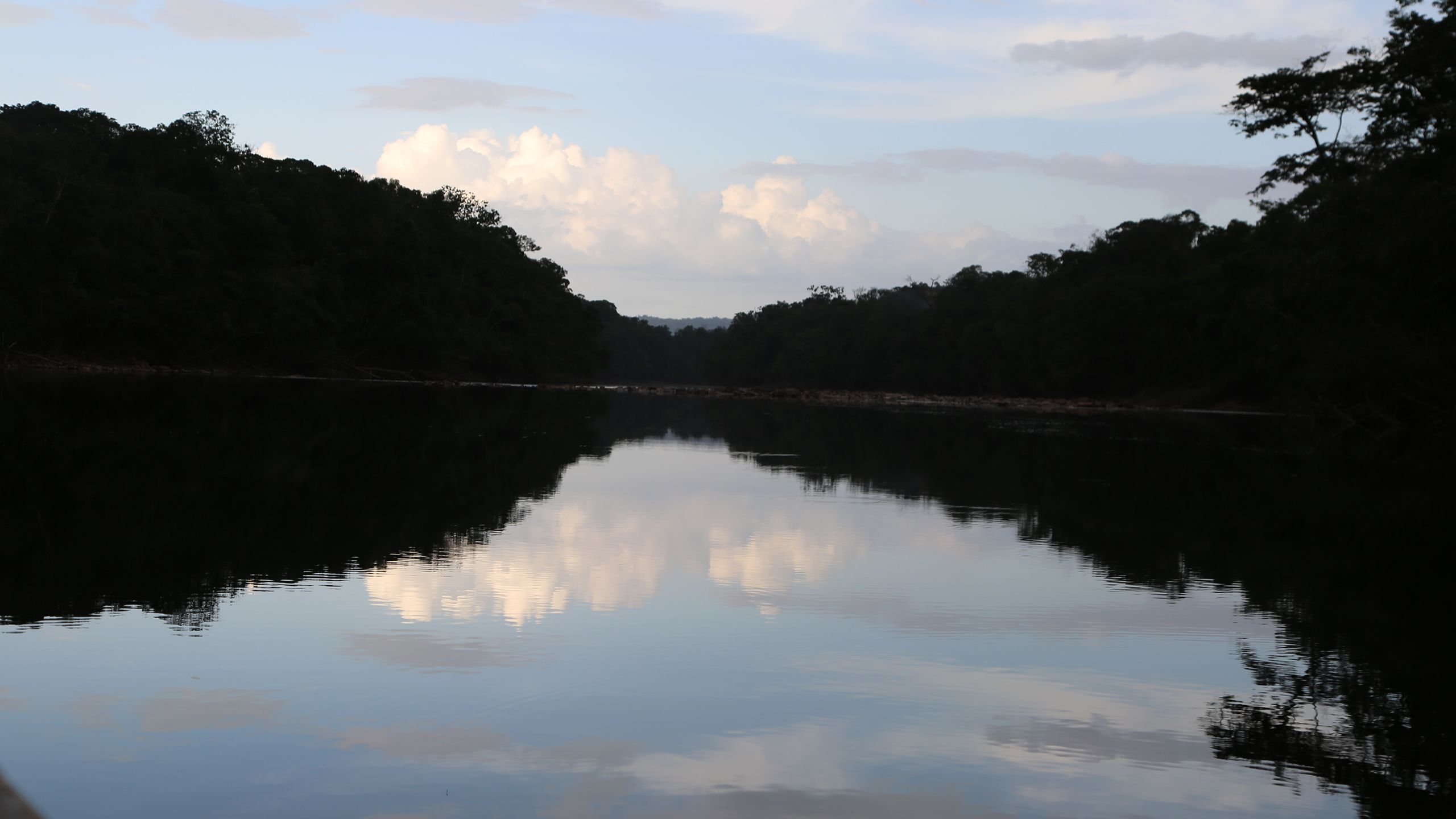

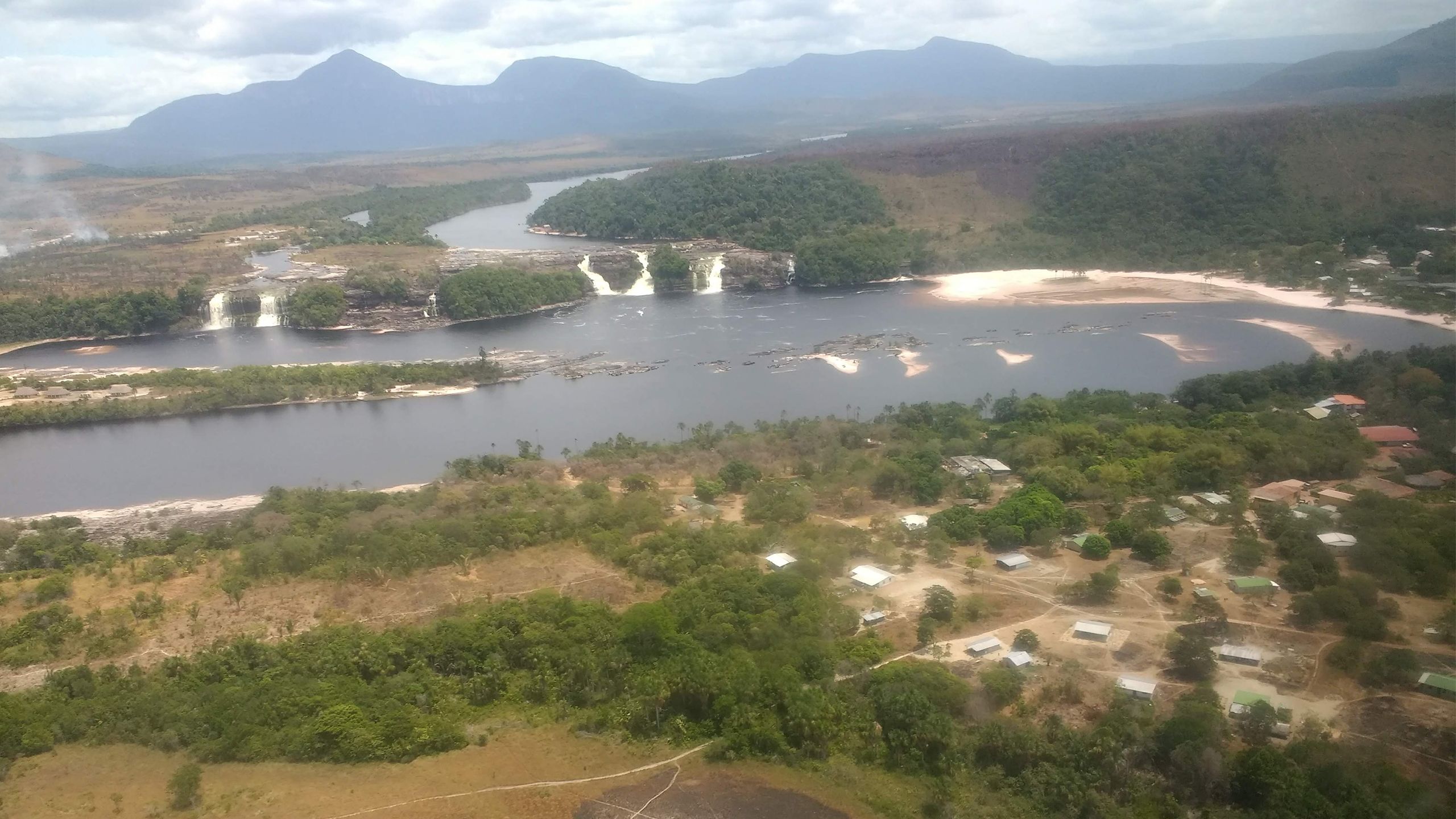
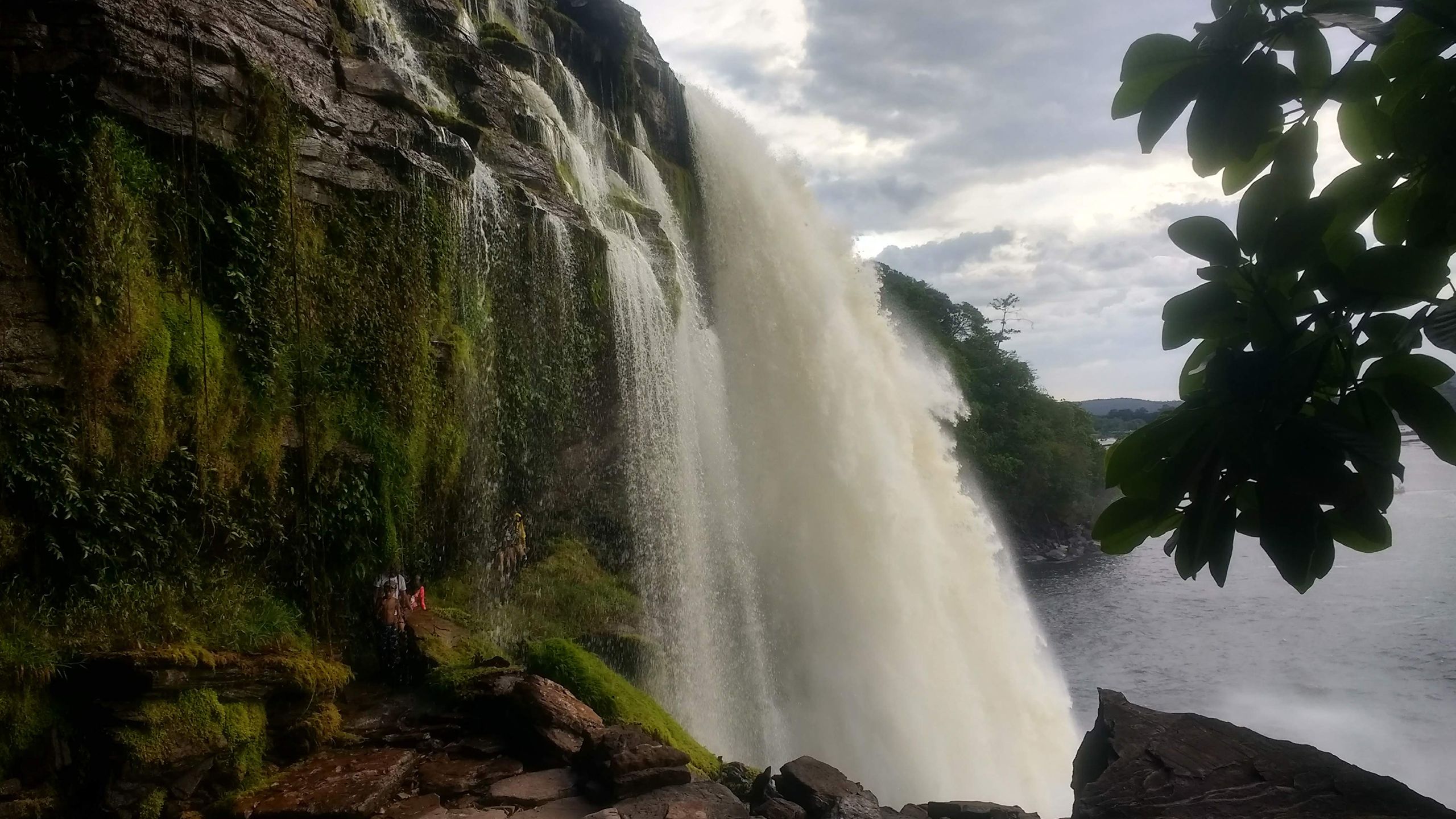

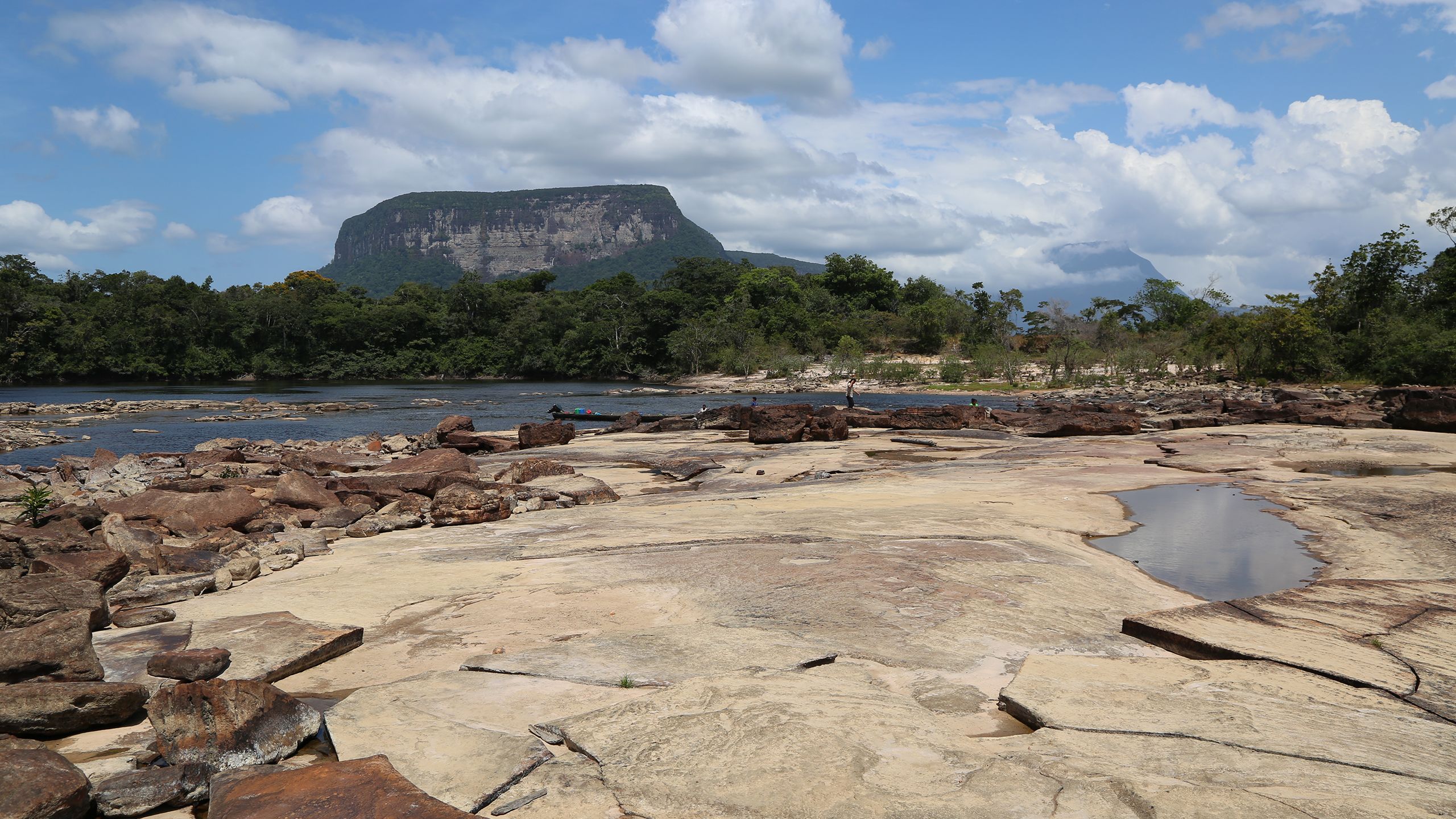

From tourism tycoon to “gold trafficker”
Charter planes smuggle the precious metal from paradise

It was the government of Nicolás Maduro who offered evidence on how gold is being trafficked from Canaima. On August 16, 2019, Tarek William Saab, the Attorney General designated by the National Constituent Assembly, issued an arrest warrant and extradition request for César Leonel Dias González, a 47 year old businessman, linked to half a dozen tourism companies in Bolívar state. Among them, the controversial Ara Merú Lodge Hotel which operates inside Canaima National Park. This hotel lodged the perpetrators of the so called “Operation Tepui Protector” (Operación Tepuy Protector), an assault carried out by the DGCIM, which left one man dead and two others wounded. All of them were Pemón.
There is no need to fly out to Canaima to become acquainted with Ara Merú Lodge. Giant billboards along the Francisco Fajardo highway in Caracas advertise it as a five star hotel “in the middle of the jungle” while radio ads saturate stations all over the country. All of this in the middle of a slumped economy where a Venezuelan worker needs to save 250 minimum wages ($6.00) to pay the average $1,500 it takes to spend a weekend for two at the national park.
This is not the first time Mr. Dias González has been linked to gold trafficking. In June 2018, his name was included in a list people involved in the so called “Operation Metal Hands” (Operación Manos de Metal) announced by former Vice President Tareck El Aissami. This operation was created to dismantle alleged gold trafficking mafia groups who smuggled the precious metal from Bolívar state. Days after this announcement, Attorney General Saab announced that the businessman was among the 39 people who were issued an arrest warrant by the Public Prosecutor’s Office.
A year and two months later, Mr. Dias González was once again identified by the Venezuelan government as a member of a trafficking network that smuggled gold from Venezuela to the Caribbean islands, mainly Dominican Republic, Aruba, Curacao and Trinidad. This time he was linked to Michael Enrique Jerez Córdoba (a private pilot) and Roberto Antonio Espejo Machado, labeled by the Attorney General as the leader of a criminal gang who is also wanted by the “Operation Metal Hands” for the crimes of theft of strategic materials and aggravated trafficking.
On August 16, 2019, the Venezuelan Public Prosecutor’s Office issued an arrest warrant requesting extradition for Dias González, Espejo Camacho and six other Venezuelans for the crimes of illicit gold trade in the Dominican Republic as well as ordering the seizure of four aircrafts and freezing of their bank assets.
Tarek William Saab: También se determinó la vinculación de César Dias González, representante legal de Transportes Aéreos del Sur y dueña de 2 aeronaves utilizadas habitualmente por Michael Jérez y Roberto Espejo para viajar a República Dominicana a comercializar el oro
— MinPublicoVE (@MinpublicoVE) August 16, 2019
Tarek William Saab: Se estableció que Cesar Dias González realizó múltiples viajes hacia Dominica, Curazao y otras islas del Caribe, destinos considerados como parte de la ruta de contrabando de nuestro recurso aurífero
— MinPublicoVE (@MinpublicoVE) August 16, 2019
Tarek William Saab: También se solicitó orden de aprehensión contra César Dias González, Roberto Espejo y los 6 venezolanos detenidos en República Dominicana; así como prohibición de enajenar y gravar bienes, además del bloqueo e inmovilización de instrumentos bancarios
— MinPublicoVE (@MinpublicoVE) August 16, 2019
To date, this extradition request has not reached Santo Domingo, as confirmed by the Office of the Solicitor General in the Dominican Republic. A Mutual Assistance Agreement in Criminal Matters signed on January 31, 1997 exists between both nations.
Workers and inhabitants of Canaima spoke to Runrun.es that Dias González has not been seen at the national park since Attorney General Saab announced the warrant requesting extradition for the gold traffickers. They can confirm that the businessman tends to his local businesses from abroad, and usually speaks with employees of Ara Merú Lodge and Camp Uruyen, located in the Kamarata Valley, to give them instructions.
In regards to his whereabouts, a new clue arose three months after the Public Prosecutor’s Office announced the warrant. On November 10, 2019, the Venezuelan Supreme Court of Justice approved Dias Gonzalez’s extradition request to the Kingdom of Spain who, unbeknownst by the Spanish Embassy in Caracas, had been detained in Madrid on September 17 by request of the Venezuelan government. The businessman had allegedly escaped the Dominican Republic where authorities detained three of his business associates (Jonathan Luciano del Valle Mata Figueroa, Esthella Gómez de Rodriguez and Claudio Alejandor Di Génova Fistarol) when they intended to travel in a private jet from the Caribbean island to Barcelona, Anzoátegui (located in northeastern Venezuela) with $1,378,000 in cash they had collected from gold sales.
The general consensus in Canaima regarding Ara Merú Lodge is that its size and facilities heavily contrast with other camps in the area which have been designed to blend in with the paradisiacal environment. Eyebrows are raised when asked who is behind this structure built in record time, with no prior studies on its environmental impact and no authorization by the National Parks Institute (INPARQUES for its acronym in Spanish) affiliated to the so-called Ministry of Eco Socialism.
The origins of its developer are also a mystery. Little is known about César Dias González’s management career before becoming the thriving tourism tycoon who opened Ara Merú Lodge in 2017. He literally landed in Southern Bolivar and began to open businesses in a protected natural area which requires a permit from INPARQUES, the governing body on national parks and monuments, as well as an alliance with at least one representative of the Pemón indigenous peoples, traditional inhabitants of the lands known as Canaima.
There is also no word on the origins of his capital. The only information available is that Mr. Dias González is registered to vote in the “Beatríz de Rodriguez” electoral center, located in Guárico state. Coincidentally, it is the same voting center of Michael Enrique Jerez Córdoba, one of his alleged associates in the gold smuggling network according to the Venezuelan Public Prosecutor’s Office.
Runrun.es tried to communicate with César Dias González to obtain his version but got no reply.
The hotel and “its wonders”
An inquiry around the Canaima Lagoon regarding the ownership of Ara Merú Lodge leads to only one name: César Dias. The businessman (whose last name has been often written in the press as “Díaz” with a z) is also credited to be the owner of several other properties: Camp Uruyen (Kamarata Valley, Canaima); Camp Waká Vená (under construction; located near Salto Hacha waterfall, Canaima); Gran Sabana Hotel (Santa Elena de Uairén, bordering Brazil) and the Posada Mediterráneo beach lodge (Los Roques archipelago). As in Caracas, enormous billboards dominate the external façade of the Carlos Manuel Piar international airport in Bolívar and ads are insistently aired in radio stations across the state.
2) G L A M P I N G | en menos de dos años este señor se apropió y construyó estos hoteles y campamentos en Parques Nacionales: En Canaima Ara Meru, Hotel Gran Sabana y Uruyen Camp. En Los Roques, La Posada Mediterráneo. Quién lava dinero a través de este testaferro? pic.twitter.com/lSIo9M9sqX
— Ricardo Delgado PEMON (@ThinKarawak) August 16, 2019
The only company Mr. Dias owns on paper is Transporte Aéreo del Sur, Transur C.A. where he appears to own 80% of the company’s shares. According to the Public Prosecutor’s Office, it is this company that links Dias with the gold smuggling network.
With the exception of Transur C.A., none of the other four properties he allegedly owns –Camp Uruyen, Camp Waká Vená, Gran Sabana Hotel, and Posada Mediterráneo- include his name in the records filed in the Mercantile Registries of Bolívar and Caracas. However, there are several elements that link Mr. Dias to the companies that own these properties. For example, Joseph Rodríguez Sousa, the president of Transur C.A., is also a shareholder of Camp Uruyen, set up in 2018. José Luis Hernández Santana and Claudio Alberto Monasterios González, are business associates of the company Posada Turística Ara Merú Lodge C.A. as well as Gran Sabana Hotel. Monasterios González is president of Paca Trading, a Panamanian corporation whose board of directors includes José Alberto Monasterios and María Concepción González Gómez. Ms. González Gómez is also one of the owners of Inversiones CLD 2012, C.A. (a corporation which owns 60% of Ara Merú Lodge shares) and at the same time is the director of CD Holdings, a corporation with headquarters in Panamá in which César Leonel Dias González serves as president and chairman. In turn, Fernando Tarazona, who serves as vice president of Transur, C.A., is signaled by the press to be the owner of Ara Merú Lodge, C.A.
As stated, Mr. Dias González is the alleged owner of Posada Mediterráneo, a beach lodge located in Los Roques archipelago, another national park. Opened in 2009, the lodge has received distinguished guests such as Venezuelan soccer player Tomás Rincón who celebrated his wedding there. Posada Mediterráneo is managed by Mr. Dias González’s sister, Alejandra Dias Dávila. In 2018, she was seen attending the International Tourism Fair (FITUR) held in Madrid, promoting her brother’s properties at Venezuela’s official stand.
Ms. Días Dávila, who also does public relations for Ara Merú Lodge, describes her older brother as “forward-thinking, a curious dreamer”. In an interview for Etiqueta magazine on August 13, 2017, in which César Dias is identified as the owner of the five star hotel, Ms. Días Dávila stated that “it all began with a dream my brother César had after falling in love with Canaima National Park when he visited it for the first time”. The hotel was inaugurated during the 2017 Carnival holidays and opened to the public in January 2018.
Actas Constitutivas de Ara ... by runrunesweb on Scribd
As reported by Los Roques Posada Mediterráneo’s Instagram account, Ara Merú Lodge’s was officially presented by Grupo Maloka at the 2016 Venezuelan International Tourism Fair (FITVEN) held at the island of Margarita in November of that year.
Purchases made prior to the opening of Ara Merú Lodge speak of the magnitude of the site. According to the Importgenius database, just in May 2016 the company imported 6.8 tons of merchandise equivalents to $75,753, distributed in furniture ($33,165), machinery ($20,748), rugs, glass and manufactured goods ($16,523).
Like stones under the river
Ara Merú Lodge’s development began way before its formal presentation at FITVEN in 2016. It was registered in the Mercantile Registry Office on July 3, 2013, four months after Nicolás Maduro took oath as President of Venezuela and a few months before the claims on mining in Canaima began.
The articles of incorporation and bylaws of Posada Turística Ara Merú Lodge, C.A. are one of the most guarded records in the II Mercantile Registry office in Ciudad Bolívar, capital of Bolívar state. Contrary to the principles of accessibility and free consultation of its archives, as established by the Venezuelan Law on Registries and Notaries, the file that contains the original records of this company in particular is jealously guarded. A request for this file in October 2019 was met with endless excuses about the computer system being down until finally public employees claimed that it had simply “disappeared”.
The articles of incorporation state that the company was registered with a capital of Bs. 2,000,000 which are equivalent to $198,020 according to the official exchange rate for the month of July 2013 (rate given by the Alternative Foreign Currency Exchange System ((SICAD for its acronym in Spanish)).
The shareholding structure of Posada Turística Ara Merú Lodge, C.A. is peculiar. The majority of the shares (60%) belong to Inversiones CLD 2012, C.A., a company registered in Los Teques which is located around 621 miles from Canaima National Park, where the headquarters of Ara Merú Lodge are based. The owner of Inversiones CLD 2012, C.A. (which bears the initials of César Leonel Dias) is Claudio Alberto Monasterios González, who in turn owns 51% of shares at the Gran Sabana Hotel and also votes in the same electoral center as Mr. Dias González.
The second main shareholder of Ara Merú Lodge is José Luis Hernández Santana who is also the owner of 9% of shares in the Gran Sabana Hotel. He also owns the company Orinoco Airlines headquartered in Hialeah, Florida, U.S.A.
The remaining Ara Merú Lodge shareholders are distributed as follows: 10% of the stocks are owned by Rosmary Eugenia Sulbarán Sulbarán and Darío Ramón González (both Pemón indigenous people) own 10% of the shares respectively while the remaining 5% of shares belong to Charlie Alexander Rivas Manrique (also a Pemón).
Golden Aircrafts
In a matter of six years, Mr. Días González has built a network of companies throughout several cities in Venezuela, the US, Panama and Colombia whose company objects range from construction materials, vehicle maintenance to tourism services.

In his August claim, Attorney General Saab stated that the parties involved were legal representatives of multiple related companies across Venezuela used as facades to launder money obtained from illicit operations. He also claimed that Mr. Dias González’s company Transporte Aéreo del Sur, Transur C.A. directly links him to the smuggling network as this company owns the light aircrafts which were used for trafficking operations. According to the Attorney General, Mr. Dias González used these aircrafts to fly multiple times to the Dominican Republic, Curacao, Aruba and Trinidad, the same islands that are part of the gold contraband route.

This post was published by Transportes Aéreos del Sur, Transur, C.A. on its Facebook page after Tarek William Saab accused its owner, César Dias, of being a member of a gold smuggling network. Photo: Facebook page screenshot.
This post was published by Transportes Aéreos del Sur, Transur, C.A. on its Facebook page after Tarek William Saab accused its owner, César Dias, of being a member of a gold smuggling network. Photo: Facebook page screenshot.
All planes owned by Transur, C.A. have the Ara Merú Lodge logo stamped in their fuselage. They were usually seen on the runways of Ciudad Bolívar and Puerto Ordaz airports, both of them in Bolívar state, chartering tourists to Canaima. However, in recent months, these aircrafts changed routes. A tourist operator confirmed that the Cessna 206 planes used by this airline had stopped flying tourists and began flying food, machinery and utensils to the mining zones instead.
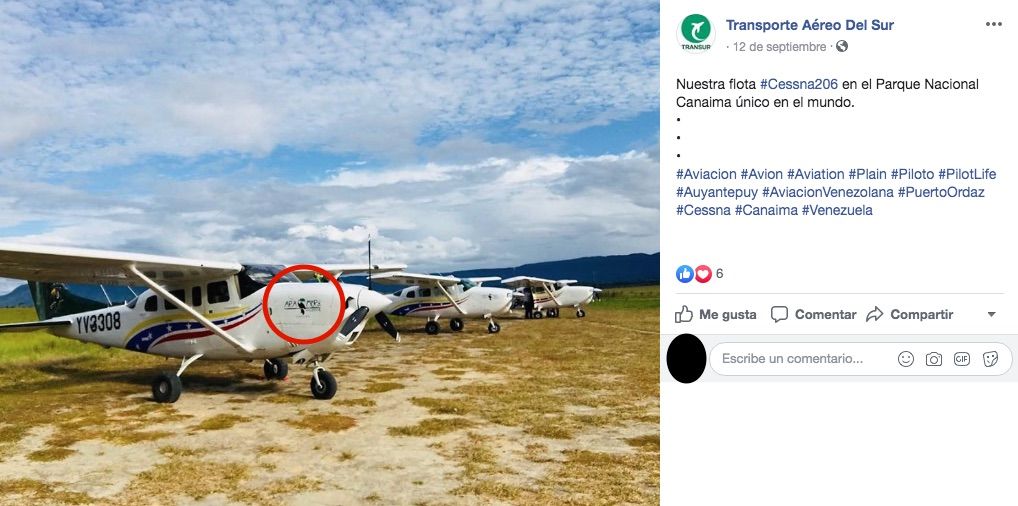
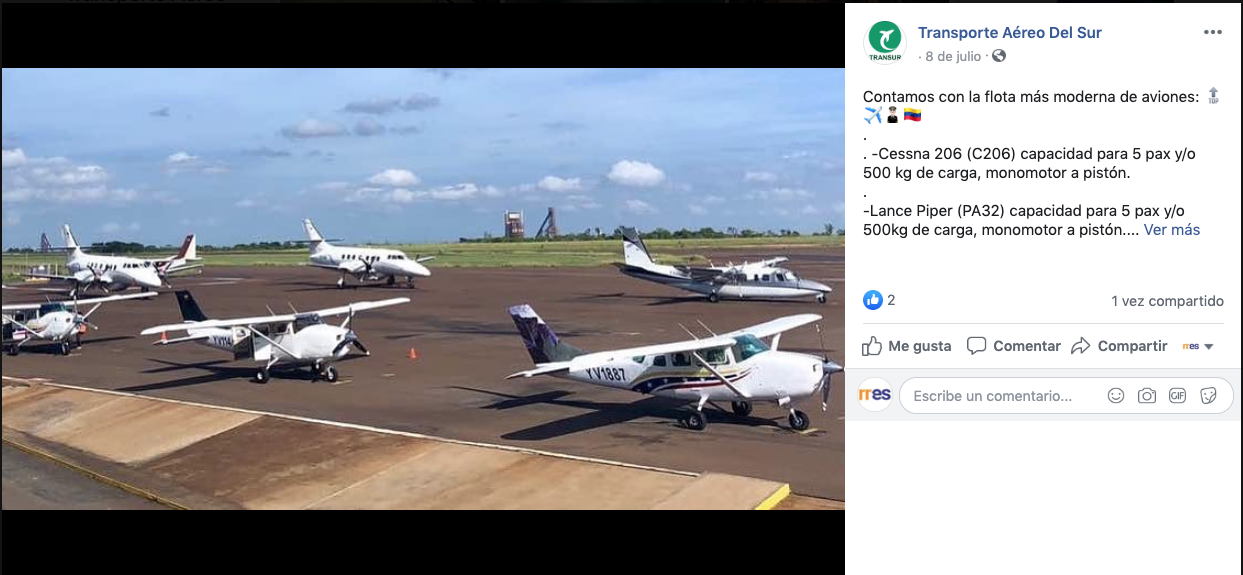
Although Mr. Dias González owns 80% of Transur, C.A. shares, he is not on the company’s board of directors. In his place are Joseph Rodríguez Sousa as president and Fenando Eduardo Tarazona Prada as vice president. The three of them set up the company in Caracas in January 2019. Its original headquarters were located at Torre América, Av. Venezuela, Bello Monte, municipality of Baruta (Caracas) until they changed location to Manuel Carlos Piar International Airport in Puerto Ordaz, Bolívar.
According to its articles of incorporation, the company object of Transur, C.A. deals with “repair, installment, maintenance, implementation and installation of everything related to aircrafts, airplanes, import and sale of aeronautical parts as well as anything related to this matter including any type of transportation, including international and domestic freight transport, passenger transport, mail, executive transport, and affiliation to the Organization of Aeronautical Maintenance (OMA)”. The company also specializes in “trading, importing, exporting, buying, selling any type of materials, supplies, raw materials, equipment, and any related products and machinery”. Likewise, the company “(may) associate with other domestic or foreign companies to enter into any form of legal trading activity”.
Acta Constitutiva de Transur by runrunesweb on Scribd
The capital put forward to set up the airline company was Bs. 17,054,370 (equivalent to $5,175 according to the exchange rate registered that day by the Central Bank of Venezuela). The most expensive items in its inventory are nine computers, two air conditioners and two Kawasaki Mule vehicles. There are no aircrafts registered in the document. A used Cessna 206 airplane, such as the ones that make up the Transur fleet, cost around $200,000 in international markets.
Transur, C.A. succeeded a company called Corporación Aérea del Sur (Corasur for its acronym in Spanish). In September 2018, one of its light planes crashed into the Auyantepui killing four passengers (two adults and two children), all of them members of a single family and the pilot Ángel Larrode who according to El Cooperante had been suspended by the National Aeronautical Institute (INAC) for forging flight hours to obtain an additional accreditation.
The damaged aircraft was part a fleet belonging to Corasur which was certified through express service as an aerial taxi company by the INAC in 2018. According to regional sources, its owner, Fernando Tarazona, “the owner of Ara Merú Lodge” according to the press, had invested some $3,000,000 in the company’s facilities at Carlos Manuel Piar Airport in Puerto Ordaz.
Transur, C.A. has a Facebook page created on March 26, 2018. The Page Transparency section shows that the company changed its name one time from Corporación Aérea del Sur to Transporte Aéreo del Sur.
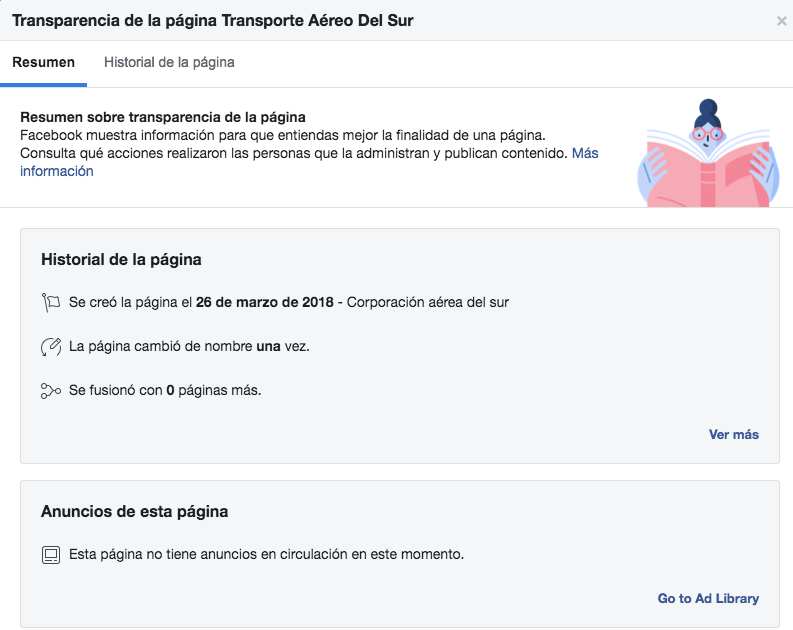
Another kind of tourism
César Dias González also has a company registered in Colombia, specifically in Cúcuta. Inversiones Servifrontera SAS was created on August 24th, 2015. Its registration certificate is currently inactive according to the registries located in the Cúcuta Chamber of Commerce. Mr. Dias González serves as the general manager of this company which specializes in, among others: “the maintenance and repair of automobiles, sales of new and used parts for automobiles and wholesale trade of solid, liquid, and gas fuel and connecting products”. Nothing is related to tourism.
One of the last known financial operations made by Mr. Dias González was the setting up of a corporation in Panama called CD Holdings S.A., on June 24th, 2019. According to the website Open Corporates, the businessman is the company’s director, president, treasurer, legal representative and executor. Only three more names appear in the corporation: José Alberto Monasterios (secretary, director and executor), María Concepción González Gómez (director) and Tamara Michelle Velez Herrera (agent).
Monasterios and González Gómez, are not only shareholders of Ara Merú Lodge, they are also business associates of Paca Trading S.A., another Panamanian corporation set up in December 2017.
The Open Corporates website also states that in November 2016, Mr. Dias González registered another company named Unimark LLC.in Sunrise, Florida, U.S.A. It is currently inactive.
Judging by Tarek William Saab’s August 16 accusation, the Maduro administration is fully aware of what gold smuggling means. Although Mr. Saab did not mention Canaima expressly, he did point out the havocs caused by illegal mining and trade. He classified it as a high degree criminal offense which hurts Venezuela’s economy and seeks to destroy it in “unimaginable levels”. He stated that “it is comparable to the worst crimes, a crime against humanity and drug trafficking. It is controlled by mobsters who disguise their criminal activity through companies that only exist on paper. It is a whip that hurts the people of Venezuela”.
But deep down all of these actions taken by the Maduro administration to fight gold trafficking do not seek to administer justice, preserve the environment or eradicate mining at the national park, says Congressman Américo de Grazia, a frequent critic of the mining management and its human rights violation in Bolívar.
“Perhaps, behind this Canaima businessman, accused today of gold trafficking there was another operator such as former Governor of Bolivar Francisco Rangel Gómez or the current Governor, Justo Noguera Pietri, all of them groups of power who pretend to displace others in order to control the mining business. The pattern of the Operation Metal Hands carried out in 2018 continues. There are no rules in the criminal market”, says Da Grazia.
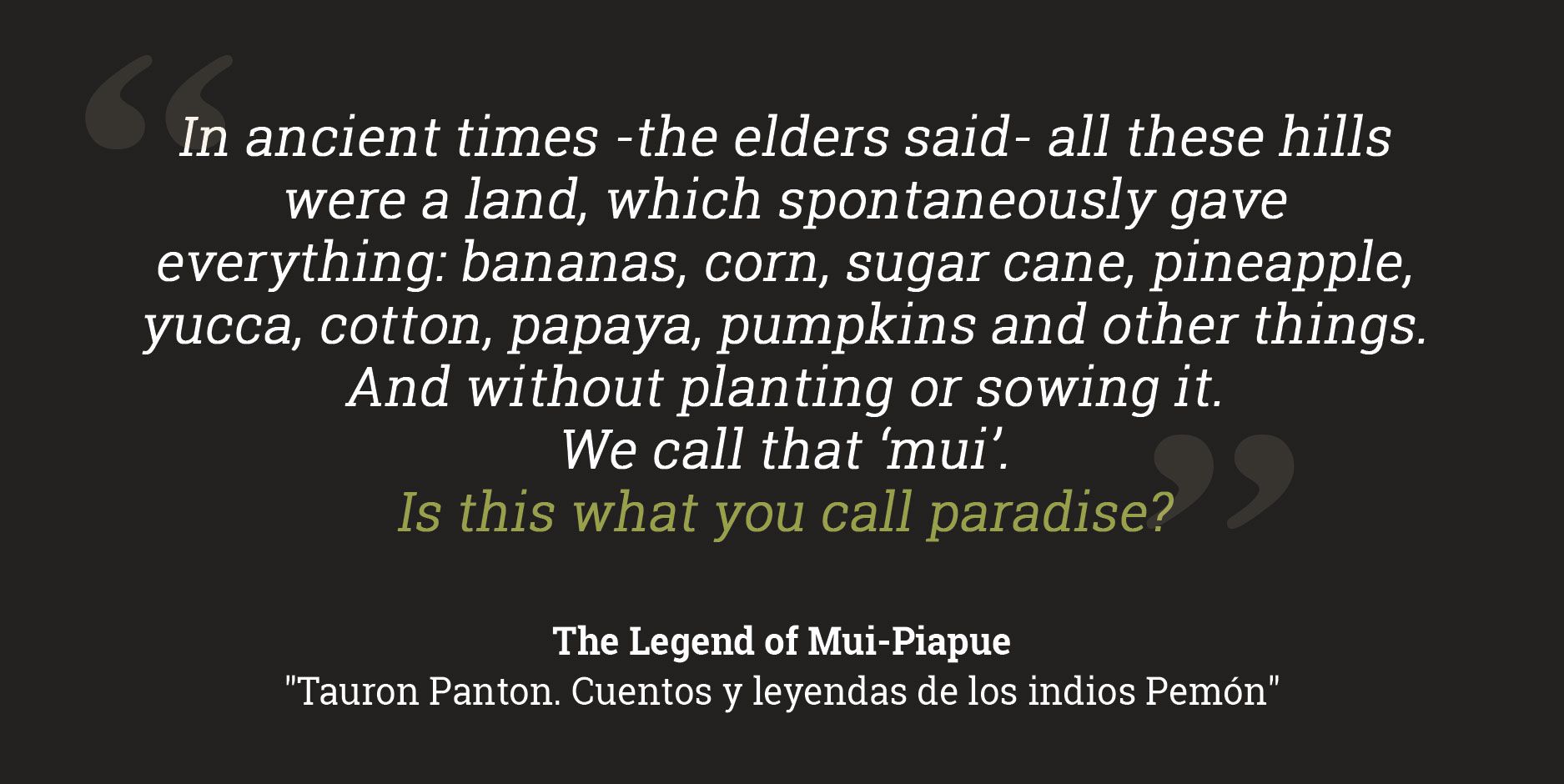
Blood and the tepui
A military attack allegedly planned in a luxury lodge
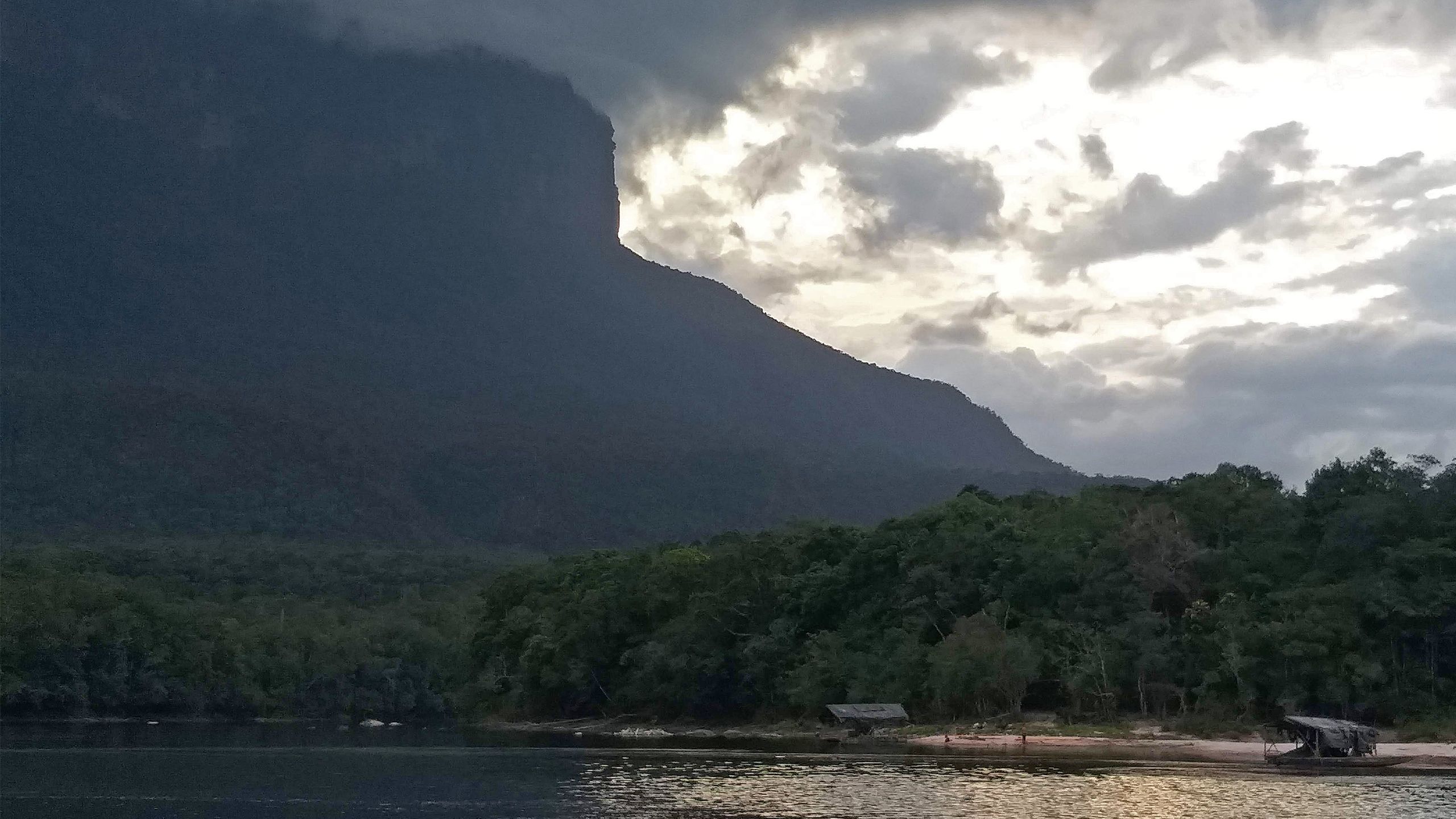
“That’s where everything was orchestrated”, says a Pemón tour guide when reminiscing about the day in which for the first time Canaima felt the corrosive smell of tear gas and the bursts of gunfire. The place he is referring to is Ara Merú Lodge, a camp which according to the locals was built in a record period of two years and is described in travel reviews as the most modern and luxurious lodge in the area. This was also the lodging place of 20 officers of the General Directorate of Military Counterintelligence (DGCIM) who on December 8, 2018 entered the national park’s mining area and shot a Pemón indigenous man to death, wounding another two. This was known as “Operation Tepui Protector”.
Unlike other hotel lodges in the area of Kanaimó –the capital of Sector 2 in Pemón territory- Ara Merú Lodge is the only one surrounded by high shrubs. It has a single entry, giving it a greater sense of privacy in comparison to the others. In order to get in, one has to go through a stone arch covered by a water curtain, a sort of recreation of the nearby waterfalls. And unlike the others, it counts with a pool, a gym and a cement replica of Angel Falls.

Ara Merú Lodge is the most luxurious camp in the area. Photo: Lorena Meléndez G.
Ara Merú Lodge is the most luxurious camp in the area. Photo: Lorena Meléndez G.
The reason why these officers stayed at Ara Merú Lodge has always been noted by the residents of Kanaimó and Kamarata. They claim that this is where the military tends to stay when they travel to one of the most expensive tourist destinations in Venezuela (at a cost of around $600 per person). Only a fraction of the country’s population can stay here. In Venezuela more than 45% of its inhabitants eat less than three times a day according to market research companies such as Delphos and Consultores 21.
There is an additional key piece which has gone unmentioned. The owner of Ara Merú Lodge is César Leonel Dias González. He is wanted by the Venezuelan authorities since June 2018 when the government published a list of people linked to gold smuggling operations. His involvement in these operations has been known since August 2016, thanks to his relation with another company: Transporte Aéreo del Sur (Transur, C.A.) which, according to the Public Prosecutor’s Office, has smuggled the golden mineral to countries such as the Dominican Republic, Curacao and Aruba.
The DGCIM officers arrived at Kanaimó on December 7, a day before the attack of the indigenous miners. They registered with fake identities, passing off as tourists. Their weapons were secretly smuggled into the National Electric Corporation’s (CORPOELEC) facilities. Witnesses claim that the DGCIM officers celebrated their supposed holiday with whisky on the banks of Canaima Lagoon. At dawn, 18 of them climbed into two curiaras (dugouts) and went on an expedition along with a group of Pemón indigenous men who drove the boats and acted as tour guides. The plan was to reach Kerepakupai Vená, better known as Angel Falls. But this is not what happened.
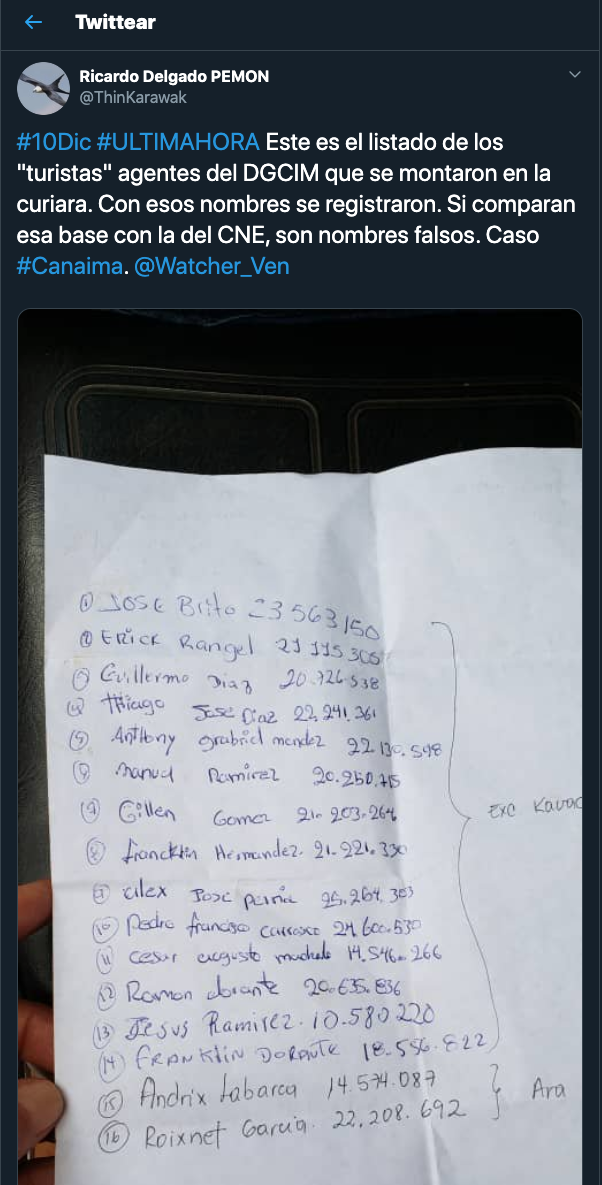
The list of a used by DGCIM officers during the “Operation Tepui Protector” Photo: Ricardo Delgado.
The list of a used by DGCIM officers during the “Operation Tepui Protector” Photo: Ricardo Delgado.
En route through the Carrao River, and right before the dugouts steered into the Churún River which leads to the enormous waterfall, the undercover military officers seized control of the dugouts and the crew. “They kidnapped the men and gave orders to take them to the mining zone. They were armed up to their teeth (…) and had ranged weapons”, says Gregorio Rivas, owner of Morichal Camp in Canaima in an audio uploaded onto the Instagram account @CanaimaSeRespeta.
Arenal in Flames
A score of gunshots can be heard throughout the minute-long video taken by a man inside one the dugouts, its blasts echoing throughout the jungle. The image is shaky as he tries to point his cellphone towards the bow of the boat, catching glimpses of the mighty and dark Carrao River. In the background, the permanent noise of the motor’s engine mixes with the breeze hitting hard on the cell phone’s microphone. One of the crewmen yells: “Go, go”, while the black jacket of another fills up with air. Seconds later, only the rugged and damp walls of the wooden boat can be seen. Lifting one’s head in the middle of the gunfire is not safe. Thus begins one of the recordings of the “Operation Tepui Protector”.
At this precise moment, however, everything is confusion. Orders are given and caution is implored. “Hands up, hands up”, repeats a man who seems to be inside the large canoe. “Hold on, hold on… Careful, careful”, says another of the voices amidst the gunfire. The boat comes to a halt the engine is turned off.
Finally, the camera focuses on what is happening: the dugout has reached a makeshift barge. Standing there, are Pemón miners, wearing flip flops, shorts and sleeveless shirts. This is the same outfit worn by all of those who extract the golden metal around the Orinoco Mining Belt and by men in Canaima who speed through the Carrao River every day to get to the mines and open-air pits. Today is no exception, yet the atmosphere is different. The volley of gunfire does not cease.
The video’s description states that this was the moment when indigenous peoples defended themselves against an attack committed by “Criollos” –which is how this tribe refers to non-indigenous peoples- against Pemón miners working on the mines of the Arenal sector, near the Auyantepui tabletop where Angel Falls is located. According to several sources, there were many Pemón men carrying rifles and arrows during the attack. Yet only the indigenous men were wounded. One of them, a 21 year old man named Charly Peñaloza was fatally shot by a bullet. His brother, Carlos Peñaloza, 25, and César Sandoval were wounded.
Arenal is a sector of the Carrao River which used to be a mining area 60 years ago until Canaima was declared a national park and tourism became the main economic trade throughout the Gran Sabana Municipality. Today, amidst the economic and social debacle ravaging Venezuela, Arenal has gone back to its roots. Wooden rafts used for mining float by on the banks that face the Wei Tepui. All of them possess a hose used to dredge the river’s sand in search for gold. These form sediment banks which pull through the surface and have to be dodged by boatmen during their navigation on the river. Tourist camps nearby are filled with hammocks belonging to local miners. Even the nightly concert of frogs, toads, birds and insects which begins at sundown has to compete with the buzzing noise of water pumps and the constant presence of indigenous men seeking for the precious metal in the banks of the Carrao River.
When the DGCIM arrived at Arenal, the miners where changing work shifts, says Carlos Somera, delegate of the Commission of Inter-Institutional Alliance ascribed to the Council of General Caciques of the Pemón Peoples. Mr. Somera led the investigations of this case. According to him, the miners working the night shift had just left when the DGCIM arrived, pointed their guns to the morning shift workers, told them about the operation and ordered them to abandon the site immediately. The Pemón men reacted to the situation.
“Our brothers confronted the men verbally”, explains Mr. Somera, also an indigenous man, who insists that none of the Pemón had weapons on them at the time. He claims they approached the officers, demanding explanations and hoping to prevent any damage to the barges. Instead, they received a shower of bullets which wounded three of them on the legs.
At that moment, the Pemón made an unexpected move. Several of them dived into the Carrao River and surprised two officers standing on a raft from behind by pushing them into the water.
According to Mr. Somera, one of the DGCIM who fell almost drowned while the other was immobilized when they took his knife and pointed it to his neck. In the end, the Pemón defeated the officers by taking several of them as hostages. The majority of the officers escaped through a nearby brook. They were presumably rescued at a later time by aerial means.
Several Pemón men who were present during the incident claim that the operation was much more violent. “They (the DGCIM) arrived on a dugout. On the other side, where that stone slab is, was a helicopter belonging to CADAFE (the region’s former electric company) who shot my brothers”, says a Pemón man while signaling the rocky formation that stands out from the borders of the river and which served that morning as an improvised helicopter landing spot. He also points out to the location in front of the slab where his “brothers” –among them women and children- ran off to take shelter in the depths of the jungle.

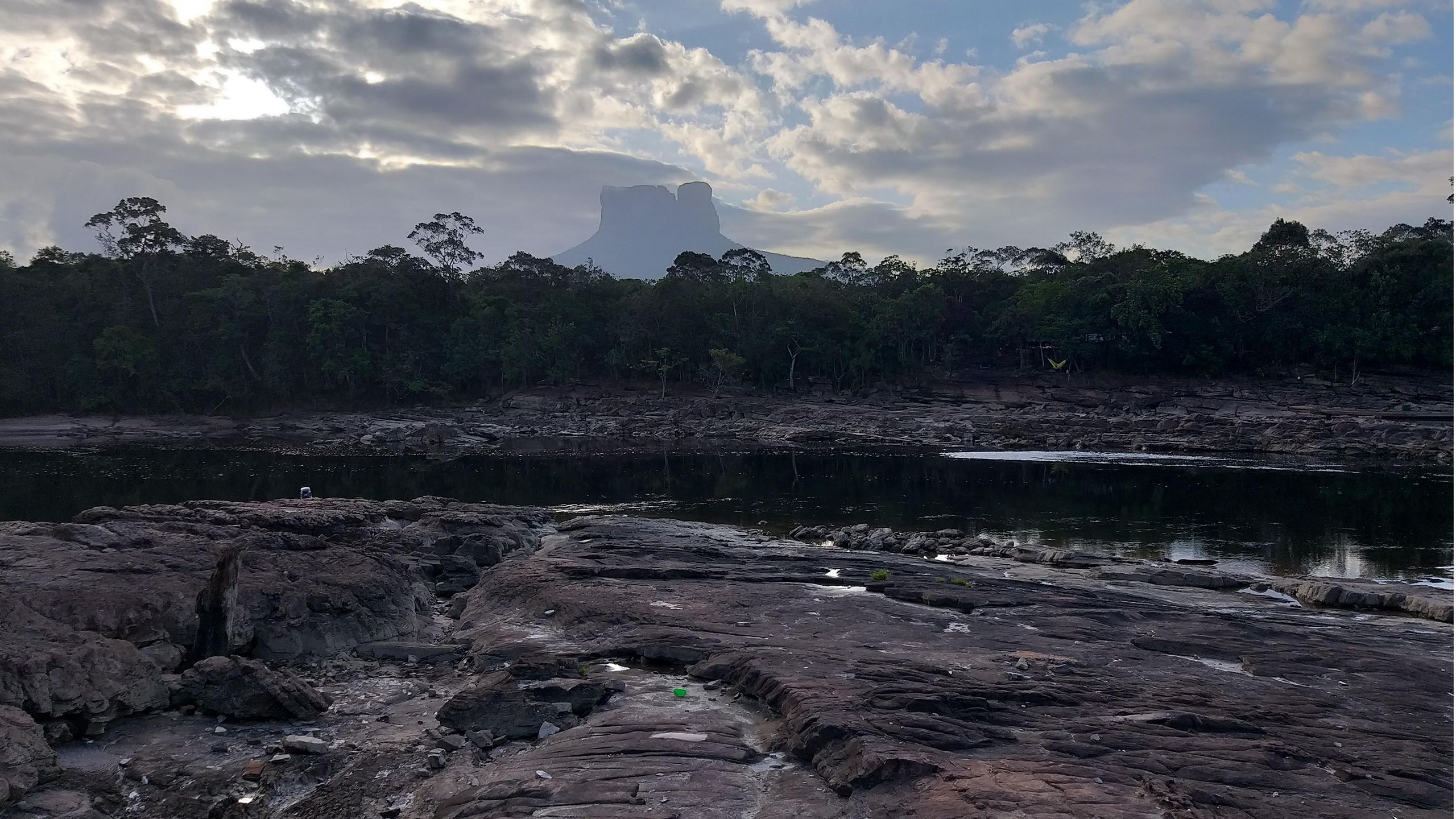
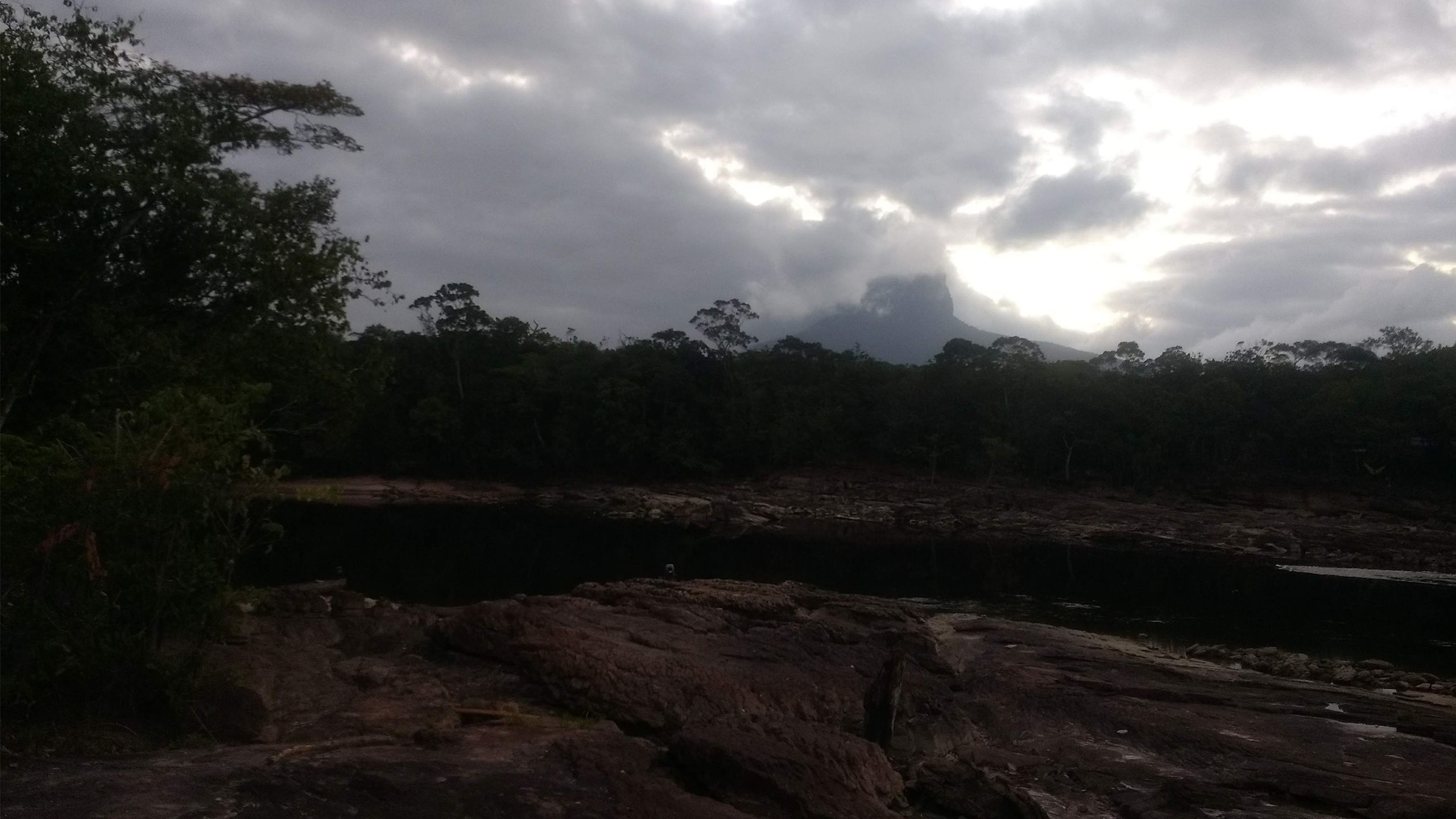

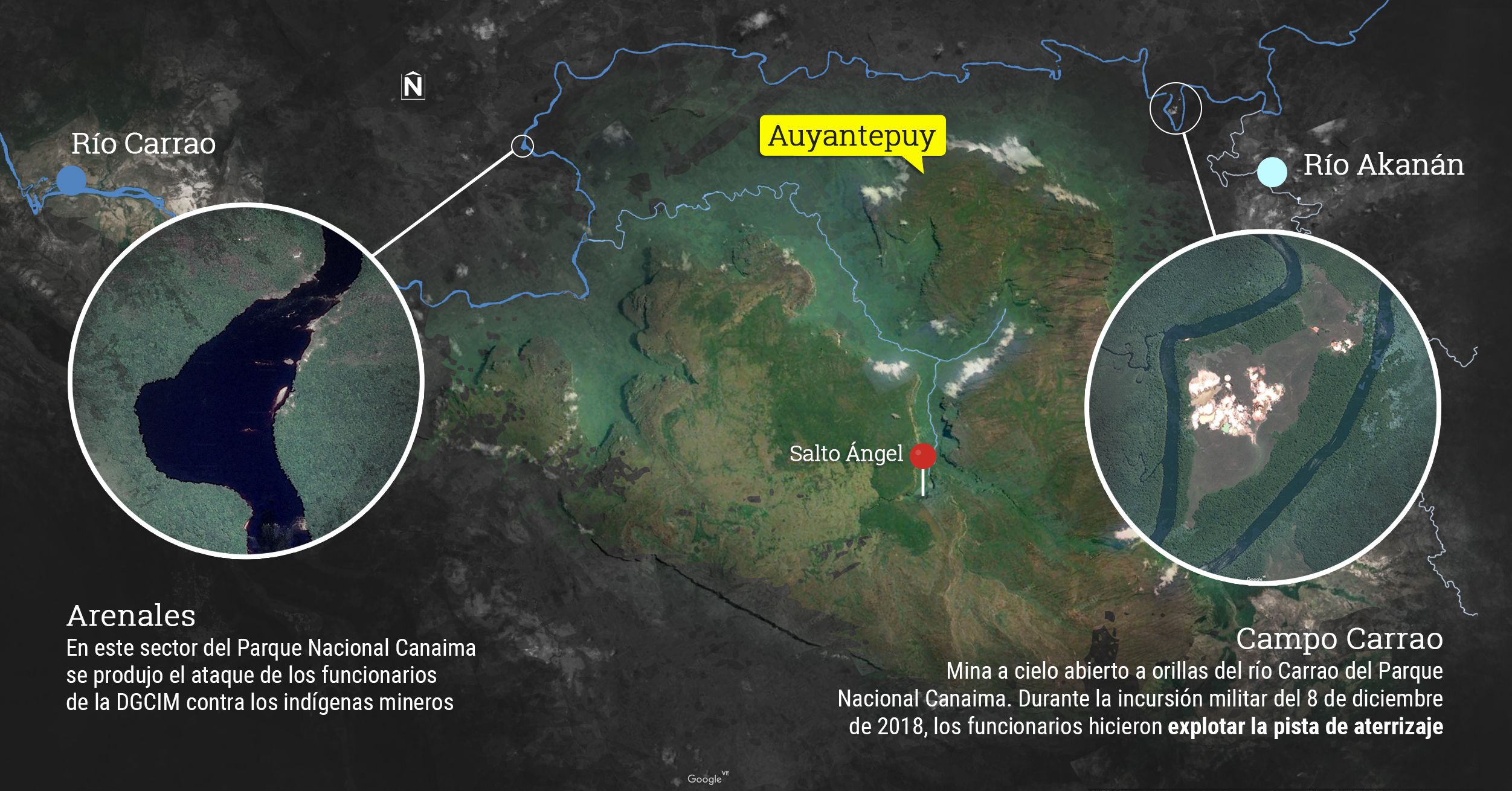
The recorded testimony of Carlos Peñaloza, one of the wounded men, coincides with this last version and reconstructs part of the situation taken place at Arenal. Lying on a hospital bed, he described in Pemón language what had happened the day after he got shot:
“There were 14 to 20 men. My brother and I approached them confidently and we got shot. After that, my other “brothers” (Pemón indigenous people) got upset and the rebels called a helicopter and our men forced the rebels to land the helicopter under one condition”, he says.
He aquí el testimonio de Carlos Peñaloza,pemon sobreviviente al ataque del DGCIM donde desmiente la presencia de otros armados que no sean los funcionarios del Régimen,capitaneados por Alexander Granko (DGCIM)el mismo que asesinó a Óscar Perez.(idioma pemon)traducción en el hilo. pic.twitter.com/8jFcBA7X0U
— Americo De Grazia (@AmericoDeGrazia) December 9, 2018
That condition was to free the officers detained by the indigenous people in Arenal. Peñaloza calls the DGCIM “rebels” because during the first hours, the Pemón men thought that the attack had been led by the mafia groups who are usually behind the business of Venezuelan gold: armed gangs or the guerrilla.
The aforementioned helicopter also flew by Campo Carrao, the open-air pit which is a few miles from the mouth of the Akanan River, north of the Auyantepui. This is the place where indigenous men board the boats that take them to the mines. The helicopter landed there and dynamited the entire airstrip but its occupants were detained by the Pemón miners who happened to be working there at that moment.
At the time of the ongoing shoot-out, a mass ceremony in the small stone and cement chapel at Kanaimó had just begun. It was December 8, and the villagers were celebrating the day of the Virgin of the Immaculate Conception, their patron saint. When the choir was singing the Marian hymns, the ceremony was interrupted by the arrival of the Pemón men who were wounded in the mining zone. Charly Peñaloza died a few hours later after being taken to Puerto Ordaz. It was 8:00 in the morning.

The Church of Our Lady of the Immaculate Conception. Churchgoers where gathered here when the undercover military attack in Arenal occurred. Photo: Lisseth Boon.
The Church of Our Lady of the Immaculate Conception. Churchgoers where gathered here when the undercover military attack in Arenal occurred. Photo: Lisseth Boon.
By mid-afternoon, the officers returned for the miners who had escaped. They threw tear gas at the villagers. Most of them recorded videos which they uploaded to their social networks to alert the situation. And although news became viral throughout the country, indigenous leaders confiscated all of the evidence later on. Today, this evidence is in the possession of Domingo Castro, the General Cacique of Sector II, who refuses to comment on the incident.
“This is a matter which our community has tried to make up for, not dwell upon. In consideration, I feel that talking about this again is not wise. It is a high-profile topic and I’ve been working hard so that this painful moment that we lived as a community and the fear my brothers felt at the time remain solely as a bloody chapter in our history which will never happen again”, he responded to Runrun.es via a WhatsApp message.
Mr. Somera is certain that the DGCIM had chosen the date of the Patron Saint to attack because they believed that the entire Pemón community would attend the church celebrations that morning and that only Brazilian miners –the operation’s alleged target- would be at the mines. When they arrived there, only the Pemón miners were to be found. Even today, the “Criollos” are not welcome in the mining area.
The story that played out in the Venezuelan digital media differed from the actual events. Although they later corrected by saying that the officers had entered the territory in a violent manner and shot against the aboriginals, the first headlines stated that there had been a confrontation in Canaima between the Pemón People and the DGICIM, resulting in the death of an indigenous man.

El Universal and 2001 reported the incident as a confrontation.
El Universal and 2001 reported the incident as a confrontation.
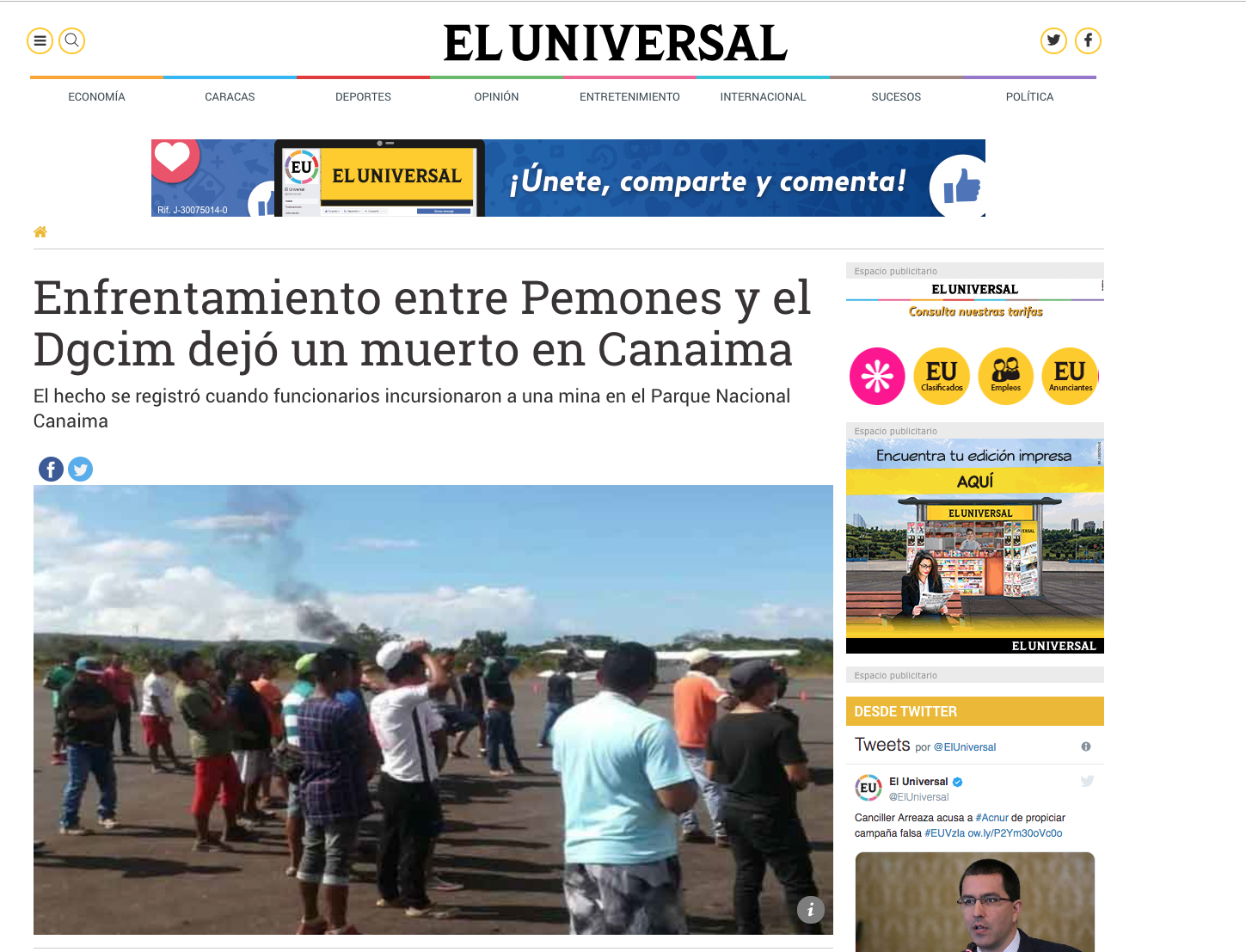
This version was backed up by the Minister of Defense Vladimir Padrino López who finally addressed the Arenal military attack on December 11, 2018. Joined by Remigio Ceballos Ichaso, Commander General of the Army, Padrino López ratified that the operation was part of a plan entitled “Tepui Protector”, an operation created by the Maduro administration to end mining inside Canaima National Park.
“There was a confrontation, there were weapons involved, and they aimed against this commission (…) and the result of this exchange, of this confrontation in the area was four men wounded with firearms. Regretfully, one of the four died and we deeply condemn this action from the bottom of our heart”, explained Padrino López in a televised address without mentioning that the victims were members of the Pemón tribe. He later stated that the DGCIM officers were evacuated from the site, although three of them were still held under custody by the indigenous men. He also said that the wounded were quickly taken to a hospital in Ciudad Bolívar, capital of Bolivar, contradicting Congressman Americo Da Grazia’s claim that they had been taken to several other medical dispensaries before being taken to the hospital.
In this same address, Padrino López assured that several makeshift barges were destroyed during the operation and he pointed the blame towards “international mafias” with economic power who were seeking to turn indigenous people against the government.
The Minister of Defense’s affirmations got an immediate response from the indigenous people of Canaima. In a public statement endorsed by the General Council of Caciques, they denied the confrontation Padrino López had referred to and questioned that he addressed the issue four days after the incidents. They called him a coward, a colonizer, thief, cynical, liar, ignorant, a charlatan and a murderer.
Lucy Rossy, Secretary General of the General Council of Caciques reads the statement.
“You plead for dialogue and justify this operation with basis on the Constitution. Isn’t murdering an indigenous man in a military operation a violation of the Constitution? Does a military operation constitute dialogue? (…) Who mistreated the indigenous people and who took away their belongings? (…) You must resign. The Bolivarian Armed Forces are the protector of its people, not its henchman nor its murderer”, said Lucy Rossy, secretary of the Council in a statement read at a press conference which went viral.
Pemón Jurisdiction
Hours after the attack, the indigenous people had taken actions to condemn the incidents. The Council of General Caciques had declared seven days of mourning throughout the Gran Sabana Municipality, suspended elections for city councilors in its jurisdiction –these elections were set to be held throughout Venezuela on December 9 -, announced an indefinite stoppage in all the communities within the area, and closed ports, airports and roads. They also held the State accountable for the events and demanded an investigation on Peñaloza’s death as well as an explanation as to why was he transferred from a private clinic to a public hospital.
While they were making the aforementioned statement, the Pemón people were interrogating the alleged perpetrators: the two DGCIM officers who were caught at Campo Carrao and an additional officer that the Bolivarian National Guard had under its custody at Kanaimó. Up to this moment, they ignored that they were undercover military men, as they thought they were members of the militia or the guerrilla.
The decision to interrogate them was based on the application of special indigenous jurisdiction, a legal provision contained under the Organic Law of Indigenous Peoples and Communities, which grants them the power to solve all conflicts generated in their territory in an autonomous manner.

The special indigenous jurisdiction became active on December 10, 2018 two days after the Arenal events. This was established in the “Preliminary Report by the General Council of Caciques of the Pemón People on the armed attack in Canaima”, which declared the opening of the case with the testimonies of eyewitnesses, the integration of a commission which would verify the events on site and search warrants in Ara Merú Lodge (where the military men stayed) and the National Electric Corporation (CORPOELEC) in whose heliport the aircrafts carrying the agents landed. Likewise, the Pemón people decided to revoke the custody of the suspect to the Bolivarian National Guard in order to question him and arrested two workers from the electric industry identified as Édgar Velásquez and Luis Malpica. The case would be trialed and sentenced by the indigenous people and notifications of this action were sent to the Ombudsman’s Office.
The following day another public statement was issued, this time announcing blames. The Council of Caciques held the Maduro administration responsible for the “undercover military style operation” which looked to “render the Carrao River miners equipment unusable” and left one man dead and two wounded “with weapons belonging to the Republic”.
The statement also accused several DGCIM officers of being masterminds of the operation. Among them, its director the General Iván Hernández Dala; Major Alexander Granko Arteaga, Commander of the Special Affairs Unit; and Major Rafael Antonio Franco Quintero, director of Investigations at DGCIM. All of these men have been sanctioned by the government of the United States following the death of Captain Rafael Acosta Arévalo, presumably murdered according to his family and attorneys in June 2019 after being tortured while he was detained. According to the public statement, the military men plotted the operation together with “21 troop members and explosive expert officials” with the complicity of the then Minister of Electric Energy, Luis Motta Domínguez, who facilitated the use of CORPOELEC’s headquarters and aircrafts in Kanaimó, as well as the Bolivarian National Guard.
The indigenous special jurisdiction has also allowed the Pemón people to take measures in regard to every “Criollo” who enter Canaima. Nowadays, any person entering the park must submit to a mandatory luggage check. Local mistrust avoids referral to the Arenal events. According to guides, tourist expeditions through gold mining areas of the Carrao River must be approved by the miners who work there. Military immersion in Canaima has created rivalries and resentments. The “Tepui Protector” operation proved to be the exact opposite of what its name entails: it managed to make the aboriginals feel as vulnerable as they feel jealous about their territory.
Although the events in Canaima were widely spread in the news, only two indigenous communities from Sector 2 publicly condemned the incident. One of these communities was Urimán, where mining has been practiced openly for decades. One of its members reiterated that his people would not give up even a foot of their lands.
The other community was Kumarakapay (San Fransico de Yuruaní) where the former major of Gran Sabana, Ricardo Delgado, went on camera to express his support to his fellow countrymen in Kanaimó. “(These) are clear actions that the Government is taking to evict us from the mining zones”, he stated on December 8. Ten days later, the former public officer read a letter in Pacaraima, Brazil where he denounced the military operation and its consequences in the UNHCR humanitarian camp, set up in that city to aid Venezuelan immigrants. Incidentally, Kumarakapay was the scene of an incident occurred on February 22, 2019 when Army officers attacked indigenous people in the area who were expecting the entry of humanitarian aid announced by the leader of the National Assembly and interim President of Venezuela, Juan Guaidó. On that day, the smell of tear gas was felt again in the land of the tabletop mountains. Four members of the Pemón tribe were gunned down.
En el documento, explican que su acudida a instancias internacionales (en este caso ACNUR servirá de enlace ante la ONU) se debe a la ausencia del Estado de Derecho en #Venezuela. pic.twitter.com/ZommCARqGX
— Dr. Jekyll & Mr. Hyde (@DrJ_y_MrH) December 18, 2018
A silent plan
Months before the armed attack, the Maduro administration met on several occasions with the Council of Caciques to discuss mining operations in Canaima as well as the plans needed in order to get indigenous miners to abandon the illegal activity.
Although claims of mining in the national park go as far back as 2011, the first land and machinery movements were registered in 2018 when several organizations began to echo the environmental hazard going on in a World Heritage Site. In July 2018, the NGO S.O.S. Orinoco published an extensive report on mining activities in the area. Amnesty International issued a statement against the accusations that the Brigadier General Roberto González Cárdenas had given where he accused the Pemón activist Lisa Henrito of leading a secessionist movement in Southern Venezuela when in reality she had only denounced illegal mining in Bolívar.
A 49kms del Parque Nacional #Canaima Patrimonio de la Humanidad @unescowhc, mineros ilegales devastan el Rio Supamo con #Mercurio, #cianuro y otros contaminantes, mientras #FANB y @CAMIMPEG_FANB se benefician y son cómplices de la destrucción. https://t.co/FXgGjkxHyQ #SOSOrinoco pic.twitter.com/1kHjFDAnlF
— SOS Orinoco (@SOSOrinoco) March 4, 2018
The first of these meetings regarding illegal mining between the government and indigenous leaders took place on October 5, 2018. According to several publications on official Twitter accounts, Remigio Ceballos Ichaso, the highest authority of the Operational Strategic Command of the Bolivarian Armed Forces (CEOFANB); the Minister of Culture, Ernesto Villegas Poljak; the Minister of Indigenous People, Aloha Nuñez; the Minister of Eco Socialism (formerly Environment), Heryck Rangel; and the Minister of Ecological Mining, Victor Cano, sat down with the Caciques to discuss protection measures for the park. “Integrating winning”, said a message published by CEOFANB on its social media, on occasion of that meeting.
En Parque Nac Canaima, Cmdte @ceofanb AJ @CeballosIchaso, Min @VillegasPoljak, Min @AlohaNueez y Min @vcano75 se reúnen con representantes de Etnia Pemon, para temas inherentes a la protección del Parque Nac y acciones para atacar la minería ilegal. “Integrar es vencer” pic.twitter.com/lCpmMAssra
— CEOFANB (@ceofanb) October 6, 2018
However, a source present at that meeting claims that the government’s real intention was either to provide the Pemón with equipment to continue mining operations or incentive them to work in the area’s lumber industry. The latter had been tried in the Sierra Imataca region which covers part of Northern Bolívar and Southern Delta Amacuro. According to this source, there was never any real intention of putting an end to mining.
The following day, the Pemón people went to a meeting with the Minister of Tourism, Stella Lugo, who visited the national park to inspect Venetur Canaima, a State owned vacation lodge which had recently undergone renovations. Lugo taped an interview there for a television program broadcasted by the State owned Venezolana de Televisión (VTV), in which she announced that Venezuela would participate in the World Travel Market trade show in London. “This is a unique tourist destination. The world is born here. The kindness of its inhabitants is evident in this place and they use their culture to enamor tourists”, she said in the interview. However, she never mentioned a word in public about her conversations with the Pemón indigenous peoples.
A source claimed that Lugo promised to reactivate tourism in the area. One of the measures she promised was the establishment of an aerial route between Puerto Ordaz and Canaima to be flown by Conviasa Airlines. Until mid-July 2019, not a single airplane of this State-owned company has landed in the area.
Venezuela es tierra de gracia. Desde Canaima, lugar donde nace el mundo, estuvimos inspeccionando las instalaciones del Campamento Venetur Canaima, que en los próximos días abre sus puertas para recibir a nuestros visitantes como nos los ha pedido el Pdte @NicolasMaduro pic.twitter.com/xBSCNjO4Kx
— Stella Marina Lugo Betancourt (@StellaLugoB) October 2, 2018
On October 8, 2018 the indigenous peoples began protesting against the violation of their lands claiming that illegal miners were extracting gold in Southern Bolívar. 10 days of continuous protests followed. Some of the actions they took involved closing a sector of an important trunk road (Kilómetro 67, Troncal 10). This road crosses the mining area and connects the Gran Sabana region (part of Canaima National Park) with Brazil. 22 communities belonging to different ethnic groups joined the protest, demanding provisions of food, domestic gas, fuel and price control on necessity goods. “We are not miners and yet they charge our food in grams of gold”, said one of the protesters to the Correo del Caroní.
Amidst the protests, Valentina Quintero, a journalist specialized in tourism, uploaded photos and videos on her social media that showed mining activates inside the national park. She mentioned the ministers of Eco Socialism, Mining Development and Tourism and demanded that they take action on this depredation of the environment. “There is no mining without fuel. The military controls gas in every border state. You know that better than we do. Get mining out of PNCanaima”, she wrote in one of her tweets.
On October 15, 2018 the Vice Minister of Prevention and Citizen Security, Endes Palencia, confirmed the launch of Operation “Tepui Protector 2018” a plan involving civilians and the military to put an end to mining inside the national park. This announcement led to a statement from the Council of General Caciques of the Pemón Peoples who deemed that this measure was a “political ambush” to their organization.
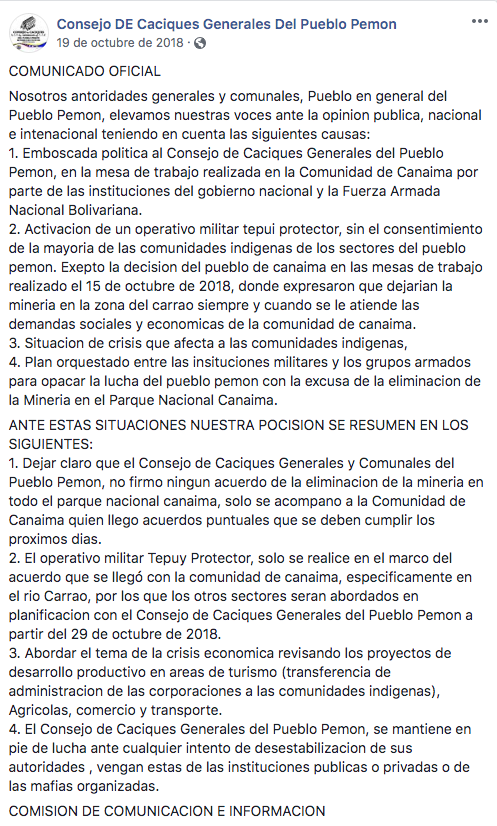
According to the Council, “Operation Tepui Protector” was a “plan orchestrated between military institutions and armed groups to undermine the struggle of the Pemón People with the excuse of eradicating mining in Canaima National Park”. The statement made it clear that the Council of General Caciques of the Pemón Peoples had never signed an agreement regarding the elimination of mining across Canaima National Park as they had only endorsed the agreements reached by the community of Canaima. Therefore, the military operation “Tepui Protector” could only be carried out within the framework of the agreements reached by the community of Canaima, specifically in the Carrao River.
On October 31, 2918 the former vice president of “La Salle Natural Sciences Foundation”, Professor Ismael Fernández Díaz, filed a claim in the General Prosecutor’s Office against illegal mining in Canaima National Park. The claim, which includes coordinates of the areas where illegal mining occurs, stated the following: This not only hinders the V Object of the Nation’s Plan 2013-2019 which reads: ‘To preserve life in the planet and save the human species’, it also affects the lives of our fellow countrymen, our children, grandchildren and future generations. If this illegal environmental degradation continues in Canaima National Park, then other complex and already compromised ecosystems will inevitably disappear”.
In his claim, Professor Fernández Díaz also requested that an investigation be opened with the participation of the “Strategic Operational Commander of the Venezuelan National Armed Forces”.
Denuncia de minería en Cana... by runrunesweb on Scribd
Fernández Díaz also claimed that illegal mining activity in the Gran Sabana sector had been promoted and endorsed by the then Mayor Emilio González. A member of the opposition to the Maduro administration, González had condemned being persecuted by the Governor of Bolívar, Justo Noguera, since mid-2018. These claims worsened with the February 2019 military attacks to the indigenous peoples of Kumarakapay for their efforts to get humanitarian aid into Venezuela, which forced González to flee the country. The Governor of Bolívar removed him from office in April 2019, unilaterally selecting former Chavista congresswoman Nancy Ascencio to occupy his post.
Another meeting occurred on November 30, 2018 at the Venezuelan Chancellery. The Ministers of Foreign Affairs, Health, Eco Socialism, Mining Development and several other public officers such as the Attorney General, met with captains of the Pemón peoples to discuss the consequences of illegal mining inside the national park. The highlight of this meeting was a project entitled “A mercury-free Canaima”, led by the office of Jorge Rodríguez, at the time the Minister of Foreign Affairs.
Weeks prior to this meeting, this same plan had taken scientists to indigenous camps to pick up samples of river water in Canaima and test the degree of mercury contamination. On that 30th day of November, after presentations on the effects of mining in the environment, proliferation of malaria, the risks and diseases caused by mercury poisoning, the weak situation of public health in Bolivar and the mobility difficulty of the indigenous communities in Kanaimó due to the rising fuel costs, a decision was taken to request the activation of the “Operation Tepui Protector” against mining operations in the area.
“The militarization of the indigenous people represents a very delicate matter in the international law of indigenous people. It is extremely codified and everything requires a protocol. The way in which it was done is a violation of international protocols”, says Vladimir Aguilar, an attorney on indigenous affairs and coordinator of the Work Group on Indigenous Affairs (GTAI for its acronym in Spanish) at Los Andes University.
Two international treaties ratified by Venezuela establish the protection of aboriginal lands. One of them is the Indigenous and Tribal Peoples Convention (C169) by the International Labour Organization which states under Article 18 that adequate penalties shall be established by law for unauthorized intrusion upon these lands. The other is the UN Declaration on the Rights of Indigenous Peoples which states under Article 30 that military operations shall not take place in the lands or territories of indigenous peoples, unless justified by a relevant public interest. Or otherwise freely agreed with or requested by the indigenous peoples concerned.
“States shall undertake effective consultations with the indigenous peoples concerned, through appropriate procedures and in particular through their representative institutions, prior to using their lands or territories for military operations”, says a part of the article.
Eight days after the meeting in Chancellery, and even though the agreement had been to detain illegal miners and seize their belongings, Charly Peñaloza was killed in an undercover operation
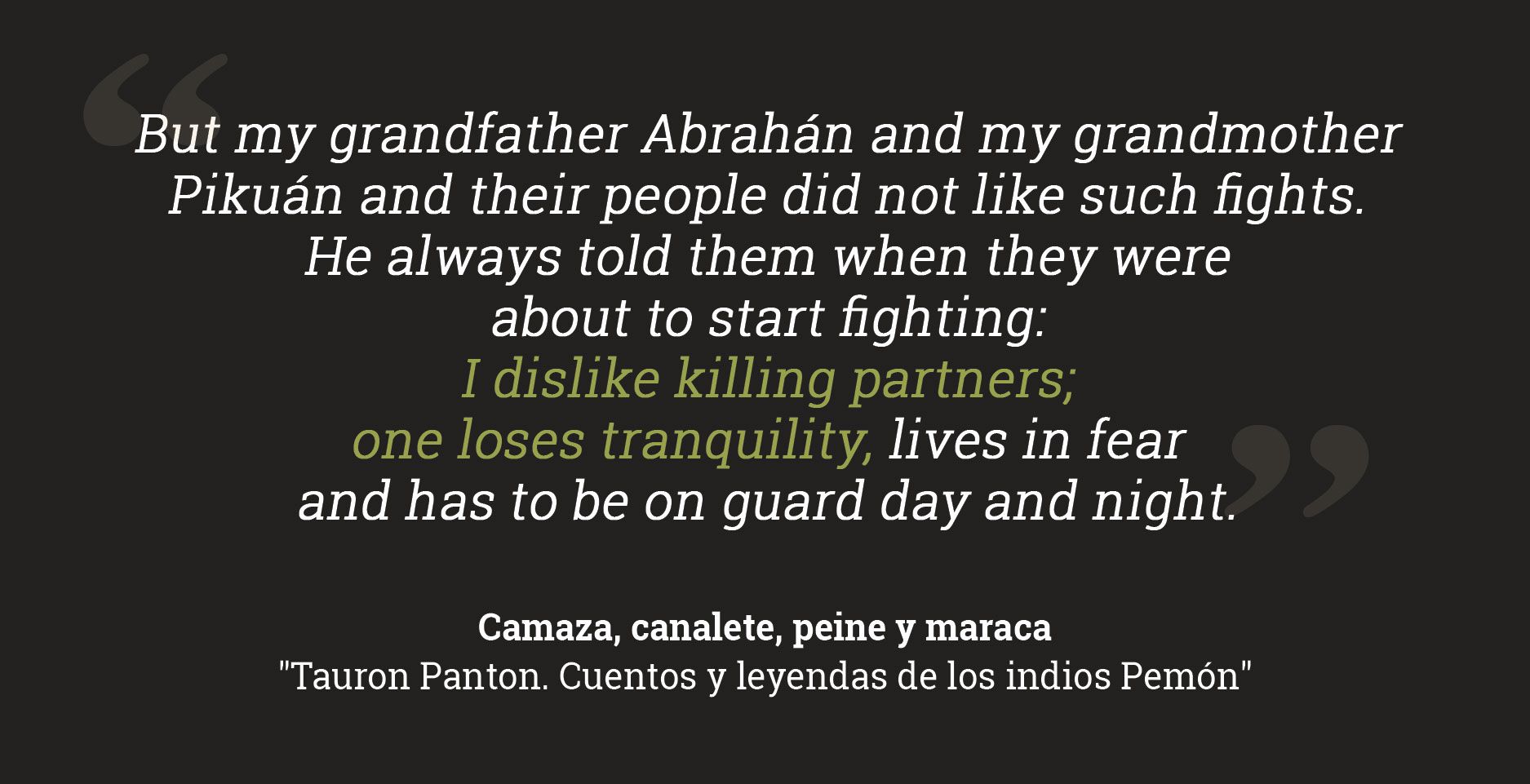
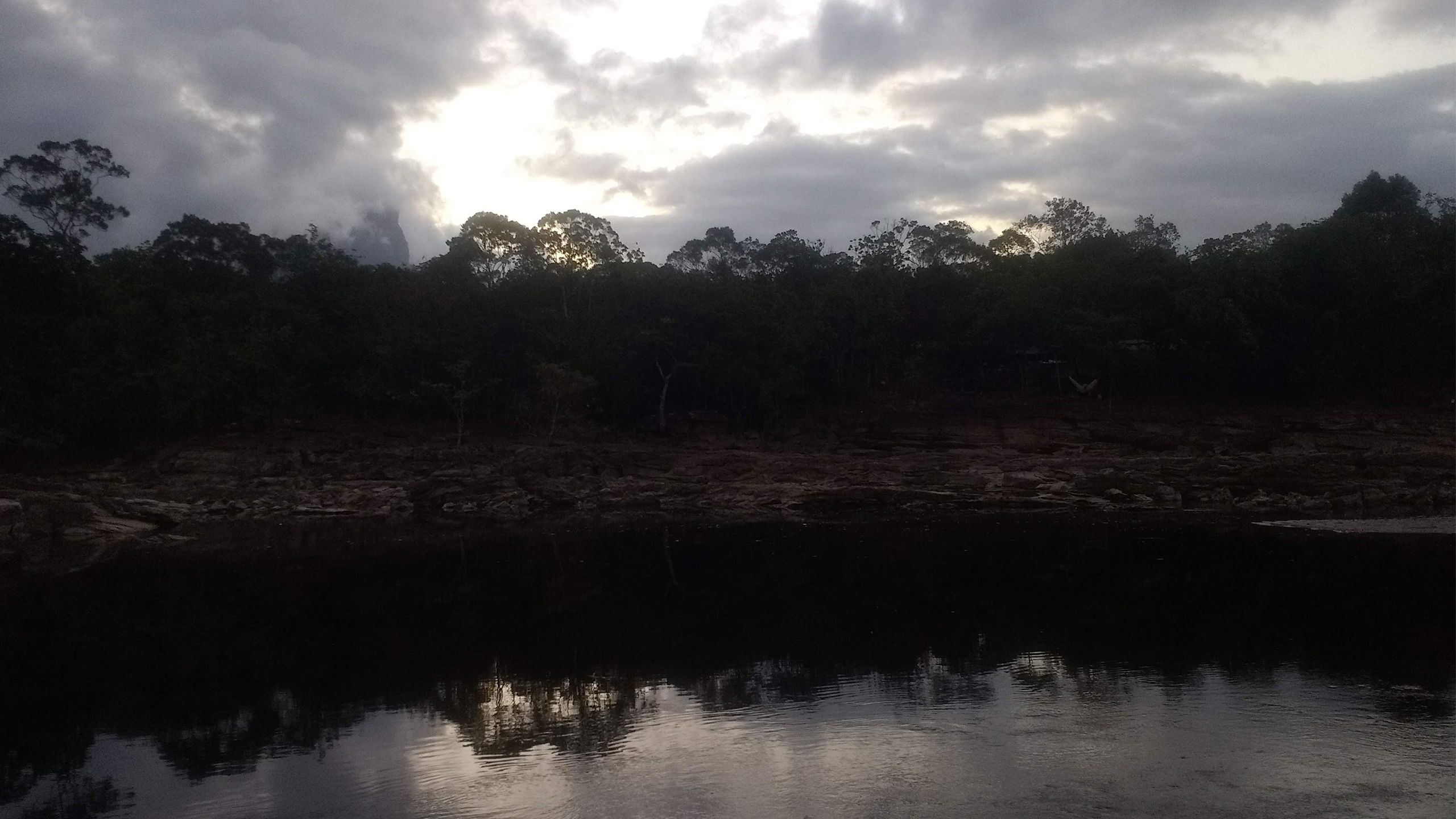





The caciques go after the gold
Indigenous leaders support mining in Canaima
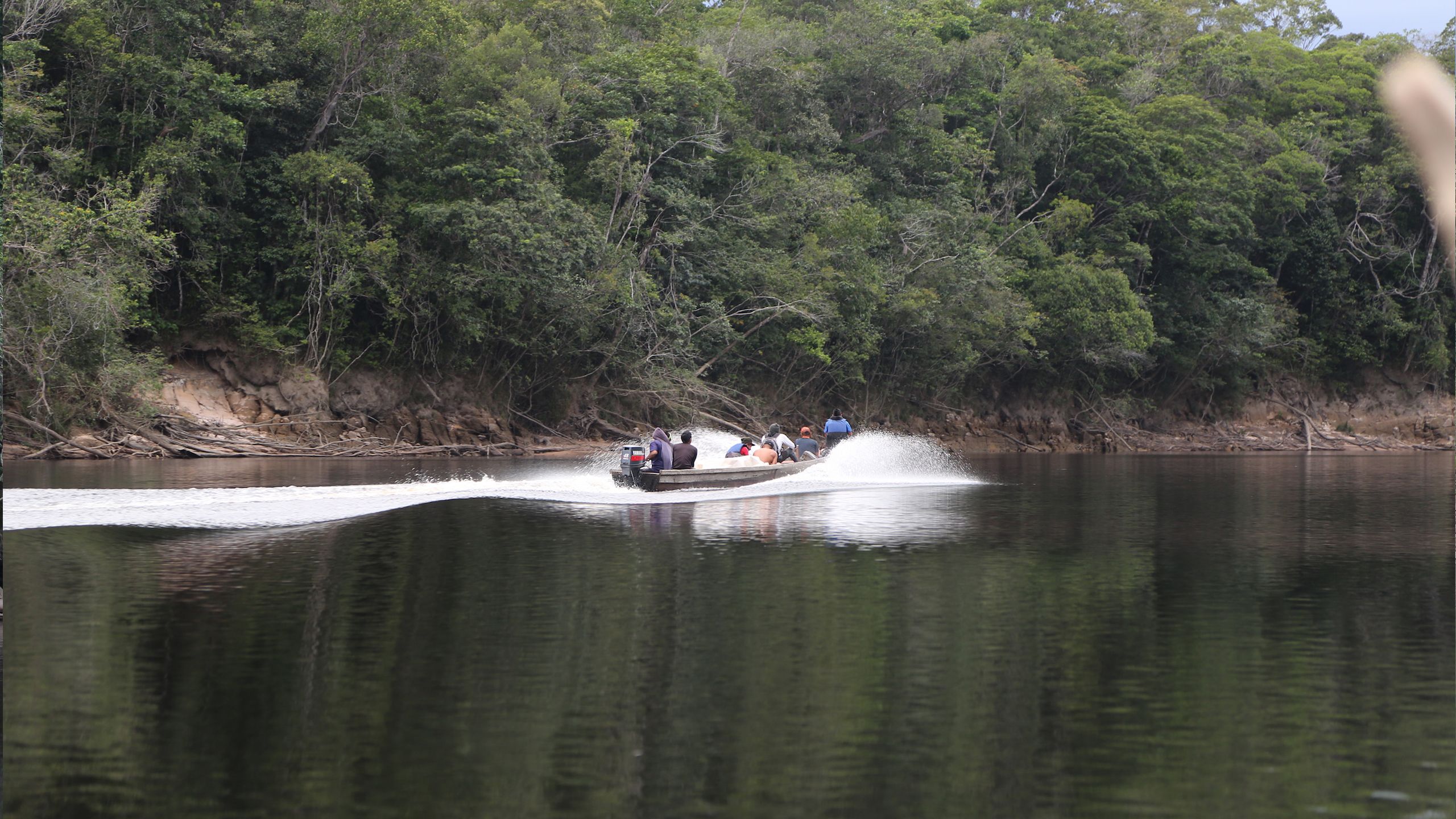
One after the other, the statements released by the Council of General Caciques of the Pemón Peoples, became the logbook of the events that followed the armed attack in Canaima on December 8, 2018. In these statements, the indigenous people condensed all claims, accusations and declarations given by their captains. These written and recorded manifestos lambasted the assault and gave notice of the steps taken to clarify the events as well as hold the State accountable for its actions. The State had just murdered one of their own kind; a young miner who was extracting gold at Arenal, an area not far from the Auyantepui and the Kerepakupai Vená or Angel Falls.
Members of the Pemón community protest against Nicolás Maduro and Vladimir Padrino López
This same fervor was not observed two months later, in the early morning of February 22, 2019, when military officers attacked the community of Kumarakapay in the Gran Sabana (the Western sector of Canaima National Park) for having rebelled and joined efforts to allow the entry of humanitarian aid through the Brazil border, an initiative called for by the government of Juan Guaidó.
A day earlier, indigenous leaders had published a letter in which they took no responsibility over any protest related to the humanitarian aid. However, they allowed their fellowmen to join the protest if they so desired. An extract of this letter reads as follows:
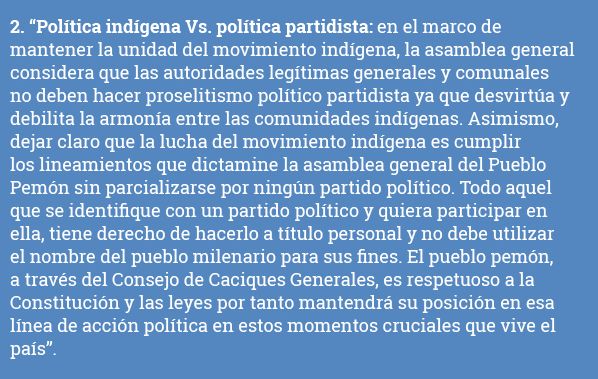
On that February day when uniformed guards shot three indigenous men to death and wounded thirteen others, not a single statement condemning this action was issued by the Council of General Caciques. Only complete silence.
According to several Pemón indigenous people interviewed in Kamarata and Kanaimó, the disparity in the reactions showed between the Canaima and the Kumarakapay events have to do with the existing complicity between the General Caciques and those who have to do with the mining business inside the park. “As long as indigenous leaders can do funny business with higher authorities, this problem will see no end”, says a tour guide who has witnessed how the tourism decline in the last few years has favored the exploitation of the golden metal with the blessing of indigenous leaders.
This blessing seems to have no direct relation to the group’s mission. The Council of General Caciques is composed by six captains that represent six of the eight areas in Pemón territory. 124 communitarian captains act as representatives of each indigenous community in the council. According to their official blog, the council’s object is to: “fight for the restitution of indigenous rights established in the Constitution of the Bolivarian Republic of Venezuela and execute its policy contemplated in the Organic Law of Indigenous Peoples and Communities”.
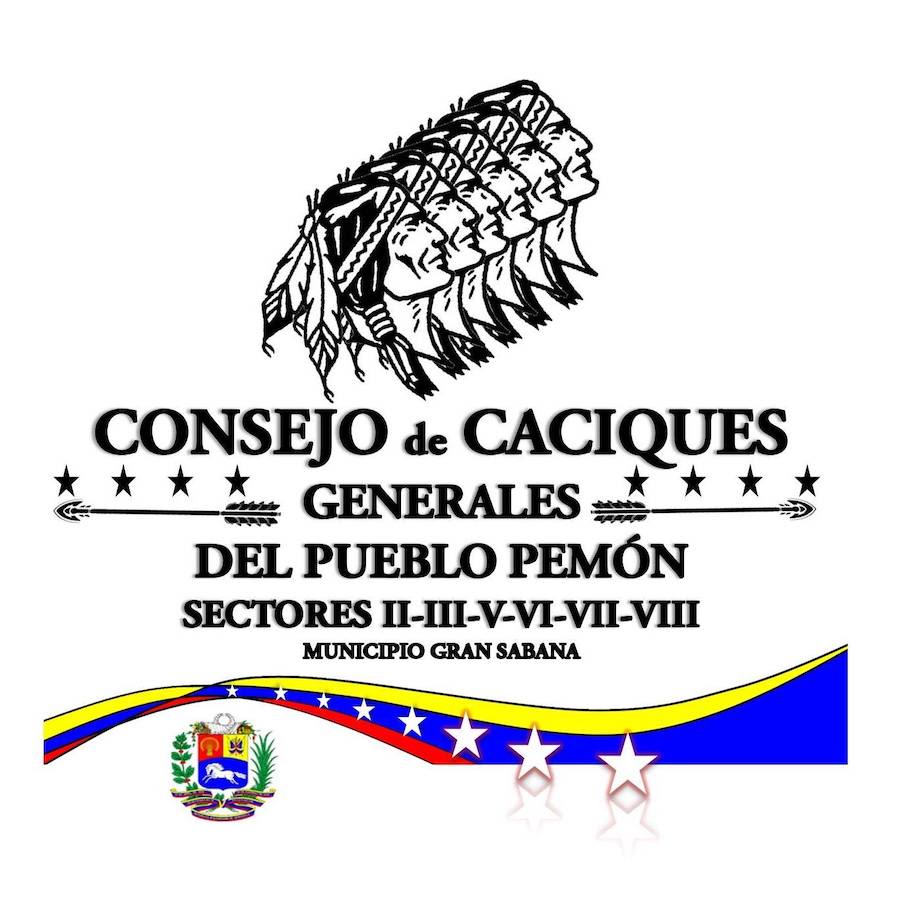
The Pemón indigenous leaders and their relation to mining activity has been evident if we take into consideration the decisions adopted by this council. On November 6-8, 2016, the General Assembly (comprised by the Council of General and Communal Caciques of the Pemón Peoples) convened at the indigenous town of San Antonio Morichal, located at a short distance from the Brazil border, to discuss the “situation of unpermitted mining on the basin of the Caroni River”.

The first thing the General Assembly agreed to in their resolution was the suspension of rafts used for mining in Middle and Upper Caroní River, which is within the jurisdiction of the sectors Ikabaraú, Urimán, Wonken, Santa Elena, Kanavayén and Kamarata. The Carrao River is located in Kamarata where gold is mined on makeshift barges which have not moved from there at any time. On the contrary, they have multiplied. The Arenal camp which borders this river is where the December 2018 military attack occurred.
Although the Council condemned mining on rivers, they did not do so with open air-pits like Campo Carrao, even though it is located inside the Caroní Basin and its sands and mercury are dumped directly into the Caroní River. In this case, the General Assembly established that all mining activities should be conducted at least 1,640 to 3,280 feet away from the tributaries of the second largest river in Venezuela.
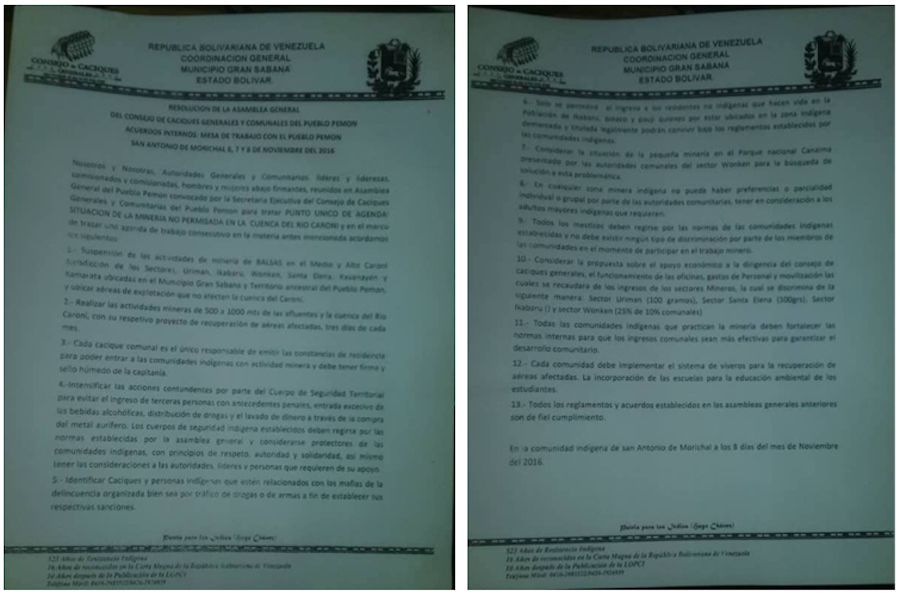
Besides emphasizing the need to avoid the entry of third parties or indigenous peoples who could be associated with “mafias” to the mines, the resolution insists on royalties for the Pemón leaders
Besides emphasizing the need to avoid the entry of third parties or indigenous peoples who could be associated with “mafias” to the mines, the resolution insists on royalties for the Pemón leaders

Carlos Somera, delegate of the Council’s Institutional Alliance commission, confirms the veracity of this resolution but warns that leaders do not receive any royalties from the allocation of these fees. “This should be the norm and yet it is rarely complied with. The ultimate beneficiaries are the people”, he assures Runrun.es on a phone interview as he laughs in a brief and sarcastic manner.
The people do profit according to clause 11 of the Council’s resolution. Indigenous communities are in charge of ensuring that the income obtained through mining be “more effective in order to guarantee collective development”. Incidentally, every community is commanded by a Cacique.
Despite the endorsement of mining operations, the same resolution calls for implementation of greenhouse systems to recover areas affected by gold extraction and that the subject of “environmental education” be taught at local schools. However, parents in Kamarata, Kanaimó and Kavac report that their children wish to work in the mines when they grow up. In Arenal, Pemón adults take their offspring to work on the mining barges.
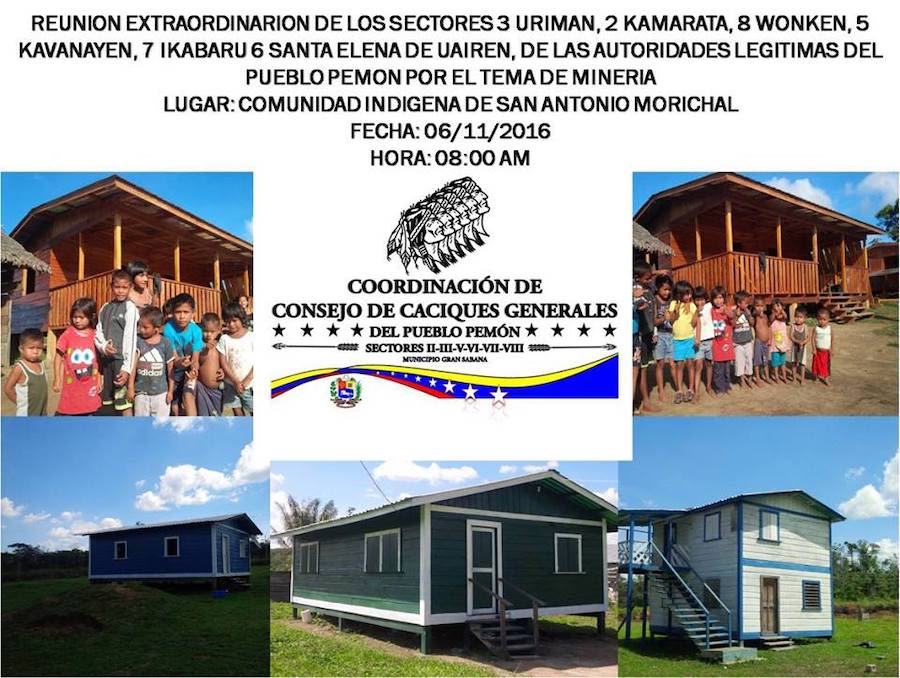
The matter of royalties had already been discussed between the general and communal Caciques in a meeting held in June 2016 in Santa Elena de Uairén. In this meeting they proposed the creation of an “Economic Commission” which would be “under the directory of the Fund for the Development of the Pemón Peoples”, and whose income would be based on the earnings brought in by tourism, agriculture, trade and, of course, mining. The commission would also be responsible for the creation of social programs, investments and the promotion of manufacturing companies which would generate revenues for the fund.
Although the Caciques of the Council are fully aware of gold mining inside Canaima, none of their statements issued in the past year have been aimed at condemning or putting an end to it. For example, an open letter written by the captains on October 4, 2018 questions environmental activists for their fierce criticism of illegal small-scale mining instead of protesting against the recent buildings erected in front of the Kanaimó Lagoon.
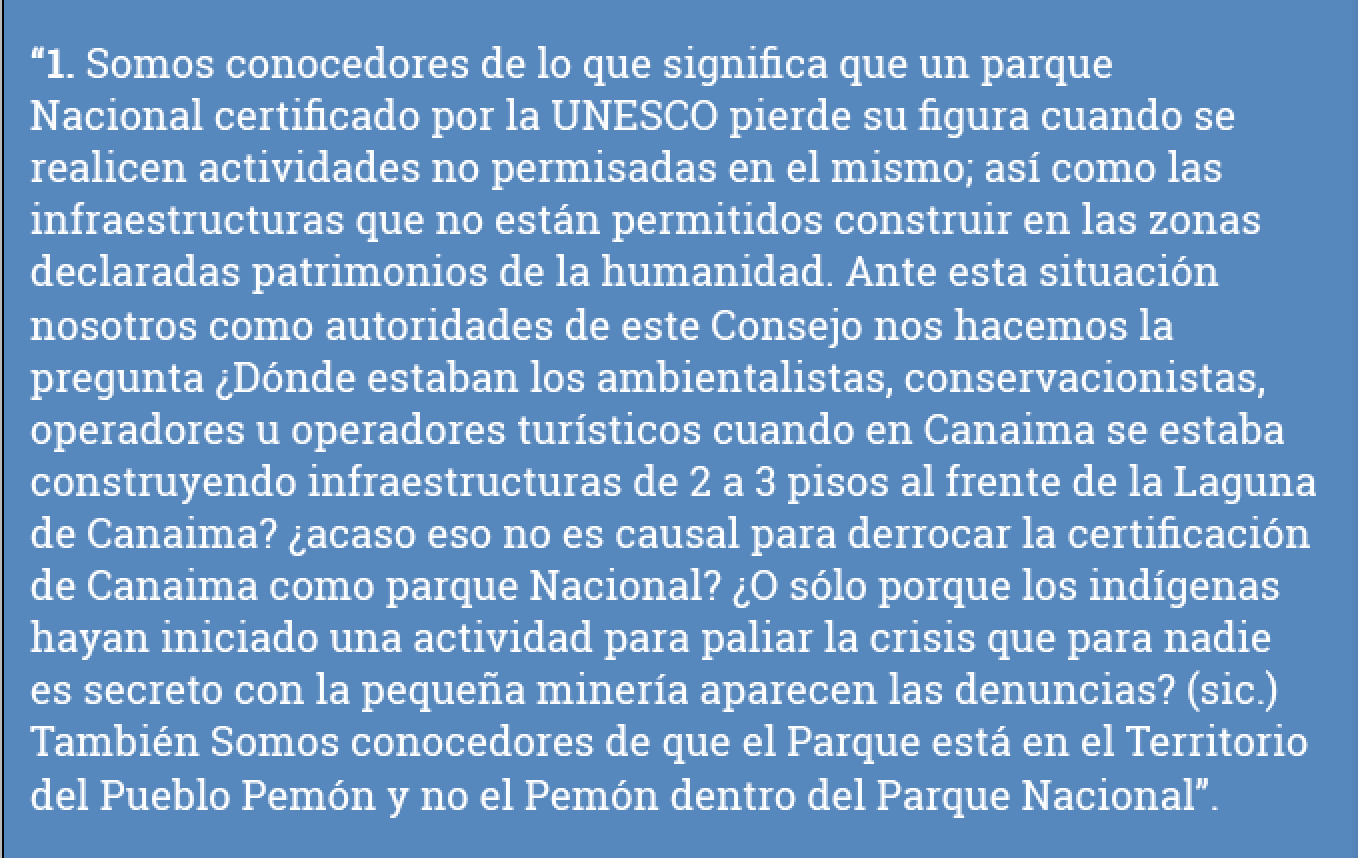
This letter coincided with the arrival of government officials to Canaima National Park. Led by Aloha Nuñez, Minister of Indigenous Peoples and Víctor Cano, Minister of Environmental Mining Development, the group was to meet with the indigenous community to discuss the risk the territory faced of losing the World Heritage Site distinction as a result of small-scale and artisanal mining.
In other matters included in the dispatch, the indigenous leaders limited themselves to claim their role in the management of tourism in Canaima as well as demand the implementation of trades which would allow them to receive earnings alternative to mining.
Juvencio Gómez, former captain general of Sector 6 in Pemón territory (Western Sector of Canaima, Gran Sabana) confirms that in the past few years, the Council has openly supported mining operations.
“They have all visited communities and campaigned about the benefits of the Mining Arc and the special block in Ikabarú (Sector 4 of Pemón Territory)… that’s what they are up to. The caciques have a quota for fuel and machinery as well as full authorization to transport machinery in the mines (…). They negotiate constantly. It’s not going to make them rich, but in times of need everything goes”, he says. Mr. Gómez admits that gold is mined not only in Kamarata (Carrao River) but also in the banks of the Kukenán River and the Roraima tepui, both in Gran Sabana, as well as in Santa Elena and Wonken. He claims that military officers makes round in all of these places, transporting the equipment the Pemón peoples need for gold extraction.
A “loophole”
The Council of General Caciques of the Pemón Peoples was set up in March 2013 as a need to create a governing body which would look after the interests of this ethnic group without any kind of political limitation.
“It was created as a reaction to the partisan cooptation the Federation (Indigenous Federation of the State of Bolívar, FIEB) had since 2008. In 2010, the idea for the creation of this council began to take force in view of the abandonment of local efforts by the Federation and its complicity in government projects in Southern Orinoco which hurt indigenous communities”, says Vladimir Aguilar, an attorney specialized in indigenous rights and coordinator of the Indigenous Affairs Work Group (GTAI for its acronym in Spanish) at Los Andes University.
A similar idea is contributed by Carlos Somera. “When problems arise in the Pemón world such as mining, lack of public safety and clashes with the Armed Forces on mining topics, the FIEB and CONIVE (National Indian Council of Venezuela), who are supposed to be national and regional organizations, never take a stand in favor of the Pemón people because they already have a pact with the United Socialist Party of Venezuela (PSUV for its acronym in Spanish). They are always partial to the party or the government”, says the representative of the Council’s Institutional Alliance Commission.
As a member of the Council, Mr. Somera points out the “loophole” created when the Federation did not take a stand on gold mining or the armed attacks occurred in Las Claritas and La Paragua (both of them indigenous mining territory) which affected the entire tribe.
This statement coincides with several sources in Canaima who claim that the birth and promotion of the Council of Caciques is broadly related to gold mining in Pemón territory. For this reason, says an anonymous source, the majority of its members are in favor of mining. “The Council of General Caciques was born in 2013 with the purpose of organizing the mining activity. They want to know nothing about conservation”, says another source.
Juvencio Gómez says that the main detonator behind the creation of this organization was the arrest of 40 officers of the Venezuelan army in February 2013 by the Pemón people in Urimán as a means of protest against constant abuses.
An article published in the Correo del Caroní reveals that this protest was caused by the lack of flights in the region as well as food shortages. In that same article, Nelson Ramírez, who was then the Cacique of the Urimán sector and is currently the Head Cacique, pointed out that the measures to combat mining implemented for the Guayana Strategic Integral Defense Region (REDI for its acronym in Spanish) affected the Pemón peoples as many recognized that mining “is their only source of income”, said the article.
The Caciques’ involvement in mining operations continues to these days. “Many of these captains request commissions from the miners”, claims a Kanaimó resident who wished to remain anonymous.
Before the Council of Caciques took the reins on territorial and mining operations from the Pemón people, the institution that concentrated the power of the region’s aboriginals was the Indigenous Federation of the State of Bolívar (FIEB). Created in 1972, it was composed by captains who represented each of the communities composed by at least 15 ethnic groups who live in the state. They are the Pemón. Kariña, Akawaio, Arahuaco, Mapoyo, Piaroa, Eñepá, Sanema, Warao and Jiwi, among other groups.
Through the years, the Federation has stated its endorsement to Hugo Chávez’s political ideology. Most notable examples are the statements given by its leaders.
“The Indigenous Federation has always supported the revolutionary process which is why we are a part of the patriotic alliance led by the National Indian Council of Venezuela (CONIVE) and have been a part of the Revolution’s 18 electoral triumphs. This forthcoming December 6 (election) will not be the exception”. These were the words pronounced by Álvaro Fernández, FIEB president at a rally organized by the United Socialist Party of Venezuela (PSUV) prior to the Venezuelan parliamentary elections in 2015. Today Mr. Fernández is a representative for the State of Bolívar in the National Constituent Assembly which was installed in 2017 to serve Nicolás Maduro’s government interests without any opposition.

Álvaro Fernández at a rally in support of Bolívar Governor, Justo Noguera. Source: www.e-bolivar.gob.ve
Álvaro Fernández at a rally in support of Bolívar Governor, Justo Noguera. Source: www.e-bolivar.gob.ve
The election mechanisms in both indigenous organizations are entirely different. While the leaders of the Federation are voted upon by direct vote, the Council abides by the “Cacicazgo” where communities elect their communal captains and these in turn decide who shall be the General Cacique of the sector. These in turn are in charge of electing the Secretary General of the Council. Jean Carlos Velásquez is the current Secretary General and Néstor Ramírez the Head Cacique.
Although the Council’s initial idea was to separate itself from the chavismo ideology and take a neutral position that would benefit the Pemón people, existing statements that allow for doubt. In a statement posted on their official Facebook page on July 4, 2019 the organization let it be known that fuel dispatch had been reestablished to normal levels in remote communities. It also informed about an increase in gasoline quota for the aviation industry which was approved of in a meeting attended by the Governor of Bolívar, Justo Noguera, and Brigadier General Jilmer Ochoa, the supreme authority on control and distribution of fuel. Also, in its closing paragraph, widely criticized by online users, the Caciques took a stand on Venezuela’s complex humanitarian emergency:
“It is important to point out that the Indigenous Authorities of the Council of General Caciques continues to address the situation of indigenous communities despite the nation’s current difficult situation. We stand together with the Revolutionary Government in the fight against the criminal blockade that imperial powers have imposed upon the land of Waika Epuru, Bolívar and Chávez”.
Juvencio Gómez emphasizes that the Council has no neutral position. “My opinion is that they are obsequious to the government and work with this regime”, he says. He also assures that the Caciques’ conduct during the December 2018 military attack in Canaima where the indigenous man Charly Peñaloza was assassinated has a direct relation to their political ideology.
“The Council went to Canaima because it had to erase all evidence about the incident. It wasn’t a favor to the Canaima residents. They made a pact, handed over the evidence and released the men (the three DGCIM agents who had been arrested in Arenal and Campo Claro) under the assumption that they would tried in court, but nothing of the sort has happened. There are no results”, he says.
Mr. Gómez also condemns that the Caciques have remained silent for six months about the February 2019 massacre on the day that humanitarian aid was to enter the border through Gran Sabana. However, the Council denies that their silence has been deliberate. This organization insists that special jurisdiction was not applied in this case (as it did in the Canaima affair) by request of the people of Kumarakapay.
The Council’s Commission of Institutional Alliance takes a different stand. Carlos Somera explains that “(p)ublic opinion cannot be told that the Caciques did nothing to investigate the deaths of these people. We did demand an inquiry. We sent out competent officers to conduct investigations, but when they arrived to Kumarakapay, the people were aware that they had committed a crime by attacking the guards, a military offense and every crime listed in the Organic Code of Criminal Proceedings”, says its representative Carlos Somera.
Mr. Somera’s assertion is emphatically refuted by the former indigenous captain. “Kumarakapay was never consulted, that is a lie. They (the Caciques) came to a town hall meeting three months later. More than anything, they came to tell us that we should all acknowledge that we were the ones to blame for having provoked the Army, we were the ones who attacked them with our arrows and for that we should ask the State for forgiveness. They also wanted us to agree to not file any claim about the incidents in court, least of all in international tribunals. If we did so, we were going to suffer another attack by the government”, he says.
Juvencio Gómez points out that some of his fellowmen accepted the deal. However he maintains that there was no justification whatsoever for the military to use war weapons against the indigenous people.
“If we would have used arrows, people would be talking about at least one wounded military officer and yet there was none. Our arrows were all stored in the guard house. If we would have had rifles, a soldier would have certainly been killed and yet that also did not happen. 16 of our men were wounded, three of them shot to death with a rifle”, he condemns.
Vladimir Aguilar, attorney at law, maintains that special indigenous jurisdiction applied in the case of Canaima could be implemented in the Kumarakapay massacre as it fulfills three of the four conditions established under article 133 of the Organic Law of Indigenous
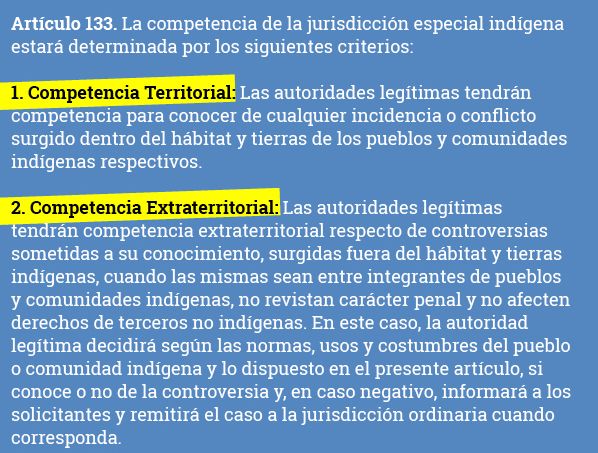
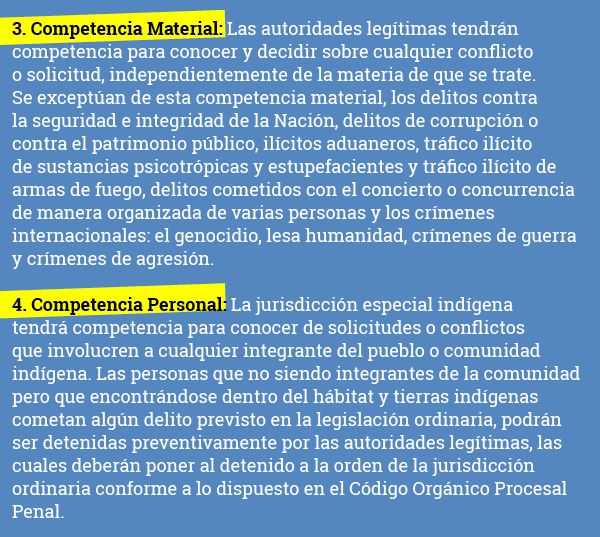
“They can activate special indigenous jurisdiction to inquire on the Kumarakapay events. They do not have to wait for the Public Prosecutor’s Office to initiate an investigation as they can do so themselves because it happened on their territory, against indigenous people and is a matter in which they can form an opinion. They could even go to international courts without waiting for the State to respond. Since it is a matter of fundamental rights, they can go the United Nations, the Human Rights Council, the Inter-American Court. There are many international organizations they can go to”, says Aguilar.
The attorney states that the possibility to take this case to those courts depends upon the will of the legitimate authorities of the Pemón people to initiate the process. Almost a year later, the Council of General Caciques and the Indigenous Federation of the State of Bolívar remain silent.
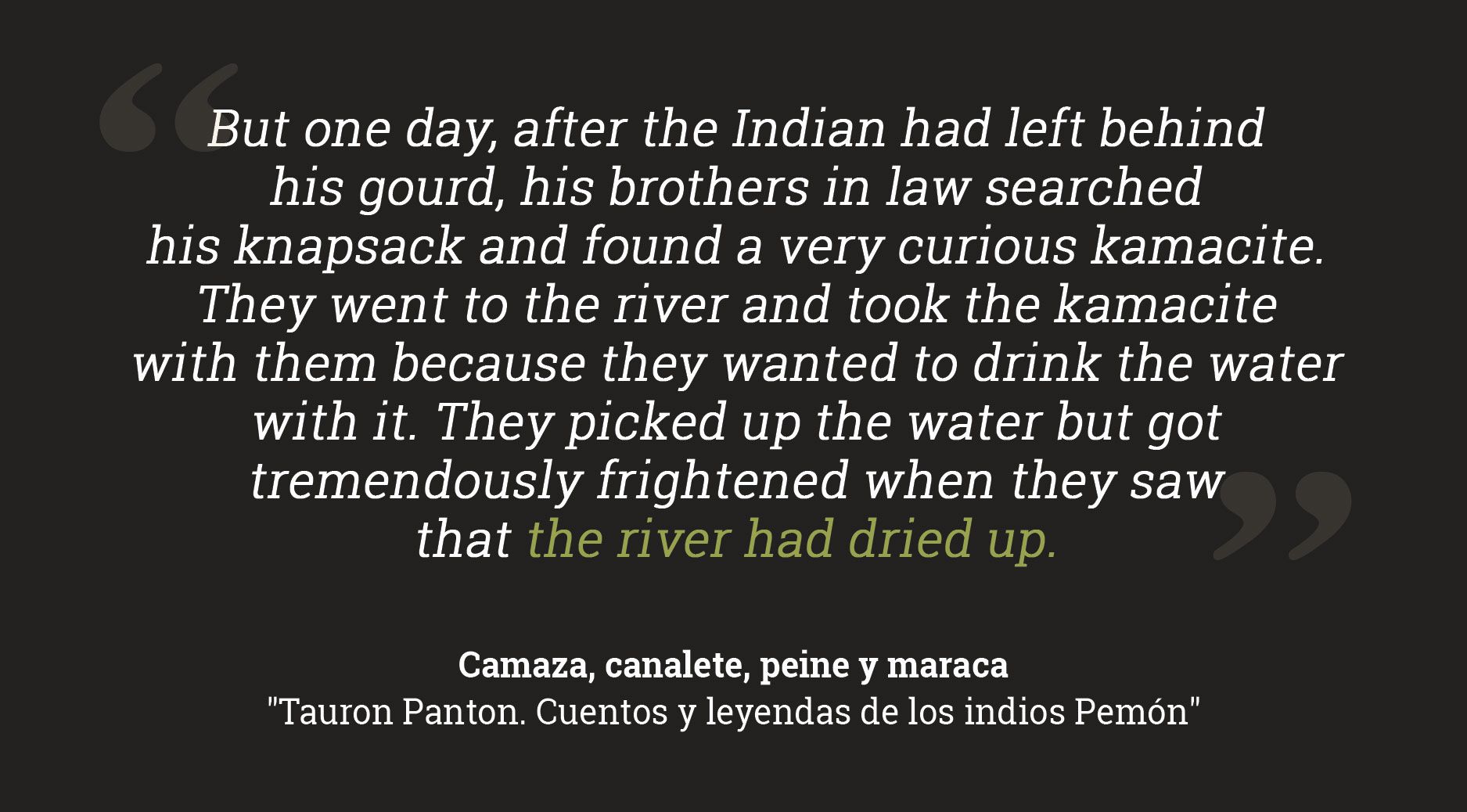







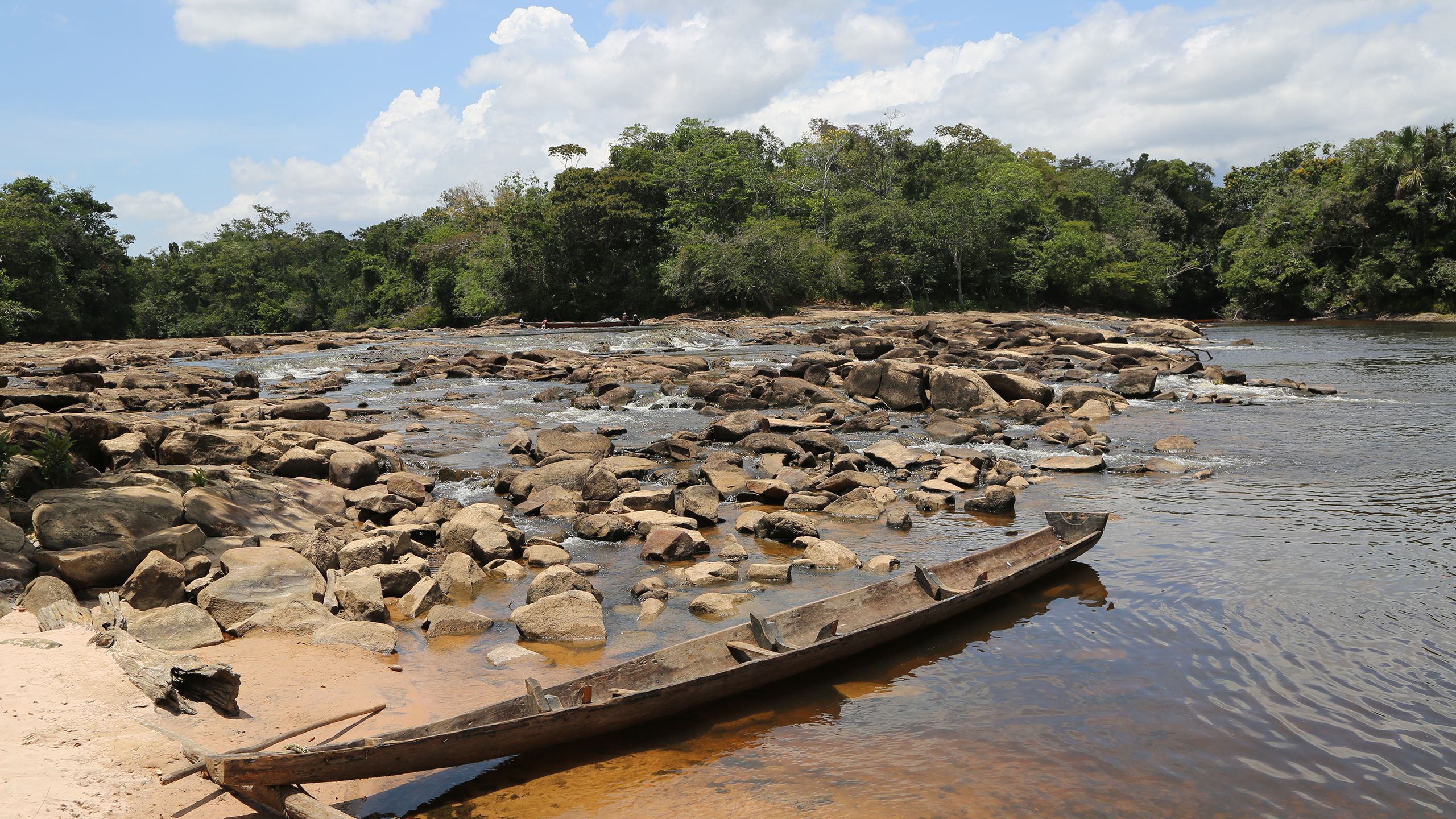
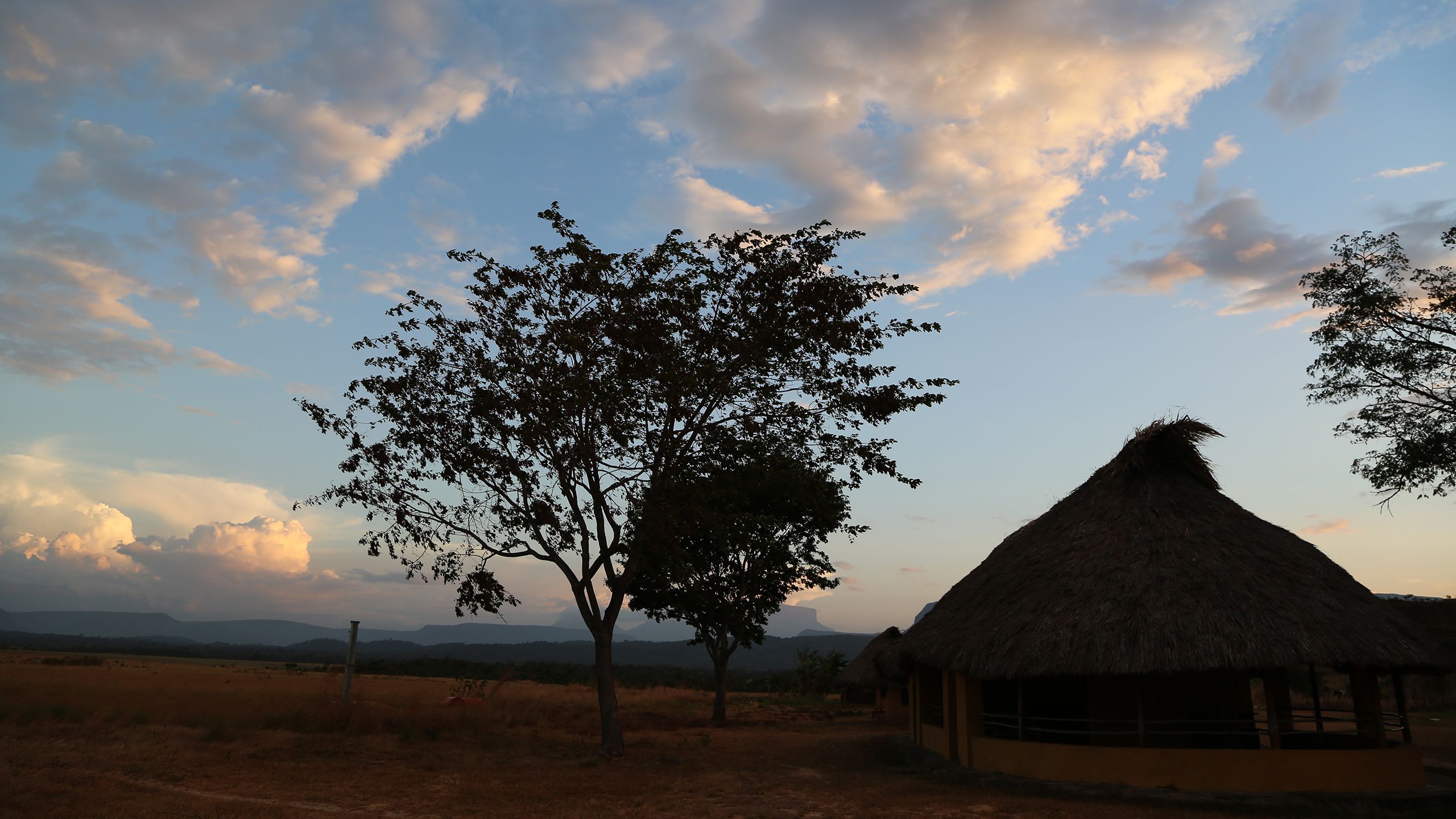

A heritage site on the red list
Mining advances in the National Park

The reason mining is prohibited inside Canaima National Park lies in the fact that this land, along with 43 other national parks in Venezuela is part of the so called Areas under Special Administrative Regime (ABRAE for its acronym in Spanish) which abide by the rules of the 2006 Territorial Order Zoning Plan (Plan de Planificación y Ordenamiento del Territorio). However, in the past few years this plan has not been able to put an end to the increase of mining in this area which is protected for its immeasurable scientific value, monumental beauty and environmental fragility. Even less after the creation of the Orinoco Mining Arc in 2016.
Mining is not prohibited in Venezuela alone. Extracting gold inside national parks is an unacceptable activity according to international standards that govern the Protected Areas on Planet Earth, says the International Union for the Conservation of Nature (IUCN). This organization is the largest and most diverse environmental network in the world. Since 1948 it has published a “red list” of endangered heritage sites. Mining and the severe deterioration of the natural beauty or scientific value of the property are two definitions of ascertained or potential danger for which a World Heritage Site could be included in the World Heritage Danger List according to UNESCO’S Convention Concerning the Protection of the World Cultural and Natural Heritage. State Parties who fail to defend and protect its heritage receive a moral sanction.
The IUCN’s conservation outlook assessment places Canaima at an orange level of “significant concern”, which is equivalent to a grade of negative 4 on a scale of 5, where red is the worst valued color. The latest IUCN revision report published in 2017 indicates that the issues of great concern in Canaima are “the quantity and magnitude of elevated threats as well as endangered environmental processes, biodiversity and species”. The document also states that there is great inefficiency in dealing with the effects of mining as well as observing that the capacity and resources invested in the protection of park are insufficient.
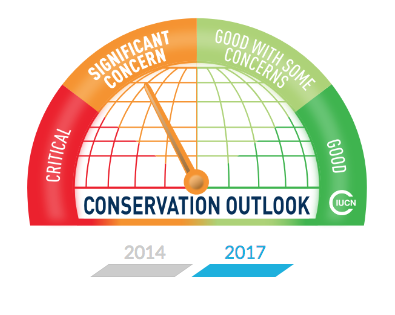
IUCN 2017 World Heritage Outlook. Canaima National Park Evaluation.
IUCN 2017 World Heritage Outlook. Canaima National Park Evaluation.
The Venezuelan Environmental Criminal Law (2011) lists the penalties against destruction of ecosystems which seem insignificant today, given the ascertained or potential damage. Article 56 indicates that any person or legal entity that modifies the water control system, obstructs the natural flow of rivers or causes its sedimentation in violation of current technical rules and without due authorization shall be sentenced to prison between one to five years or be forced to pay a fine of one thousand to five thousand tax units (5,000 tax units), which as of November 2019 is equal to Bs. 250,000 ($12.00).
Likewise, Article 38, which refers to territorial zoning plans, states that any person who causes an adverse degradation or alteration to the topography or landscape while incurring in mining operations –apart from industrial, technological, forest or urban operations- that hinder any zoning plan shall be sanctioned with arrest from three to nine months or subject to a fine of 300 to 900 tax units, meaning Bs. 45,000 (barely $2.00).
Moreover, the 2015 Executive Order which regulates the controversial Orinoco Mining Arc, establishes that the Venezuelan State shall possess full control of exploratory operations including the extraction of gold and other strategic materials. Article 44 of this order says that any person or legal entity, of a public or private nature, that promotes or works in direct or related operations to national parks without complying with the necessary formalities shall be sanctioned with prison from five to ten years.

A mined national park
Gold extraction in Canaima began even before the creation of the Orinoco Mining Arc, which is located in the northern border of the national park. The first alarm goes back to 2010 when Alejandro Lanz, director of the Venezuelan Center for Environmental Research (CIEV for its acronym in Spanish) denounced the presence of makeshift barges in the Caroní River which went beyond the park’s border limits.
But according to experts, tour guides and indigenous people living in Kanaimó interviewed for this report, gold mining in Canaima really flourished in 2013 when Nicolás Maduro became President of Venezuela. Since then, the heir government of Hugo Chávez has either denied its existence or promised to outlaw it in vain.
In 2014, the then Minister of Tourism, Andrés Izarra, denounced on a television show broadcasted by a State-owned network that Canaima National Park was being destroyed by “illegal mining”, especially in the Carrao and Caroní rivers. Being interviewed on the program “En Contacto con Maduro”, he mentioned the consequences that sediment formation would bring to the Guri reservoir and the effects it would have on the dam’s engines which generate electricity for 70% of the Venezuelan population.
On October 15th, 2014 the journalist Valentina Quintero used her social media platform to denounce the decline of tourism and the growth of mining in Canaima.
A month later, the Ministry of Defense, Vladimir Padrino López responded to the allegations with the introduction of a military action known as “Roraima Operation” in which more than 200 mining camps and 100 mines were dismantled and 870 miners evicted from the Carrao area. By the end of 2014, he said that Canaima was a mine-free zone”.
Five months later, Padrino’s proclamation was to be questioned. In May 2015, indigenous communities went to the airport to block Canaima’s only runway to protest against mining in the national park and the decline of tourism (the region’s main trade activity). “No to mining” was read on modest posters carried by the protesters. The protest rally ended three days later after Aloha Nuñez, Minister of Indigenous Peoples, Marleny Contreras, Minister of Tourism and members of the Armed Forces promised to meet their demands.
Illegal Groups
Since he took office in 2013, Nicolás Maduro has never made an official visit to Canaima nor participated in any official events with the renowned lagoon and its perennial cascades as a backdrop. Related government offices such as the Ministry of Indigenous Peoples, the Ministry of Eco Socialism and the Ministry of Tourism sent their officers in 2013 to calm new protests by the Pemón people against mining. “The priority of the Mining Motor (program) is to protect Canaima National Park. Together with leaders of the Pemón peoples we are evaluating several strategies to put an end to mining in protected areas. Mining cannot and should not exist in Canaima”, said Víctor Cano, Minister of Environmental Mining Development at the time.
During its visit to the Kamarata and Kanaimó communities in 2019, Runrun.es found that there are conflicting positions within the Pemón people regarding mining. On one hand, there are those who support gold extraction with all of its social and environmental implications and on the other are those who reject it completely. The former justify their decision to work in the mines because tourism (the region’s main commercial activity) has suffered an impressive decline, while the latter insist on activating tourism in Sector 2, one of the eight sectors that comprise the Pemón territory, despite the dramatic economic contraction.
These people base their recovery projections on the park’s history before it was declared a protected area. Many in the Pemón community, especially the elder, remember that their “brothers” extracted diamonds in sectors such as Arenal. When Canaima became a national park in 1964 and personnel and manual labor were needed to face the growing tourism industry, the pans used for gold panning disappeared from the river. “Nobody needed mining as a means of survival”, they reminisce.
By definition, all mining inside Canaima is illegal. Apart from being executed in a protected area where this type of activity is forbidden, the national park is located outside of the 43,183 square miles that make up the mining mega project known as the Orinoco Mining Arc, established by the government of Nicolás Maduro in 2016 for the extraction of precious minerals, among them gold, diamond, coltan and nickel. This has led to the creation of more than twenty partially-State owned companies as well as private companies from around nine countries.
Denuncia de minería en Cana... by runrunesweb on Scribd
Unlike other districts in Bolívar which fall under the Orinoco Mining Arc, the exploitation of gold mines in the Gran Sabana municipality (inside of which is Canaima National Park) is not controlled by the so-called pranes (leaders of a criminal group who often runs their operations from prison), criminal group leaders and mafias known as the “sindicatos”, nor the Colombian guerrilla like the National Liberation Army (ELN) which are all paramilitary groups that control the mining business in Southern Venezuela. This distinction is made by the International Crisis Group in their March 2019 report on the mining conflict in Southern Venezuela.
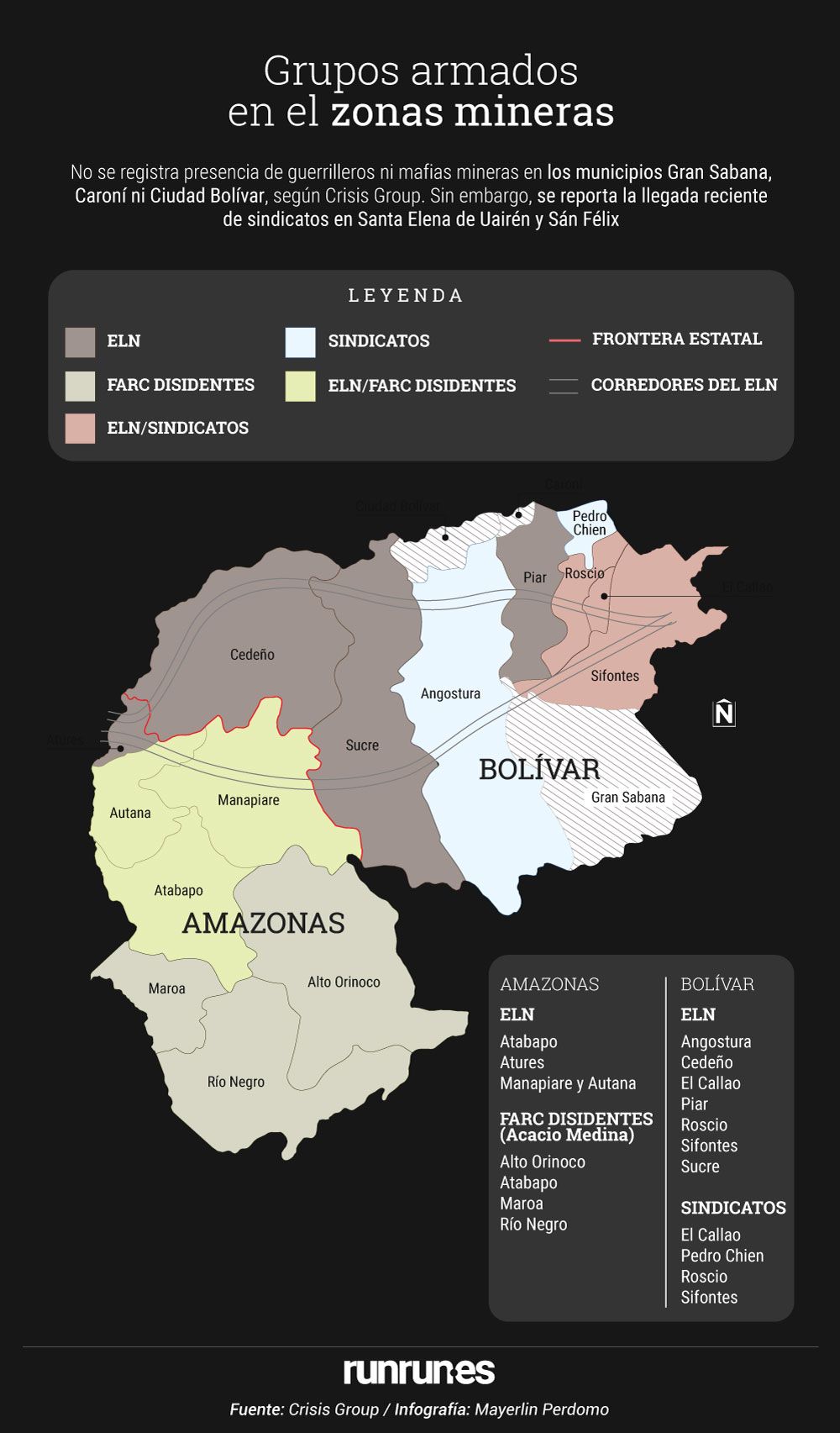
The reason Canaima is a sort of free zone for criminal groups can also be explained by its almost impossible access to southern indigenous territories. Not only are they hundreds of miles away from any urban center, many of these areas are accessible only by light planes or long journeys by boat, says José Rafael Lozada, a forest engineer at Los Andes University (ULA).
There is no evidence of armed criminal groups inside Canaima controlling the extraction and distribution business as seen in other mining areas around Bolívar. The Pemón people are the ones who extract gold from makeshift barges or open-air pits, endorsed by their own group as well as their political-territorial organizations. However, according to the S.O.S. Canaima report, they are not the only exctractivist groups in the area. Military and political actors participate indirectly by controlling the fuel and gasoil business in aerial communities of the national park.
The rural scene observed all along the Akanan River where Pemón families tend to their plots of land, paddle their canoes and cook the tumá, a traditional soup made with fish, yucca flour and chili pepper, heavily contrast with the makeshift barges and their respective engines and jerrycans which can be seen throughout the Carrao River landscape.

The tumá soup is a typical Pemón dish. Photo: Lisseth Boon.
The tumá soup is a typical Pemón dish. Photo: Lisseth Boon.
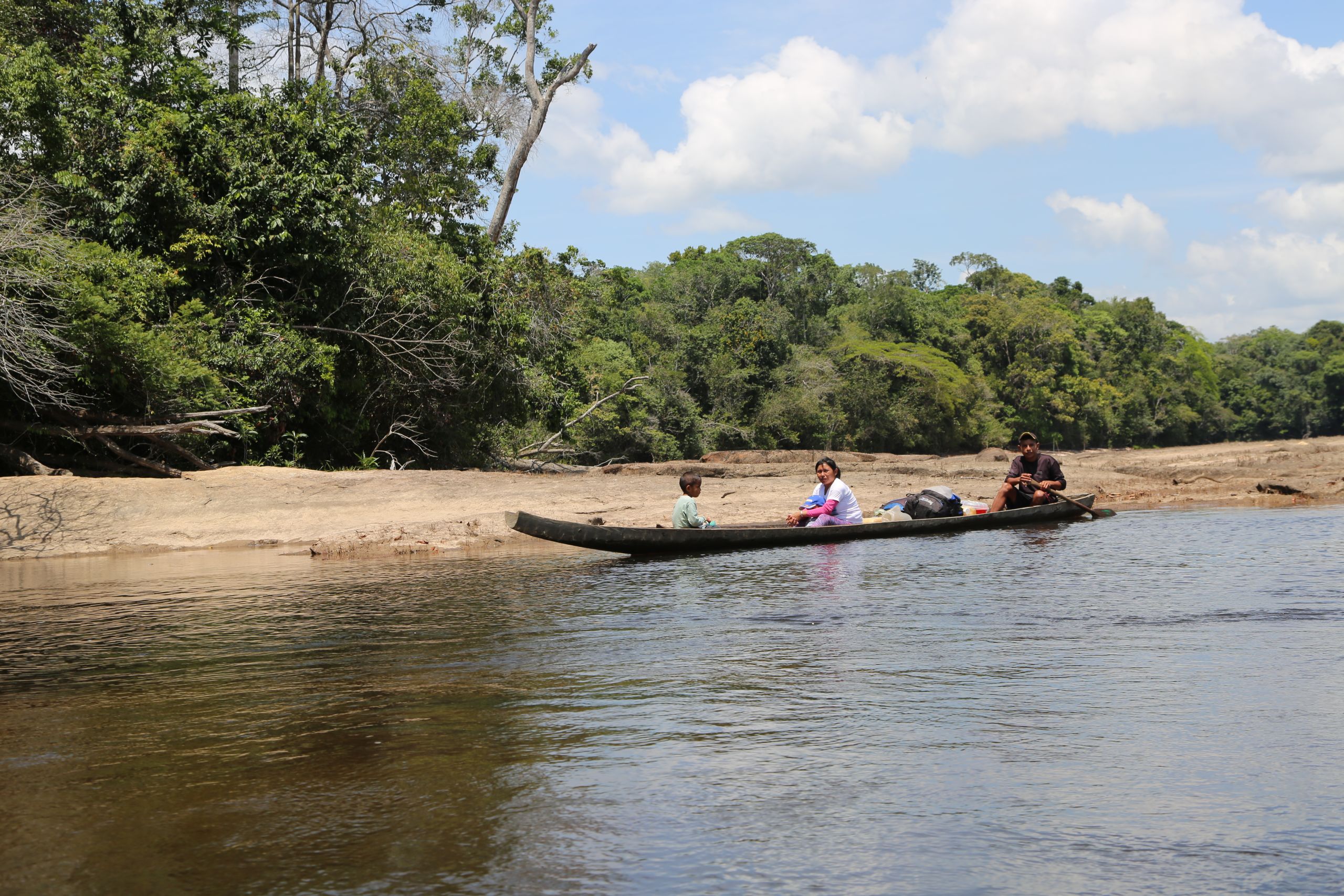
Pemón indigenous people in the Akanan River. Photo: Lorena Meléndez
Pemón indigenous people in the Akanan River. Photo: Lorena Meléndez
An “Indigenous” Mining Arc
Mining in Pemón territory is not only limited to Campo Carrao, Cañon Aonda (near the island of La Orquídea) and the Arenal zone in the Carrao River, which are located in Sector 2 of the park. According to the S.O.S. Orinoco report and based on satellite imagery and field studies, there are 33 mines in Canaima, 15 of which are inside the national park and 18 near its borders.



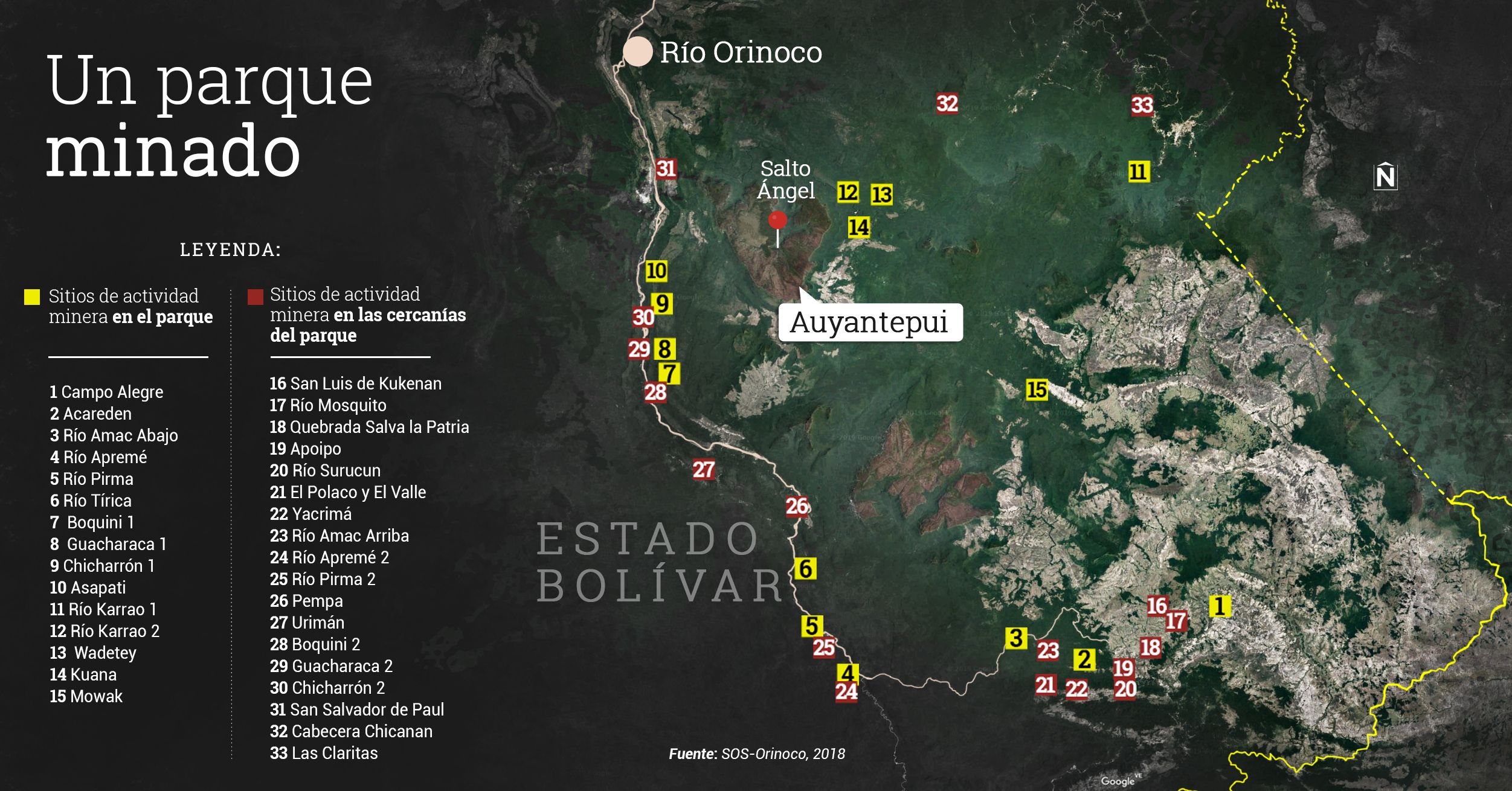
Venezuela has the most illegal mining sites in the entire Amazon region, according to the Amazon Geo-Referenced Socio-Environmental Information Network (Raisg) and Infoamazonía. Of the 2312 points and 245 areas of unauthorized gold, diamond and coltan extraction, detected by satellite research, 1,899 are found in Venezuela, followed by Brazil (321), Ecuador (68) and Peru (24).
The sparkling dots over Canaima’s green terrain as seen from satellite images and field testing, led forest engineer José Rafael Lozada to propose the existence of an “Indigenous Mining Arc”: a belt of mines exploited by the local inhabitants of the Western and Eastern section of the national park which is located outside of the polygonal which makes up official Orinoco Mining Arc.
“Nobody wants to assume that the indigenous people are mining inside the park”, says Lozada, head professor of Ecology and Environmental Impact at University of Los Andes. For him, the thesis that the Pemón people have taken to mining because of the Mining Arc is erroneous. “They are two different things; from the moment mining first appeared as well as the territory where it is practiced. There are active mines inside the park way before the creation of the mining belt decreed by Maduro in 2016. Some began in the Caroní basin in 2004”.
Lozada makes no concessions about indigenous mining. He discards the notion that it is about artisanal mining (as practiced in pre-Columbian times) because of the mercury and hydraulic engines used to extract gold, a modern method which erodes the sediments to extract the precious metal.
“We must take into account that all that machinery is carried on dugouts through rivers and by air on light planes. It arrives to the mines thanks to the involvement of the military at the airports which permits the embarking of all this mining equipment on the planes, using everything available in the corruption system set up for the gold business in the region”, says Lozada.
“No foreign company, such as the partially-State owned companies set up especially to extract gold inside the Orinoco Mining Arc, are present in Canaima because mining is simply forbidden inside the national park. Not only is it an ABRAE, it is also a national monument, a protected reserve and a national hydraulic reservoir”, says Lozada. “Indigenous communities are working there autonomously. But the activity is overflowing and if not controlled it will grow into enormous proportions”.
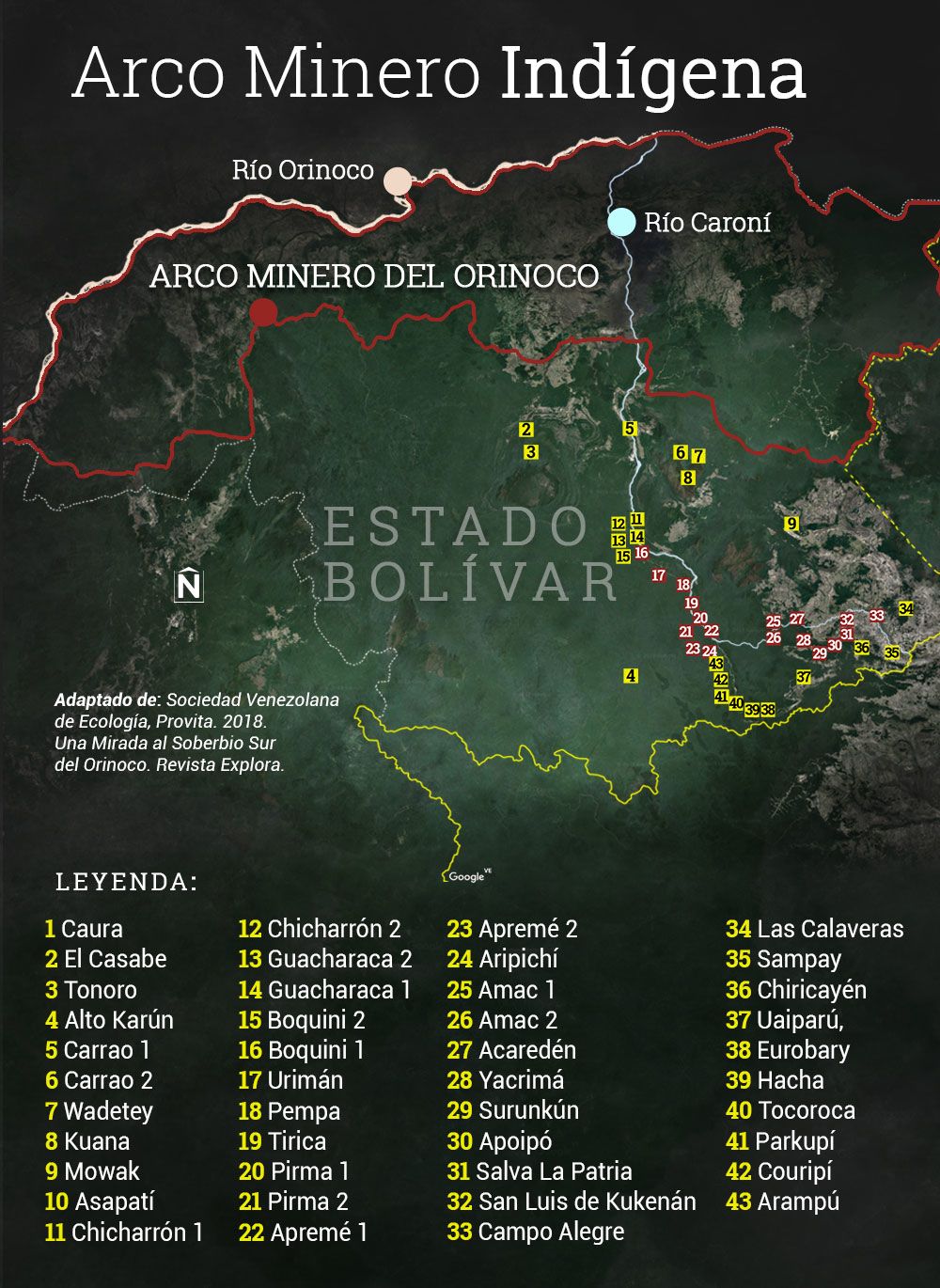

Satellite images taken on November 2018. These images were submitted as evidence to the Public Prosecutor’s Office.
Satellite images taken on November 2018. These images were submitted as evidence to the Public Prosecutor’s Office.
Alejandro Álvarez Irragory, coordinator of the NGO Coalición Clima 21, believes it is exaggerated to talk about an “Indigenous Mining Arc” because it does not take into account the complexity of the situation disrupted by mining operations in Southern Bolívar. The representative of this organization devoted to the defense of environmental and human rights, states that gold has distorted the economy of a region where everything is measured in terms of gold grams and is under the control of organized crime and armed groups.
“Yes, there are Pemón people involved in gold mining but not all the Pemón people are miners”, says Álvarez Irragory, while noting that indigenous people have fought against mining for years and have resisted the advances of this activity in Pemón territory, with all the massacres, exploitation and violation of human rights this struggle has implied. “We don’t justify it, but we can understand why the indigenous people have opted to work in the mines. Many of them say it: ‘If we don’t extract gold, we die. Ever since tourism collapsed, there is no food or medicine”.
Mining Resistance
The fact that the Pemón ethnic group incurs in mining operations could be viewed at a glance as a contradiction. Or rather as an act of resignation or submission that contributes to the destruction of their traditional land. But it also represents a resistance mechanism, says Vladimir Aguilar Castro, an attorney specialized on indigenous matters and professor and researcher at Los Andes University (ULA).
For the expert in extractivism and indigenous peoples, it is essential to understand this phenomenon from the point of view of indigenous jurisprudence which recognizes their rights to participation, prior consultation and communal property. Therefore, gold mining would be the Pemón peoples’ answer to the Orinoco Mining Arc, an extraction project devised by the “Criollos” which was imposed onto their territory without fulfilling the right to information and consultation with indigenous communities established by the Constitution of the Bolivarian Republic of Venezuela. “If they (the “Criollos”) exploit our lands without having consulted us first, why can’t we do it?” seems to be the indigenous peoples’ reasoning according to Aguilar Castro.
The researcher also adds that it has to do with territoriality. For the Pemón people, it constitutes a form of empowerment over what they consider to be their lands, which have not been recognized by the State and are being exploited without prior consultation to the communities who inhabit these lands since ancestral times.
Moreover, the indigenous peoples’ take on gold mining in a way which differs from the ‘Criollos’, explains Aguilar Castro. “They do not view it as a permanent operation of unlimited resource extraction, but rather as a temporary operation which they must recur to by force, given the Venezuelan economic crisis. It does not respond to a plan like the Orinoco Mining Arc but rather to a necessary survival strategy which calls for the solution of essential problems caused by the collapse of other sources of income like tourism in the region”.
Olmar Ortiz, an indigenous attorney and human rights activist from the town of Baré in Amazonas state, points out the differences between ethnic mining in Amazonas and Bolívar states. “Unlike Amazonas, where many indigenous people work at the mines as employees under harsh conditions, in Canaima it is the Pemón people who are in charge of the mines. They control them”.
Ortiz, who is also the National Coordinator for Indigenous Peoples at the Foro Penal human rights organization, adds that it is important “to understand that for indigenous people, mining is not a way of life. They work on it in order to obtain resources which can help them solve specific problems. I understand people who are against mining but when I see an indigenous person who does not eat, who gets sick and has no access to medicine, how can I tell them to stay away from mining?”
Forced to Damage
“Sometimes I’d like to get into my fellowmen’s heads so that I could understand why they do what they are doing”, says a tour guide operator with decades of experience in his native region as he stares from afar at a group of makeshift barges floating on the Carrao River. All of the Canaima residents interviewed for this report agree on one point: there is no other way out in the middle of a national economic crisis which affects everyone. The dramatic collapse of tourism, the region’s main trade activity, forced the original inhabitants to take on this unnatural activity to make a living.
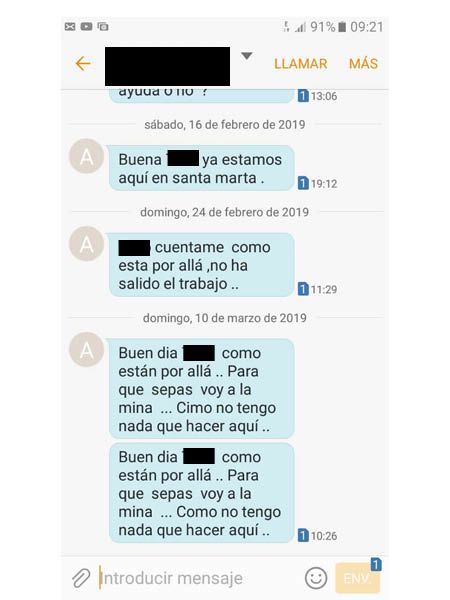
Chat screenshot taken from a tour’s guide cellphone. The Pemón tour guide says that he has to go to the mines because there is no other work.
Chat screenshot taken from a tour’s guide cellphone. The Pemón tour guide says that he has to go to the mines because there is no other work.
“We can’t find a job at the Canaima Lagoon. The tourists stopped coming and we have to find other ways to survive”, says a seventeen year old Pemón girl who has just graduated from High School with a technical degree in tourism. She admits this after offering the visitors a bowl of tumá, (the typical Pemón soup prepared with chili pepper, fish and yucca) and sakura (a refreshing drink made with yucca) at the Arenal tourist camp where she joins her mother in cooking and waiting on the local miners.
Claims of mining exploitation in Southern Orinoco have reached even the House of Lords in the United Kingdom. On June 11th, 2019, Kukuy, a delegate of the Pemón tribe, joined by former Venezuelan ambassador Diego Arria, exposed the national park’s ongoing threats to the audience in a lecture entitled “Venezuelan Crisis: Destroying the Amazon and the Pemón People to Sustain the Maduro Regime”. In this event he also called for more actions by UNESCO and the International Union for Conservation of Nature (IUCN) to include Canaima in the World Heritage danger list.
Kukuy, un representante del Pueblo Pemón, con @Diego_Arria piden en @UKParliament que el mundo se una a la lucha por salvar el Sur del Orinoco y presionen a @UNESCO @IUCN a colocar el PN Canaima en la lista de Patrimonio Mundial en Peligro como lo ha exigido la ONG @SOSOrinoco pic.twitter.com/3wLaOXbAoB
— SOS Orinoco (@SOSOrinoco) June 11, 2019
At this event, the Pemón delegate also assured that indigenous people are forced to work in mining “even against their will”. He added that a great percentage of his people are against mining operations and if there were to be a regime change in Venezuela which reactivated tourism activities, the Pemón people would abandon illegal mining.
Kukuy explicó que la mayoría de sus hermanos Pemones no quieren arriesgar sus vidas en las minas, pero han sido obligados por el regimen criminal de @NicolasMaduro y sus secuaces, y una vez logrado el fin de la #usurpación, los Pemones dejarían la minería ilegal!
— SOS Orinoco (@SOSOrinoco) June 12, 2019
Lack of Public Defenders
There are not many public officials in the government who will admit to gold extraction in Canaima, much less that it is being operated by indigenous people. Programs for the prevention and eradication of mining in the World Heritage national park are not included in the government agenda and are missing from the budget portfolio of the Ministries of Eco Socialism and Waters (formerly of the Environment), Indigenous Peoples, Tourism and Economic Mining Development, all of which have competence on the matter as well as the region.
On the contrary, there are public officers who deny that mining exists in Canaima.
Such is the case of the then president of the National Parks Institute (Inparques), Jorge Alejandro Medina Murillo, who uploaded a video to the Inparques official Twitter account recorded on August 16, 2017, a year and a half after the creation of the Orinoco Mining Arc to counterattack the claims on mining inside Canaima National Park which were being spread around social media.
#EnVideo | @InparquesGobVe fue al #SaltoAngel a verificar que supuesta explotación de oro es falsa https://t.co/bbE6TpsbB7 pic.twitter.com/rZFMcR0VbR
— Inparques_Oficial (@InparquesGobVe) August 17, 2017
In the video, recorded “by request of President Nicolás Maduro and the Minister of Eco Socialism, Ramón Veláquez Araguyán”, Mr. Medina assures from a light plane flying over Canaima and just a short distance from Angel Falls that “there is no kind of intervention or mining” in the park.
What Mr. Medina failed to record from that flight was Campo Carrao, an esplanade on the banks of the Carrao River located just 14 miles from the Auyantepui where mining has been gaining ground since 2000, as proven by satellite image registries.
Medina also did not show the makeshift barges which extract gold throughout the Carrao River, especially in the Arenal sector, or on the base of the Aonda canyon, located right on the Auyantepui, close to La Orquidea island.
Mr. Medina’s denial of mining in Venezuela’s protected areas was not to last. On June 26, 2017, barely two months after becoming the president of Inparques (Resolution 170, Official Gazette No. 41.384), he was appointed Vice Minister of Eco Mining Supervision and Control, which responds to the Ministry of Environmental Mining Development, in substitution of Nelson Hernández.
Medina also became the president of the “Piar Mission”, a social program created in 2005 by Hugo Chávez which later became a foundation. Its purpose was to liberate mining communities “from the exclusion and exploitation of mafias devoted to mineral extraction contraband in Bolívar state”.
Some institutions have taken formal steps to condemn the situation, but their efforts have been in vain. In 2010, the Inparques Workers Union (Suneinparques for its acronym in Spanish) presented an internal memorandum to the organization’s authorities in relation to mining in the Waraeipa sector, an indigenous community located in the Western region of Canaima National Park. Included in the document (currently lost) were a series of photographs taken between 2009 and 2010 with evidence of the environmental disaster in the area. The photographs also show Inparques personnel and the Bolivarian National Guard dismantling illegal mining camps.
“By 2010, although Canaima was already heavily afflicted, Inparques still had the required equipment and vehicles for security and preventive purposes and that is why it was able to dismantle mining camps inside the park”, says Marlene Sifonte, representative of Suneinparques. “But authorities paid no attention”, she adds. “After 2011, mining in Canaima intensified”.
Ms. Sifontes observes a parallelism between the dismantling of the institute and the arrival in 2011 of the Francisco de Miranda Front led by Marisabella Godoy, substituted by her advisor, Angelica Romero. She also adds that the elimination of the Ministry of Environment (replaced by the Ministry of Eco Socialism and Waters) plays an important role. She states that this was the first government institution of its kind in the continent and second in the world only after the Ministry of Ecology in France.
“Neither the Ministry of Eco Socialism nor Inparques have done anything to put an end or speak against mining in the national parks located in Bolívar and Amazonas states, as in the case of Yacapana. They have not come forth, nor requested environmental impact studies in these protected areas or investigations with their corresponding approvals, which are not hastily done”, says Elídes Sulbarán, union delegate of Inparques.
These environmental custodians consider that although park rangers and technicians have spoken out against these irregularities, the decision-making authorities are not fulfilling their duties. Inparques position is contrary to the nature of the natural parks. In a meeting in the city of Merida, Venezuela, the former president of Inparques, María Isabel Godoy de Peña, said that capitalism intended to take all of the resources contained in Venezuela’s national parks. According to Mr. Sulbarán, it’s not capitalism who has taken the reserves, it’s the government.
Inparques authorities contacted for this report to comment on the situation of mining inside Canaima National Park gave no reply.
In his 2017 Annual Report, the Minister of Eco Socialism and Waters mentioned Canaima only once among the “20 national and recreational parks around the country where 38,475 kilos of trash were collected”.
The closest thing the aforementioned Ministry came to mentioning the topic of mining in the national park was registered in the 2013 Annual Report with the mention of the “Program for the Sustainable Management of Natural Resources in the Caroní River Basin”. The report states that Bs. 17,280,135.90 (2.7 million dollars according to the official exchange rate) was allocated for this program. 31.74% of this amount (Bs. 4,019,747.53 or $638,055) was assigned to the project “Establishing regulations and prevention of agricultural and mining activities in the Caroní River basin”.
Two years later, the 2015 Annual Report of the General Comptroller used exact geographic coordinates to inform of mining operations in the indigenous community of Campo Alegre, close to the Kukenán River, where gasoline pumps and conveyor belts were used for gold extraction. An onsite inspection on May 14, 2014 in the Western sector of Canaima National Park led them to suggest “the need of environmental measures to prevent ecosystem deterioration as well as excessive and irrational activities in the process of auric resource extraction by the inhabitants of the Campo Alegre community”:
In a recent public report, the Maduro administration has recognized the existence of mining operations in Venezuela’s protected areas. The 2019-2025 Sectorial Mining Plan mentions small-scale and artisanal mining and notes that there is a predominant “precariousness of living conditions for the miners and neighboring communities”, affecting the environment, health, housing, criminal rates and local hyperinflationary micro economies. In the 106 page report, the only mention of national parks says that they are being affected by the use of “contaminating substances such as mercury” and “rudimentary and obsolete techniques which damage the drainage basins and subterranean waters causing a serious land contamination”. Canaima and all other national parks in Venezuela are not mentioned.
The 2019-2025 Sectorial Mining Plan also accepts the existence of indigenous communities involved in mining operations, although no names of national parks are given. As a joint organ of the National Environmental Mining System, the Ministry of Indigenous Peoples is responsible for the implementation of protection plans and social assistance to indigenous mining communities.
There is no current census establishing the number of Pemón indigenous people who are working in the mining business, although experts such as University of Los Andes professor José Rafael Lozada calculate that the majority of those living in the 124 communities that comprise the 8 sectors forming Canaima National Park are extracting gold from the rivers and lands as a means of survival.







Artisanal neo-extraction
Mines erode the World Heritage Site

Campo Claro is a forbidden land. No tourists or foreigners can access this mine from the Carrao River. The entry is just a few miles from the mouth of the Akanan River, in a rudimentary town where the dugout s carrying young miners disembark. No charter plane wants to fly over this sector. No one from the tourism industry wants to be related to this illegal activity.
On a flight over the area, a camera captures a wide terrain of stained and cloudy sand with gaps that form lagoons of a thick brown color. Like an open wound in the middle of the jungle, the bare earth contrasts with the grayish blues of the tabletops and the dense greens of the trees in the background. Another shot approaches the sides of the serene and dark river and reveals the presence of several makeshift barges. All of these moving images are accompanied by a statement: “Mining inside Canaima National Park”.
The sequence belongs to a video published on social media by the journalist Valentina Quintero on October 15, 2018. In it, she reports the advances of mining in Campo Carrao, located in the heart of Canaima National Park, just 14 miles from Angel Falls. It's an open-pit mine whose existence the reporter had already uncovered in 2014. On this occasion, however, she warned that the mine has continued to grow. Also this time, she mentioned the Minister of Eco Socialism, Victor Cano, the official Twitter account of the Ministry of Ecological Mining Development, Heryck Rangel, Minister of Eco Socialism, and Marlon Ecosocialismo, the head of waste and residue management in Bolívar state.
La mina de Campo Carrao es cada vez mas grande. Ustedes la vieron el viernes 5 de octubre. Los 3 estuvimos en Canaima el mismo día. @vcano75 @EcoMineriaVE @HeryckRangel @MEcosocialismo pic.twitter.com/B74a9uxIZE
— Valentina Quintero (@valendeviaje) October 15, 2018
La minería está dentro del PN Canaima. Ustedes lo saben @vcano75 @EcoMineriaVE y @HeryckRangel @MiEcosocialismo pic.twitter.com/vLUvXNdkQT
— Valentina Quintero (@valendeviaje) October 15, 2018
The type of mining in the rivers and open-pit mines of Canaima’s Sector 2 is defined by geologists and mining engineers as a part of the so-called alluvial mining: dredging streambed deposits for gold. This is different from subterranean mining, which requires a greater investment of resources and where access to deposits is harder (for example, the mine belonging to the State-owned Minerven in El Callao, Bolívar). Alluvial mining uses primitive technology and under qualified labour. Since it is the cheapest method of extraction, its practice is extended throughout underdeveloped countries.
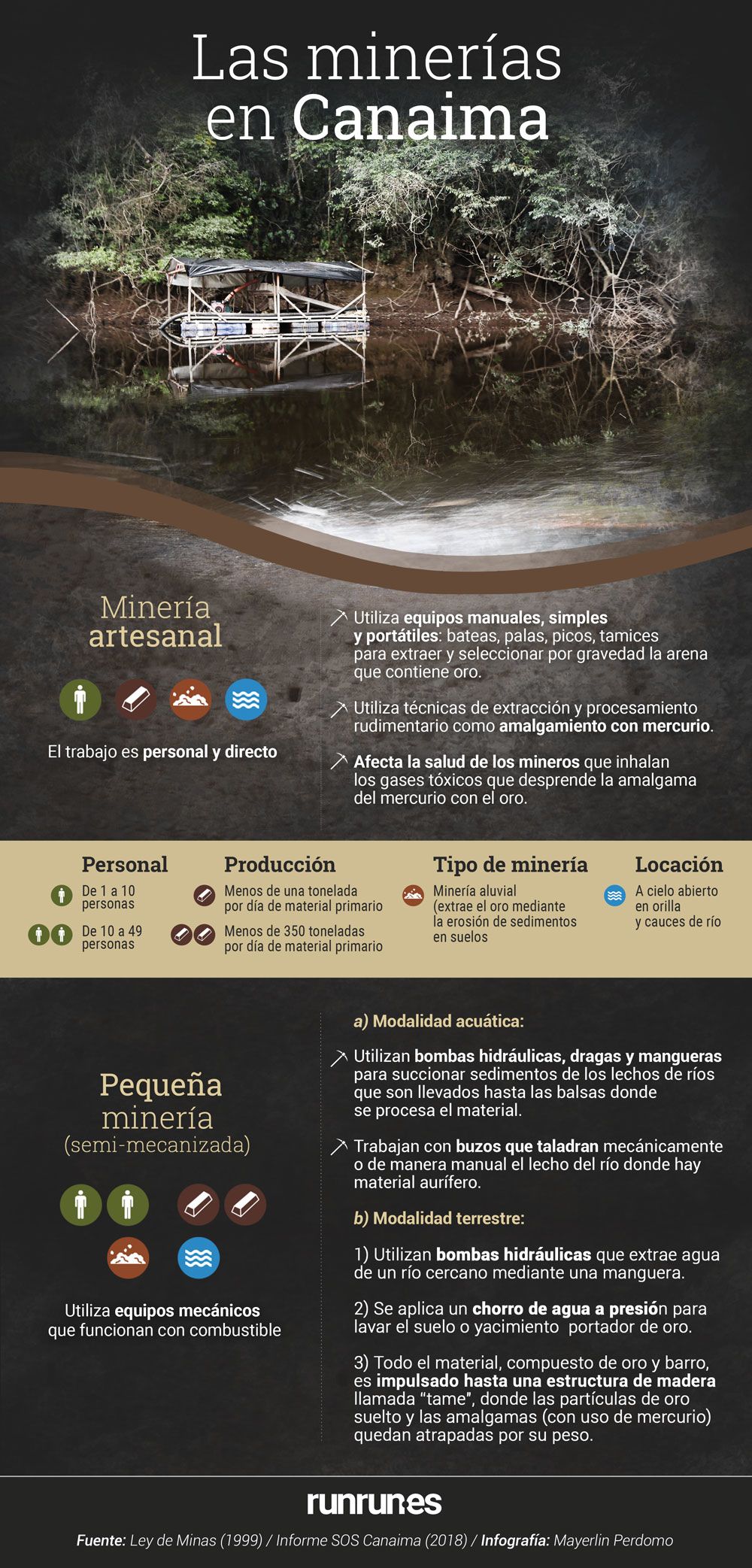
There is a common belief that the type of mining indigenous people engage in is less harmful to the environment. Many claim it’s a “pickaxe and shovel” activity. But being artisanal and/or semi-mechanical does not degrade the environment less or make the workers less sick. The water pumps used to dredge gold and the conveyor belts on the rafts work with gasoline. Mercury, a highly toxic metal, is used to extract the mineral from dirt.
Nobody in Canaima follows a manual or method to dredge gold from river beds. There are no regulations and no proper enterprises that follow a procedural manual or even pay taxes as the State does not grant concessions for mineral extraction in the area. Therefore, mining in the national park belongs to the kingdom of informal economy.
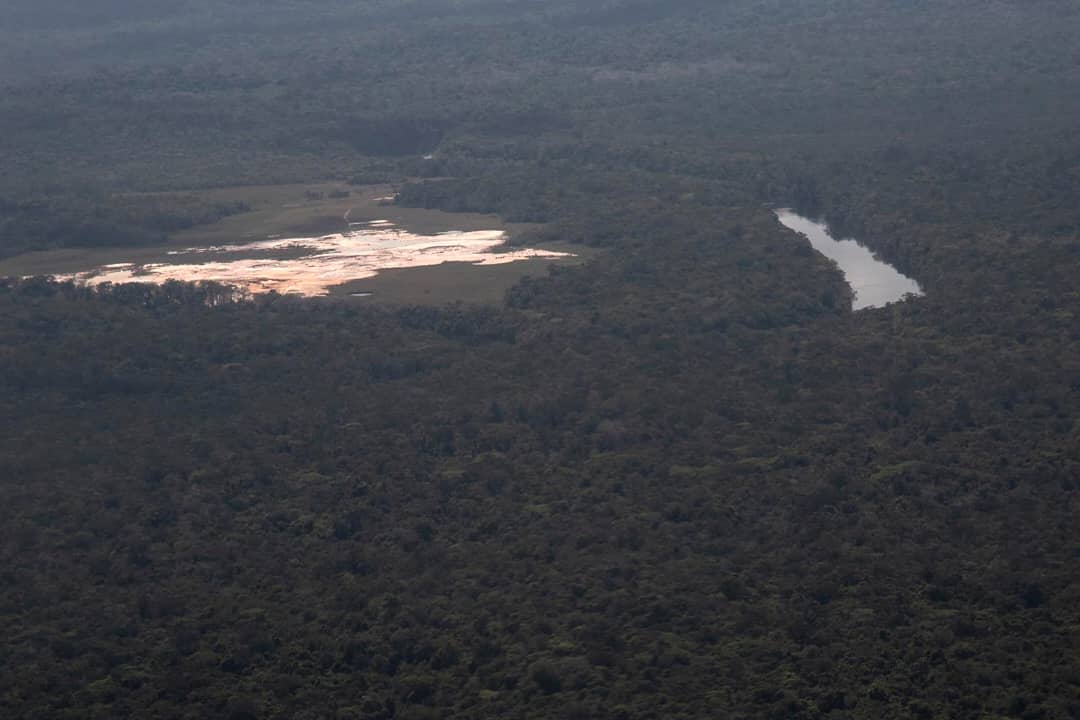

An aerial view of the Carrao Mines in September 2019. Photo: courtesy of its owner.
An aerial view of the Carrao Mines in September 2019. Photo: courtesy of its owner.
Even if mining in Canaima were allowed, it would still have plenty of restrictions. According to the 1999 Venezuelan Law on Mines, artisanal or small-scale mining “shall be operated with a strict compliance of environmental legal framework” (Article 84) and shall be subject to the payment of taxes established under this law (Article 85). It also says that the State shall provide technical advisory for its evolution “towards higher activity stages” (Article 83). None of the above is applied.
Forbidden Mercury
Small-scale mining in Canaima uses mercury for gold extraction irreducibly, confirms Mónica Martiz, a mining engineer and professor at Central University of Venezuela (UCV).
Mercury is a heavy, silver-colored and inodorous metal which used inadequately can have potential harm on humans and the environment. It is being poured into the rivers and has an effect of the ecosystem, intoxicating the fish that indigenous eat. According to the UN Environment Programme (UNEP) artisanal and small-scale gold mining is the single largest source of man-made mercury emissions, responsible for the release of as much as 1,000 tons of mercury to the atmosphere every year.
Mercury has the capacity to kill. The gravity of health damages depends on the level of exposure: from a rise in blood pressure to brain and kidney damage as well as fetal growth during pregnancy. Mercury’s fumes can easily enter through the lungs and from there on to the blood, absorbing 80% of the inhaled amount.
UNEP has warned that mercury is one the 10 most dangerous chemicals in public health matters. In its 2018 Global Mercury Assessment Report it confirmed that global emissions of this toxic metal in the atmosphere increased around 20% between 2010 and 2015. South America was among the regions who reported a higher increase rate.
Along with 92 other countries, Venezuela is signatory to the Minamata Convention which calls for the reduction of toxic mercury emissions. Signed in October 2013 by the Maduro administration, its ratification was still pending when the treaty entered into force in 2017, a year after the creation of the Orinoco Mining Arc.
Exposure to toxic levels of mercury is so dangerous that on February 19, 2019 UNEP announced a $180 million program to reform the artisanal and small-scale mining sector. As many as 15 million people work in this sector globally, including 4.5 million women and over 600,000 children.
The use of mercury in mining activities is forbidden in Venezuela. The 2.412 Decree (Official Gazette No. 40.960) issued on August 5, 2016 amidst the creation of the Orinoco Mining Arc, forbids the use, possession and storage of mercury as a method for obtaining or treating gold in any stage of mining activity on Venezuelan soil.
It is possible to determine how much contamination mercury can cause. According to the Environmental Justice Atlas, 2.8 kilos of mercury are used for every kilo of gold extracted. For example, the largest mine in Peru, Madre de Dios, extracts between 16 to 18 thousand kilos of gold each year which means that between 44,800 to 50,400 kilos of mercury are dumped into the Amazonian rivers. This translates into 252 tons of contaminated metal every five years.
The Pemón are oblivious to the illegal use of mercury or its toxicity, or at least they choose to be. “I’ve gotten calls from Ciudad Bolívar offering to sell me mercury. I don’t even let them give me the price. How dare they?” says a veteran tour guide who remembers a time when the paradisiacal camp she works in would receive 200 guests a day, a time where charter planes filled with adventurers were coming and going. Nowadays weeks can go by without a visitor in this area.
For the past 30 years, mercury contamination in the Venezuelan Guayana region has been alerted as a public health concern. Thanks to mining, almost all drainage basins in the south are intoxicated by this metal, claims Alejandro Hernández Iragory, general coordinator of the NGO Clima 21.
There are no known definite studies of mercury contamination in Canaima. The most recent report regarding the effects on indigenous communities in Venezuela was Mercury contamination in the Venezuelan Guayana: Dialogue for Action Proposal published in 2013 by the NGO Red Ara, with the support of Avina. This study concluded that 92% of women examined in the Caura Kuyujani basin (which goes across Bolívar and Amazonas states) were contaminated with levels higher than 0.5 milligrams, which is the maximum number set by the World Health Organization.
A similar evaluation was given in the (unpublished) study: “Evaluation of the risk of methyl mercury exposure in indigenous hamlets on the riverside of the Caura River (Bolívar, Venezuela) dated June 15, 2012. The investigation, led by the La Salle Foundation for Natural Sciences (Guayana campus), the Society for the Conservation of Wildlife and Oriente University (Ciudad Bolívar campus), was based on a sample of 1,174 indigenous people from the five Yekwana and Sanema communities. The study found that 38.8% of these cases exceeded the lowest tolerable level of mercury in hair by 10% and that 5% of pregnant women were at risk of delivering babies with neurological disorders.
Makeshift Barges
A raft floating on the river means there is a nearby campsite on dry land. In Canaima, these rugged structures are built with sticks, have tin roofs and often have no walls. They are equipped with the miners’ daily needs. During its visit, Runrun.es was able to see that some of these structures even have DirecTV antennas and television sets which can be seen turned on at night.
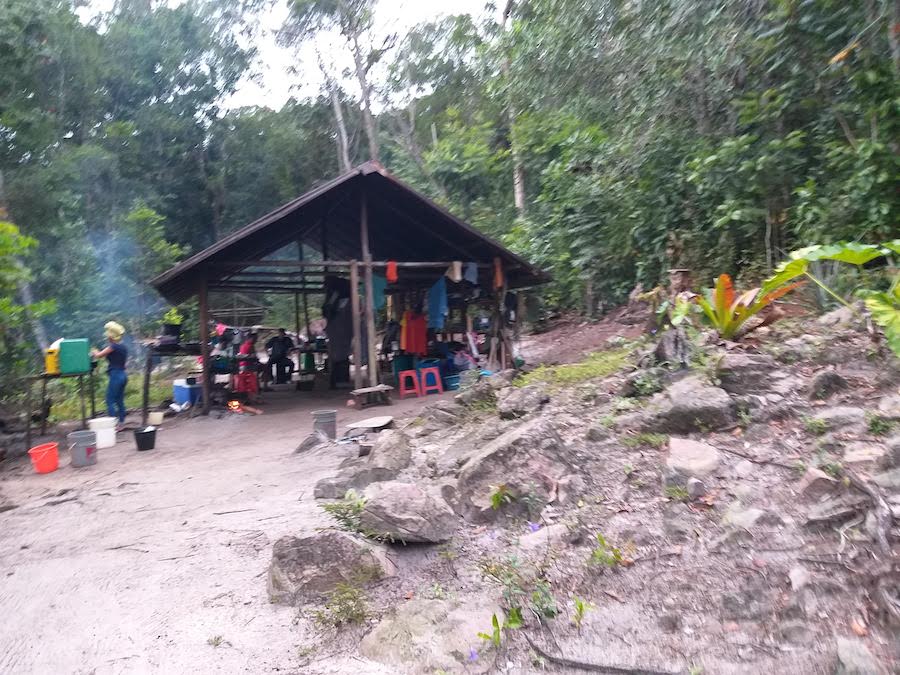
Mining camp on the banks of the Carrao River: Photo: Lisseth Boon.
Mining camp on the banks of the Carrao River: Photo: Lisseth Boon.
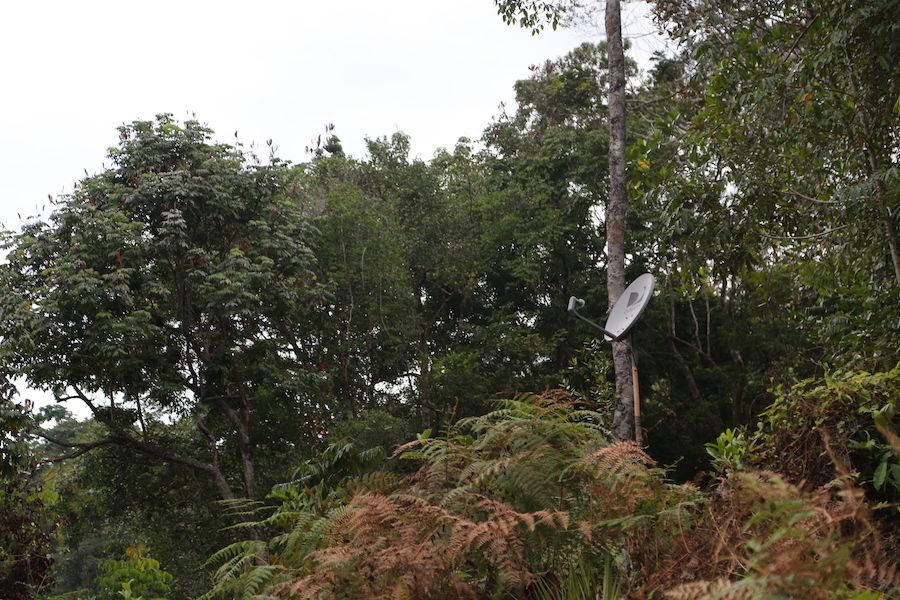
Many mining camps own a DirecTV antenna. Photo: Lisseth Boon.
Many mining camps own a DirecTV antenna. Photo: Lisseth Boon.

Miners in their daily routines at the camps. Photo: Lorena Mélendez
Miners in their daily routines at the camps. Photo: Lorena Mélendez

Discarded machinery used on the makeshift barges. Photo: Lisseth Boon
Discarded machinery used on the makeshift barges. Photo: Lisseth Boon
At these camps, grams of gold are smelted in primitive tradition, making it easier for transportation and trade purposes.
Until recently, makeshift barges were only seen in the vicinity of La Paragua or the lower course of the Caroní River. Beginning in 2014, these barges began to appear on the banks of the national parks, according to witnesses in the area. Runrun.es was able to verify its night-time activity. They are structures of great proportions and machinery which require a series of logistics to move them.
Who are the owners of these barges? That is a question many around the Canaima Lagoon wish to evade. “They are owned either by the Pemón who have enough money to invest in structures and ‘put them to work’ with indigenous labour or by “Criollo” (non-Pemón) investors who associate with the natives to get into this business”, says a tour guide.
The makeshift barges use hydraulic pumps, “sucking” dredges and hoses which suction sediments from the river beds and carry them back onto the barge where the mineral is sifted. With the hoses in hand, the “divers” manually drill the river bed that contains the auric material to ease the suction onto the boats. Above surface, a miner waits for the signal the diver will send him from underwater to either activate the machines or pull out of the water when exploration and extraction have been completed.
Open-pit mining, like the one in Campo Carrao, uses hydraulic engines or water pumps that connect to a hose used to extract water from a nearby river. A high pressure water jet is then applied to wash the material. This material is then sucked dry and transported to a piece of equipment where it recovers the finest particles by mercury amalgamation. This alloy is produced when the material is taken to the “tame”, an inclined plane where mud is distilled and the amalgam is caught in a plastic rug.
The “gramas” (as one gram of gold is commonly known in the region) serve as currency in Canaima. Each “grama” is worth around $20.00. They also come in “puntos” (half a gram) which they carry in small folded pieces of paper. The US dollar is omnipresent while the Venezuelan Bolívar disappeared or never arrived. Many indigenous people interviewed for this report have never seen the recent bill notes incorporated onto the market in June 2019, much less those released in 2018.
Unlike the Western section of the park, which can be accessed by the 10 trunk road (a State highway which crosses Bolívar state and reaches the city of Santa Elena de Uairén which borders with Brazil), the only way to access the Eastern side of Canaima National Park is by plane. In the so-called “Aerial communities”, where gasoline is a truly vital liquid, fuel costs make everything expensive. It is also used as a control mechanism by the Bolivarian National Armed Forces, especially the Guayana Integral Defense Region (REDI-Guayana).
“The military runs the gasoline business down here. Over the last three years, they have privileged mining with gasoline, harming the tourism industry”, complains M., a tour guide who wishes to remain anonymous. The gasoline quota coming from La Paragua to this sector practically disappeared. “There is no guaranteed supply for the transport of tourists or merchandise needed by the camps. We have to cover those expenses in Canaima prices”. A jerry can of gasoline (60 liters) can go as high as $180.00 if one takes into account that in Canaima every liter costs $3.00. This is a significant contrast in a country where gasoline goes for 0.00001 cents of a Bolívar. A dollar (at an average exchange rate of Bs. 20,000) could get you 2 billion liters.
Within this gold mining scheme in the national park is Ciudad Bolivar´s Tomás de Heres airport, located 138 miles from the Canaima Lagoon. This airport has become the main base for illegal mining operations, according to Alejandro Lanz, director of the Venezuelan Center for Environmental Research (CIEV for its acronym in Spanish). According to Lanz, since 2017 there has been an “increase in the transit and transport of fuel, tons of food and equipment needed for river and open-pit mining” from this airport to sparsely populated communities across the park. The center has also received claims that an average of 200 to 300 kilos of gold has transited through this airport located in Ciudad Bolívar, the capital of Bolívar state. On display at this airport is the archaic “Río Caroní” plane which American aviator Jimmy Angel used 81 years ago to land on top of the Auyantepui and discovered the waterfall that carries his name.
National Impact
The intention of the 1961 decree that declared Canaima a national park was twofold. On one hand it protected 3 million acres of highly environmental value and a biodiversity which is unique in its kind. On the other, it safeguarded the Caroní Basin, one of the widest river basins in Venezuela, which flows into the Guri Reservoir and generates 80% of the country’s hydroelectric energy.
One of the more corrosive effects of mining is the sedimentation or siltation of rivers, which in the long run could impact the reservoir’s capacity. “When water contains gold mining sediments it produces a sandpaper effect which slows down the blades and turbines and cuts them short of their capacity. Mining in Bolívar not only affects the states’ inhabitants, it affects the entire country”, warns Hernández Irragory of the NGO Clima 21.
Siltation is the accumulation of sediments in river beds, often turning into mires. When freshwater sources are filled up with solids, their ecosystems cannot develop normally. “There is a strong belief that the Orinoco Mining Arc is contaminating and destroying the Caroní Basin when in reality it is affecting the Cuyuní River’s basin which flows into neighboring Guyana. Mining inside Canaima and along the national park’s borders is what’s affecting the Caroni and therefore the Guri Reservoir”, says José Rafael Lozada, head professor at Los Andes University.
In the book “Ríos en Riesgo de Venezuela, Volumen 1” (2017), it Is also forewarned that gold mining in the high course of the Caroní River may cause a possible impact on areas around the high course of the Orinoco Rivers due to the “deposition of mercury contaminated sediments in floodplains”. The book, edited by researcher Douglas Rodríguez Olarte from the Lisandro Alvarado University also adds that “sediments are transported into rivers causing the deterioration of water quality, the destruction of sandy soils and the further depletion of aquatic flora and fauna”.
Sedimentation is also a product of soil erosion caused by deforestation and dredging of the exploited area. As such, gold mining implies destruction of the natural environment.
“By allowing mining, the Venezuelan State is evading its commitment to protect a highly-valued area which acquired a supranational quality with UNESCO’s 1974 declaration. Canaima is not only a national asset, it is a World Heritage Site”, says Hernández.
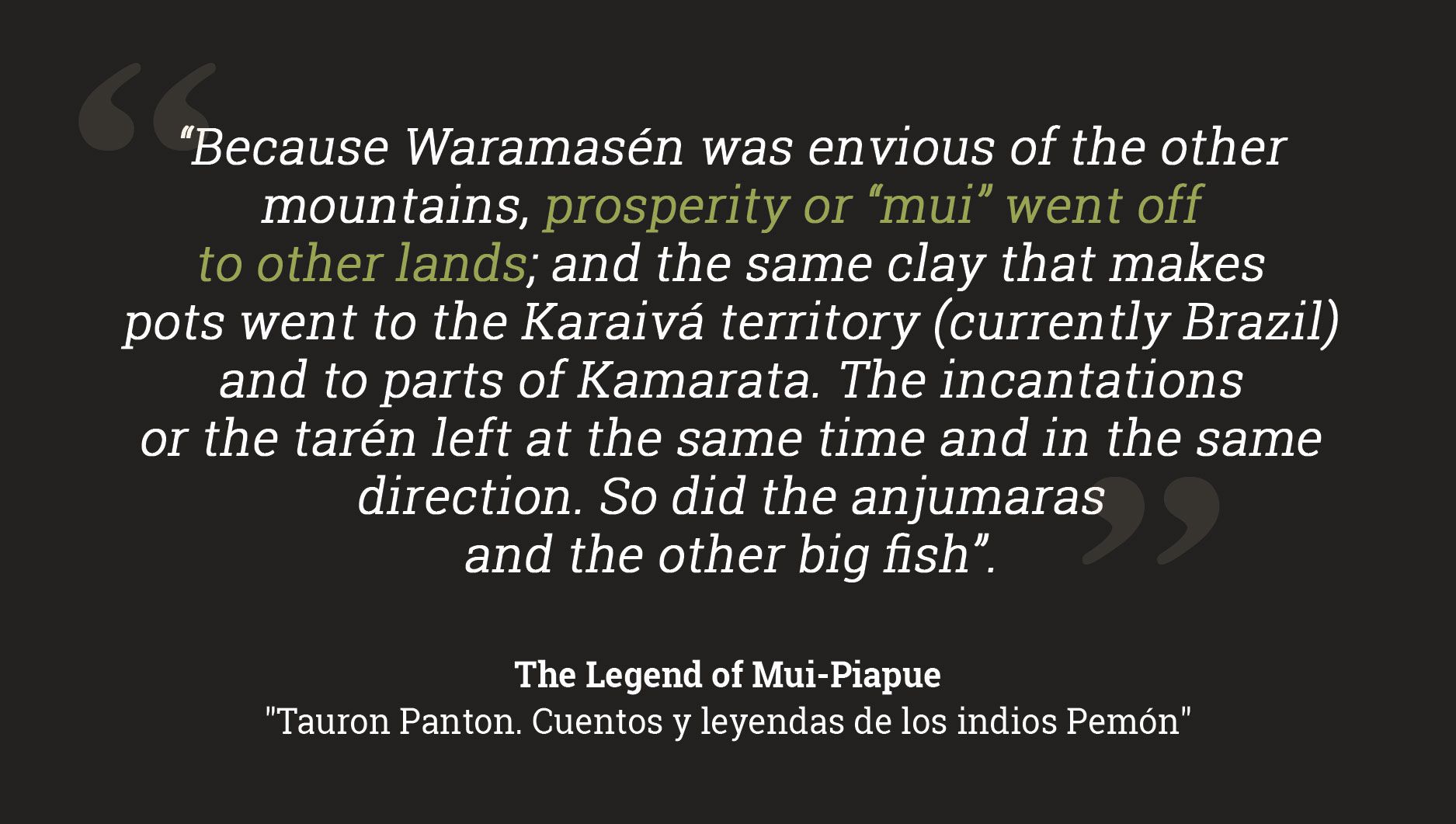
River, mercury and malaria
Gold mining upsets indigenous routines and customs
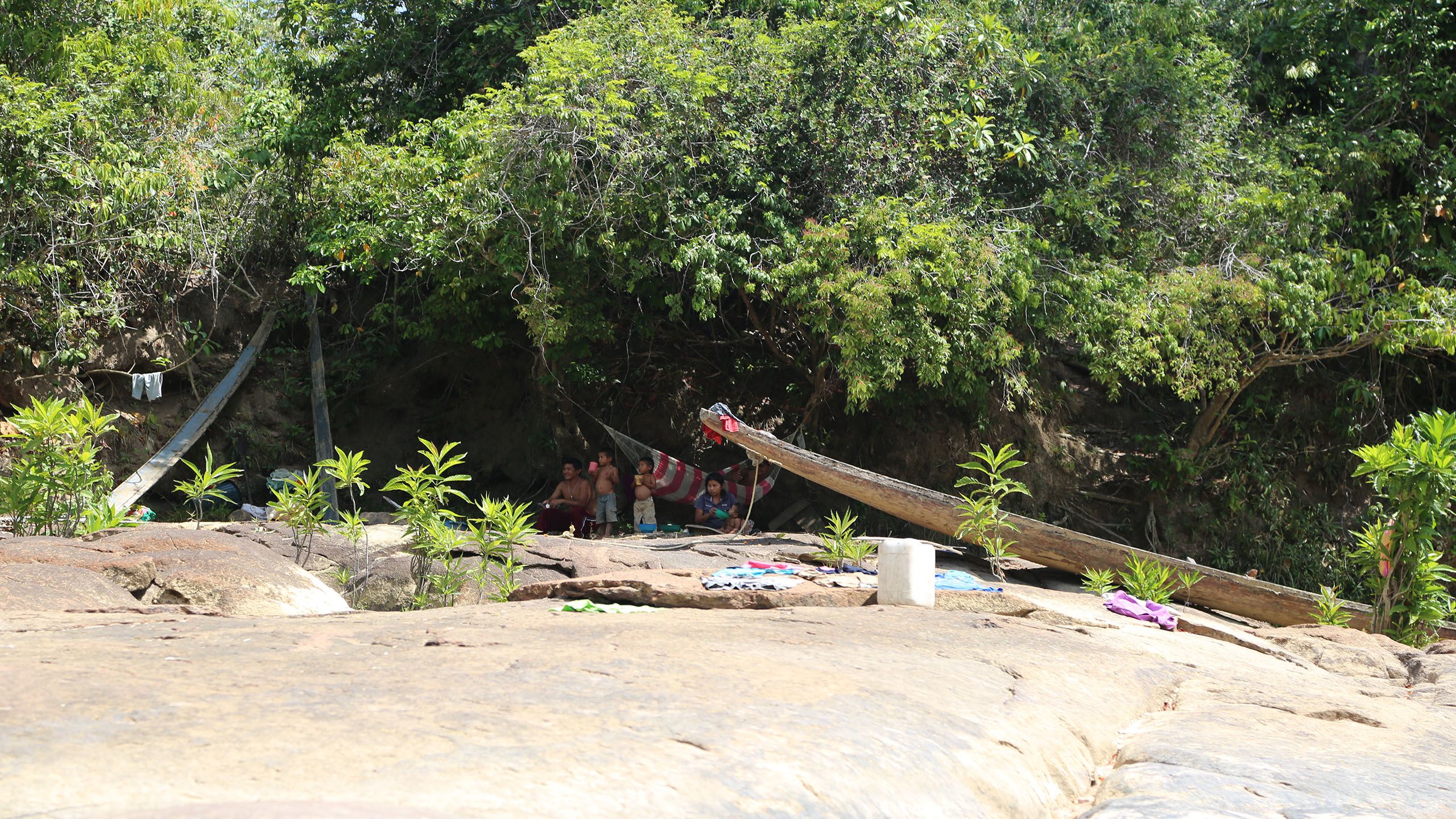
Several Pemón legends mention powerful spirits living inside their rivers and waterfalls. The Mawarí for example live behind hills and waterfalls while the Rató govern the depths of the waters with whirlpools that devour entire boats.
Wei (the Sun) procreated the Makunaima –the lead players in the most spectacular fable told by the Canaima inhabitants- with a woman that Tuenkarón, the daughter of a mouse, sent him from the depth of a well. The Makunaima are the people who cut down Wadakayek, a tree which bore all kinds of fruits. When the tree was cut down, its trunk produced a river loaded with fishes which flooded the savannah. The Mawarí took over the lagoons which had once been the home of the Indians who kidnapped Namai, the young woman who gave name to the Namai-yenpué Lagoon. For the Pemón, water is much more than an indispensable liquid. Water is present in their customs, journeys and their cosmogony.
Paddling on a dugout down the Akanan River reflects the bond that joins the Pemón with their rivers. Women wash close to the rocks, their clothes hang from trees to dry. On their boats, Men fish what they will eat in a few hours. Naked children with honest smiles splash around the shore.
However, when the Akanan opens up towards the Carrao River, the scenery changes. Families are no long seen among the foliage. In their place are makeshift barges filled with hoses and water pumps whose noise is impossible to ignore.
“I feel sorry for my people”, says an innkeeper at Sector II in Pemón territory. He is fearful of the effects mining will have on rivers such as those where thousands of Pemón indigenous people go to on a daily basis. “Who is going to have to live with contaminated waters? We are”, he says with a look of hopelessness on his face.
In the article “‘Tuna, tanno iku’pö’. Significados del recurso hídrico en el sistema de conocimiento del Pemón-Arekunä” published in the Los Andes University Anthropological Newsletter (2015), the authors point out that the Pemón maintain “a relation of dependency with water”. It is an indispensable survival element because that is the place where they find fish, their main source of food. Besides, water is important to their culture because it is the place where “their spiritual and mythical entities interact”. However, according to several testimonies gathered for this report, the Pemón themselves have broken that “values system” so jealously guarded by their elders who are opposed to mining.
“It is important to take care of our water because we depend on it as do our spirits. Not everybody sees it this ways, but that is our culture. Water has always meant life. The river gave us food and fish (…) for the Pemón tribe, the rivers are sacred. But today, with growing river contamination and many of our Pemón brothers going into mining and saying that its part of their economy, well that’s just a contradiction of our indigenous culture and beliefs”, says a member of the Pemón tribe.
There are many Pemón in Canaima who have slowly accepted the idea of living with mining. But there are experts who consider that this coexistence in fact traps them.
“Mining ends up turning indigenous people into pariahs in their own territory. They are stalked by mining and the depredation action of the own State”, says Alexander Luzardo, a former senator and college professor.
Mr. Luzardo’s thesis on illegal mining in Venezuela is that the Maduro administration has applied a strategy to shy away from the responsibilities gold mining brings along, framing the population –indigenous or not- who works in the gold business by making them participants of corruption and destruction. Everyone, including military officers who work around the area, participates in some way or another in mining operations. Whoever doesn’t, says Luzardo, is left astray.
There are some Canaima residents who say that the majority of the population did not have a choice to save themselves from the crisis. The woman who runs an inn at Sector II can remember how a decade ago, residents of the national park would severely condemn the presence of makeshift barges seen today on the Carrao River. But then came hard times for all.
“Before they entered the mines, we were about to shut down everything in Canaima because there was no work, no food and people started stealing from each other. They would steal food, shoes, and clothes. This happened until someone went off to the mines and took 10 people with him. Crime went down”, says the woman who for ten years has worked in the tourism industry.
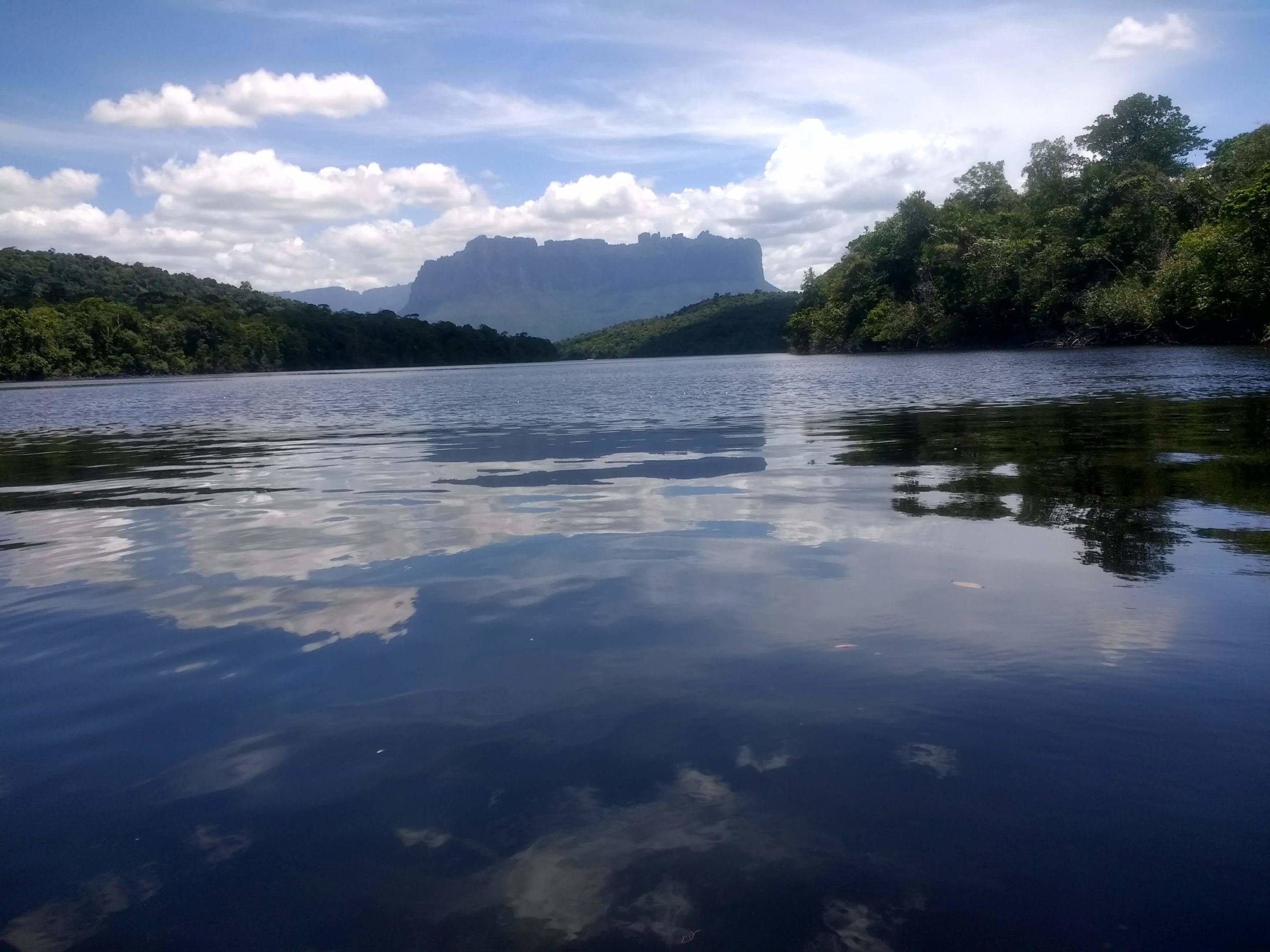
According to this source, there many who raised their voice the moment mining became a problem. But no one listened. “We all protested for a solution but all we got was Padrino López (the Minister of Defense) assuring us that mining had been eradicated, which was a lie. Then Andrés Izarra, who was the Minister of Tourism, came down and told us that they had put an end to prostitution when there was none of that in this area. And finally, Marleny Contreras (another former Minister of Tourism) came also promised to find a solution but no one did anything”, she says.
In the days of protests when mining activity had just begun in Canaima, one of the protesters was Domingo Castro, who is currently the General Cacique of Sector II in Pemón territory. A spokesperson at the time, he called out Padrino López and participated in blocking the national park’s airstrip as a means of pressure.
“We are demanding the presence of President Nicolás Maduro and members of his cabinet who have competency on the matter. So far, we have been ignored. The condition we put was to close the runway indefinitely until the president gets her and we can find a solution to all of our problems, but mainly illegal mining (…) We believe the President has not been informed of this situation because in every press conference they have said that mining does not exist in Canaima National Park which is untrue”, said a testimony interviewed for the Gumilla Center’s SIC magazine.
Today, Castro prefers to remain silent. Contacted by Runrun.es he refused to answer questions on illegal mining and the December 2018 military attack in Canaima.
“If you want to interview me, ask me about tourism. That’s what we know what to do. (Tourism activity) is the main focus of the Kamarata-Kanaimó Sector II Captaincy General for the term 2019-2023. I can’t speak for the other captain general because every one of us represents their sector. I can’t speak for the Council of General Caciques because each one has their vision”, he stated.
Indigenas Pemon Kamarakoto y nuestros visitantes turistas protestamos contra la mineria en el rio Carrao pic.twitter.com/YhMo5nYUnM
— Capitania Kanaimö (@Capkanaimo13_16) June 1, 2015
Although she does not approve of mining operations, the innkeeper is conscious that the majority of the people living in Canaima do not have enough means to support themselves. “I thank God because at least I have a place to stay and food on the table. But I also ask God to end all of this because this is something we have lived with all our lives and we do not want mining in our community. But it’s not our fault that many in our community have gone out to find a living because how are we supposed to live in Canaima”, she questions.
The innkeeper’s last statement is backed by Luzardo who says that mining in Canaima produces more victims than criminals. “You can’t hold the indigenous people solely responsible. Those involved in mining are groups coopted by the government. It’s a mistake to think that it all begins with them. Along the mining chain you find the “sindicatos”, common criminals, the guerilla which grows with smuggling operations. What’s important to remember is that this is an environmental crime committed by the State”, he says.
The reasons the Pemón are attracted to the mines are confirmed in the report entitled “The Current Gold Mining Situation in Canaima National Park: a World Heritage Site in Venezuela”, written by the NGO S.O.S. Orinoco and presented to UNESCO and the International Union for Conservation of Nature (IUCN).
“Given the high prices paid for gold, mining and trade related to mining are the only alternatives that allow for personal or family income and can cover food, transportation and health costs”, says the report.
Professor Luzardo, who has authored several mining legislations passed by the current National Assembly, warns that mining generates an environmental damage to the Pemón’s natural habitat by contaminating the water they drink and the animals they feed on with cyanide and mercury. Mining also modifies the way in which indigenous people relate with nature and at the same time creates an economic framework which depends on third parties who are linked to money laundering and illegal traffic of merchandise.
To S.O.S Orinoco, mining activity makes a social impact on the Canaima Pemón people because it confronts indigenous communities who support mining with those that are against it. Mining also creates a greater dependency with the “Criollo sector”, minimizes economic diversity and exposes the population to crime and violence.
Another factor to take into consideration is that mining accelerates the loss of cultural identity, transculturation and the “rupture of traditional social structures”. It also increases diseases caused by insects (such as malaria) and produces mercury poisoning.
Canaima’s worth in “gramas”
A view of Amaruai Tepui from Camp Iwana Merú, shortly before arriving to Campo Carrao.
A view of Amaruai Tepui from Camp Iwana Merú, shortly before arriving to Campo Carrao.
Mining economy has displaced what was once held together by tourism. Residents in Canaima confirm that everything, from gasoline to food, is charged according to the price of a “grama”, which is how they call the grams of gold found in deposits across Southern Venezuela.
“There’s no mining without gasoline”, says Luzardo who knows that fuel is not only used to transport gold but also to run the water pumps used for the suction of the river beds and transportation down the river to remote zones which can only be accessed by boat or by plane.
Gasoline is distributed in Southern Venezuela by quotas. Demand is so high that it is not being used by charter planes for tourism purposes but for air transportation of food and equipment to Arenal, Campo Carrao en other mining zones in Western Canaima, according to various sources in the national park.
“Only the ‘jetstreams” belonging to Transmandú (airline) can fly to Canaima because they manage to find gas. Other companies who use a Cessna 206 don’t’ fly this route anymore”, says a tourist operator with more than 30 years of experience. He often refers to mining as a sort of inoperable cancer, which spreads around several zones. Metastasis has already set in parts of this national park and he feels impotent knowing that he cannot stop the death of this natural paradise.
The guide says that bringing tourists to Canaima this year required transporting his clients to La Paragua, a mining zone inside Sector I of Pemón Territory. There, they board a Cessna 182, a three-seater airplane which uses gasoline intended for cars, to reach the tabletops.
Another operator can remember a time in the 90’s when the national park’s airstrip would fill up with small aircrafts. He says that Kanaimó alone received up to 300 tourists a day, while a similar number would go to Kavac, Uruyen and Kamarata and leave on river, cave, waterfall and tabletop expeditions.
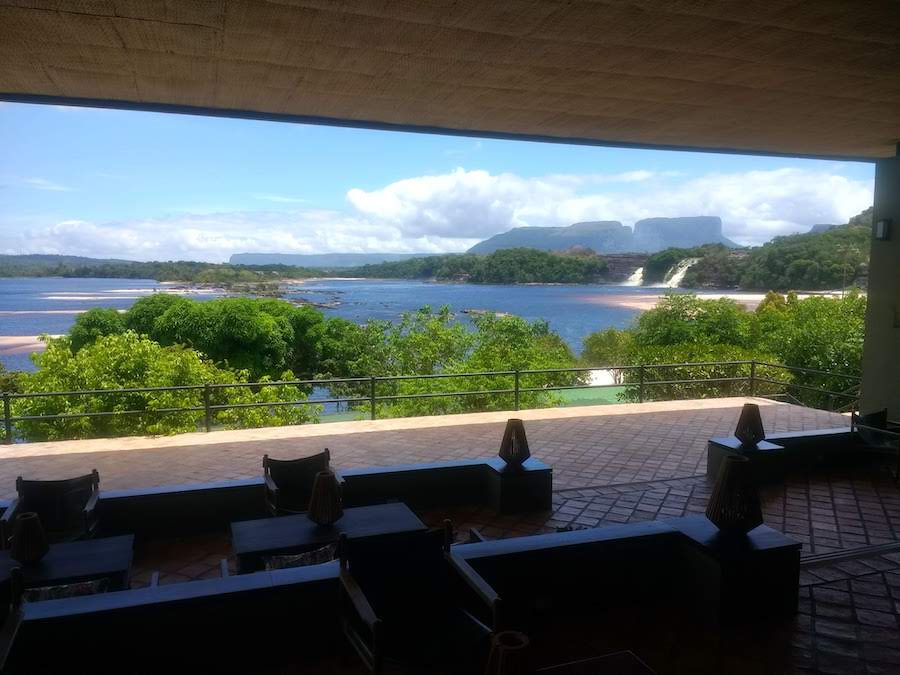
The empty terraces of the former Venetur Canaima Camp. Photo: Lorena Meléndez
The empty terraces of the former Venetur Canaima Camp. Photo: Lorena Meléndez
Canaima’s lodging facilities also ran out of guests. For Nicolás Fumari, president of the Venezuelan Travel Agency and Tourism Association (AVAVIT for its acronym in Spanish), prohibitive costs, even greater than those found in the international market, was the reason. Occupancy in the national park is equal to the national average, he says. For every 10 rooms available in the national park, 7 are vacant.
Mr. Fumari does not exaggerate. During the low season, a walk from Kavak to its caves means bumping into one or at most two families. The campsites at Kanaimó are mostly empty and it is not uncommon to arrive to one of its lodges and find out that you are the only guest.
“We worry about the informality in which the topic (of mining) is being dealt with in Canaima, as we are ignorant about the effects it could bring to those who live in the park. We know this does not happen in tourist facilities or lodges in Kanaimó, but the information given reaches potential tourists and it affects their desires to come to Canaima”, says Leudo González, director of the Higher Council of Tourism (CONSETURISMO for its acronym in Spanish).
“Deforestation is painful to watch. When you fly over Camp Uruyen, you can see how the tributaries of the river are contaminated”, says Fumari, in reference to mining operations along the borders of the national park, on the other side of the Caroní River. “The government says it will extract 800 tons of gold as if to make us feel proud when regretfully the entire country will have to pay the price”, he adds.
“There’s a mining economy here and that is worrisome as it affects the environment, diseases and vices”, says a missionary of the region who looks at the changes in Canaima with concern. His greatest fear is that the caramel-colored waters of the Carrao River turn into ochre like the Icabarú, one of the main tributaries of the Caroní River in the mining area of the Gran Sabana municipality.
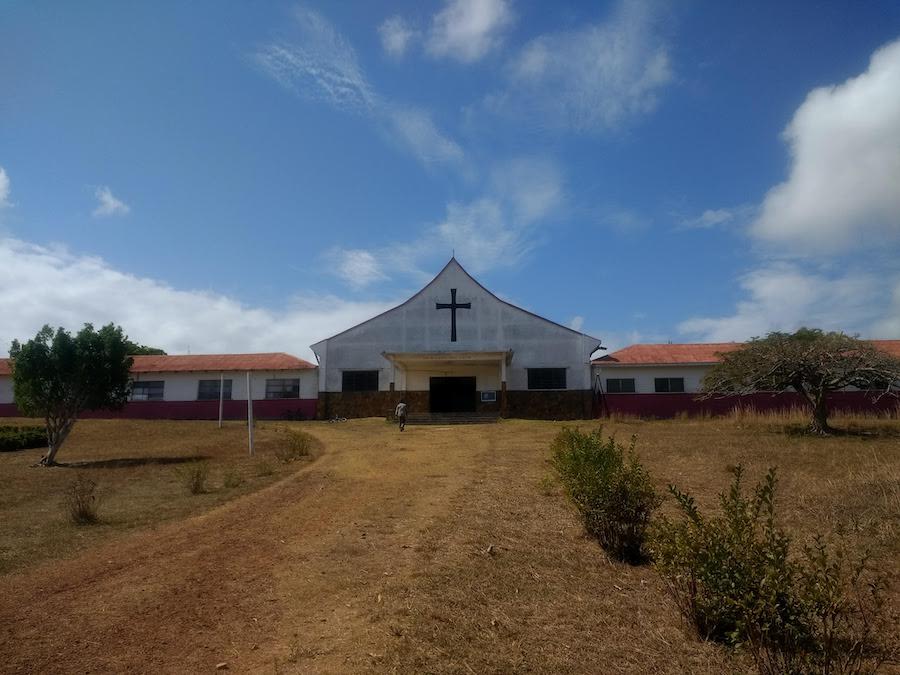
The Kamarata Mission is the site of one of Canaima’s schools. Photo: Lorena Meléndez
The Kamarata Mission is the site of one of Canaima’s schools. Photo: Lorena Meléndez
Among these social changes, the lack of student attendance in local schools alarms him. Of the 300 students enrolled a few years back at the school he works in, only 100 remain. “They no longer care to study; all of them have gone to the mines”.
A tour guide in Canaima concurs with the missionary’s statement as he knows that many mothers around the area leave their children unattended to go work at Campo Carrao or Arenal. The situation, he insists, has led to school abandonment and teen pregnancy.
The Pemón who live in the national park have also seen the rise of malaria. At an outpatient clinic in Kanaimó, a doctor confirmed to Runrun.es that she receives a patient infected with malaria at least once month. Almost all of them, she says, coming from other communities of the Sector II in Pemón territory. The majority come from mining zones.

Outpatient clinic. Photo: Lorena Meléndez
Outpatient clinic. Photo: Lorena Meléndez
The number of medical cases in Canaima coincides with the number of cases registered throughout Venezuelan mining zones. In November 2018, the World Health Organization published its World Malaria Report and stated that the number of patients in the last few years in Venezuela was counted by the hundreds of thousands: 138,000 cases in 2015, 240,000 in 2016 and 411,000 in 2017. This from an organization who in 1961 certified Venezuela as the first country in the world to eradicate malaria.
“The rise in malaria cases is greatly related to the impossibility of affording antimalarial medication, deficient prevention programs and the transit of people infected with malaria in gold mining areas around Bolívar state to other areas in the country with ecosystems prone to malaria”, says the study.
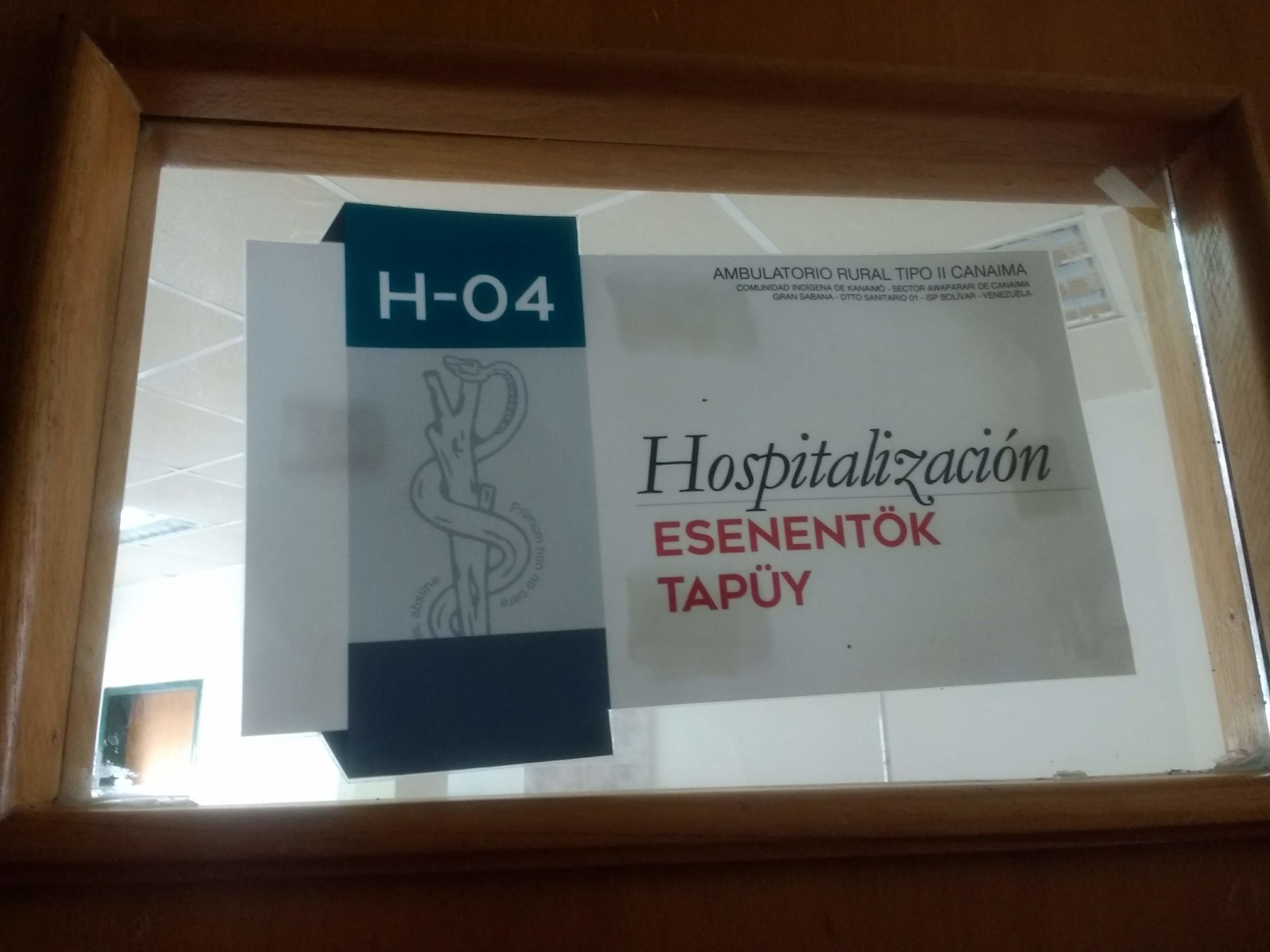
Hospitalization area. Photo: Lorena Meléndez
Hospitalization area. Photo: Lorena Meléndez
That contested relation
Resource preservation has also been left behind by deinstitutionalization. Not only has Inparques knowingly ignored the situation, enterprises belonging to the State such as Electrificación del Caroní (EDLECA), which used to have a fire prevention program also abandoned its role inside the territory. This was the same company who created the “Master Plan of the Caroní Basin”, a plan which called for the “enhancement of conservation in specific areas due to the enormous richness of natural resources, biological diversity and unique (endemic) species, as well as areas with a high water production index”.
This environmental preservation guaranteed the integrity of all natural resources that intervene in the hydrological cycle. “Infrastructure associated to the hydroelectric complex dependent of the Caroní River basin are of useful lifespan; therefore it is the policy of the State to guarantee its integrity and running operation”, says the plan.
In the book ““Biodiversidad del Parque Nacional Canaima. Bases técnicas para la conservación de la Guayana venezolana”, published by La Salle Foundation, the authors mention that the absence of clear regulations –whose compliance must be monitored by the current administration– goes hand in hand with environmental degradation.
“When the measures, mechanisms and government bodies that control access and regulate the use of natural resources are absent, are not applied or are not effective in achieving its prevention and conservation goals, an institutional failure in the procurement of natural resource conservation will occur. The challenge behind common resource conservation lies then in establishing clear and legitimate rules that prevent the non-sustainable use of natural resources and which benefit all interested parties as well as establishing appropriate incentives and disincentives so that said rules can be obeyed”, says the book.

However, the aforementioned authors argue that success of environmental policies also lies in the comprehensive participation of all interested parties and in the recognition of their rights. Precise knowledge of the area’s environment as well as its opportunities and threats is also necessary.
According to the book, none of the aspects mentioned above have been ever implemented in Canaima. Since its declaration as a national park in 1962, under the government of Rómulo Betancourt, the environmental policy went against the Pemón tribe’s vision, way of life and management of lands. To support this theory, they quote a statement given by Carlos Lott who was Captain General of Sector II in Kamarata:
“They created Canaima National Park without consulting us. Then, Inparques established other rules and regulations regarding the management of natural resources. They were tough regulations which forbid us to hunt or cultivate our conucos. At the time, Inparques was considered enemy number one for prohibiting customary traditions of our people. The time has come to break a new barrier which has generated so many needs”.
“Due to the Pemón peoples’ profound socio-economic and cultural transformation in its contact with Western culture, its natural resource management institutions garnered successes and failures which, as in the case of other indigenous groups, are attributed to: 1) Demographic growth; 2) changes in the settlement pattern; 3) changes in traditional practices for the use of land; and 4) loss of traditional ecologic knowledge reflecting the adoption of new values and customs”, write the authors.
A sample of these contradictions was the 1991 “Spatial Plan and Regulatory Framework For the Use of the Western Sector in Canaima National Park” (La Gran Sabana). The fifth target of this plan was to “safeguard cultural values of the Pemón ethnic group, as well as its settlement areas and conceived environmental traditions”. However, in Chapter III the plan established restrictions on agricultural activities which supposed a problem for existing indigenous agriculture in the area.
That same document stated that despite transculturation, the Pemón people were deeply rooted by their cultural codes.

Photo Lorena Meléndez
Photo Lorena Meléndez
Article 9, Chapter IV of the spatial plan related to the national park’s resources addresses this issue: “The most representative historical-cultural asset [the park counts with] is the presence of the Pemón indigenous population, settled in the region since ancient times and who, despite important changes in its traditional way of life, still maintain their cultural identity through their language, family organization, oral traditions, magical-religious belief system and craftwork”.
Mining has been going on for years in Canaima, even before it became a national park. Sources interviewed at Kanaimó explained that until the late 1960’s, gold mining using artisanal methods were employed in the Arenal region until tourism and restrictions imposed by Inparques drove the Pemón away.
Mining practices without machines, chemicals or contaminating processes were common on the other side of the park at La Gran Sabana, even after it became part of a protected area. Manuella Gallini, a member of the “Mujeres al Agua” Foundation explains in an article that mining in the 1980’s was a resource used by indigenous people to meet their basic needs. Mining “did not imply the abandonment of their traditions like hunting or tending to their conucos [plots of land]. Work in mayú (collective work to help others) and family union continued to be the base of their cohabitation and culture”, says the article.
In the article entitled “El pueblo indígena entre oro y tradición”, Gallini argues that: “Gold represented one of the most economic resources available, a go-to petty cash in times of need. In those years, the ones seizing the riches were Canadian multinationals. For example, in the mid-1990’s, they gave no economic benefits to the community of ApoiPo, leaving only sand and destruction behind. Little by little, this destructive mentality began to contaminate indigenous purity until today, when gold fever has taken over a great part of La Gran Sabana. In sectors 6 and 7, which belong to the Area under Special Administrative Regime (ABRAE), a great part of the indigenous population is involved in gold and diamond mining. What were once sacred assets like water and rivers represent sources of income today. Destruction of old-growth forests and mercury contamination don’t matter when there is money involved; much less when it is thought that this money can be used to redistribute riches to all. According to Ricardo Delgado, former Mayor of Santa Elena de Uairén, mining activity in indigenous territory is justified and endorsed by the Organic Law of Indigenous Peoples and Communities (LOPCI for its acronym in Spanish)”.
No Clear Limits
Another factor among the absence of rules for the preservation of Canaima’s environment is the inexistent demarcation of indigenous lands. This is a constitutional right which has not been fulfilled since 1999, when the new Venezuelan constitution ordered by Hugo Chávez was enacted.
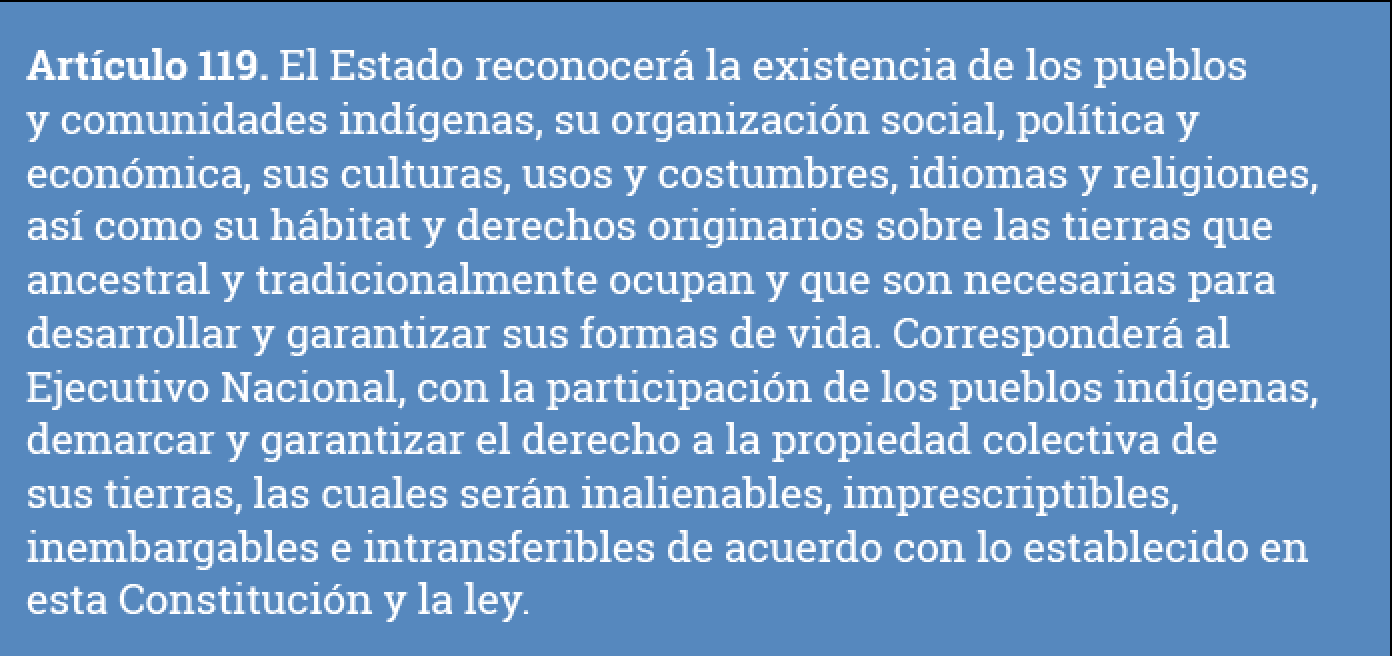

Chapter III of the Organic Law of Indigenous Peoples and Communities (LOPCI) is entirely devoted to the demarcation of lands. In fact, Article 23 goes beyond what is stated in the Constitution and indicates that in order for demarcation and ownership to be established the native peoples “cultural, ethnological, ecological, geographic, and historic realties as well as the indigenous toponymy must be reflected in the corresponding documentation”.
Further on, the Law regulates that indigenous people can make use of the land in whatever form they choose to.

Vladimir Aguilar, attorney specialized on indigenous rights, explains that the Pemón have a legal view regarding mining operations in Canaima which contrast with the notion that the Areas under Special Administrative Regime (ABRAE) are “untouchable areas”, when in reality they must be touchable if communities, like the Pemón tribe, are to live there.
“The national park is not an indigenous land. It is a subsystem within Pemón territory. The absence of land demarcation –the few existing property deeds are ambiguous and seem more like agrarian provisional permits- prevents regulation on how far can mining operations go.
Mr. Aguilar does not rule out that indigenous mining is a form of resistance. When the State is also involved in extractivism and does not tend to the peoples emergency needs, the natural reaction is to get up and self-sustain with gold.
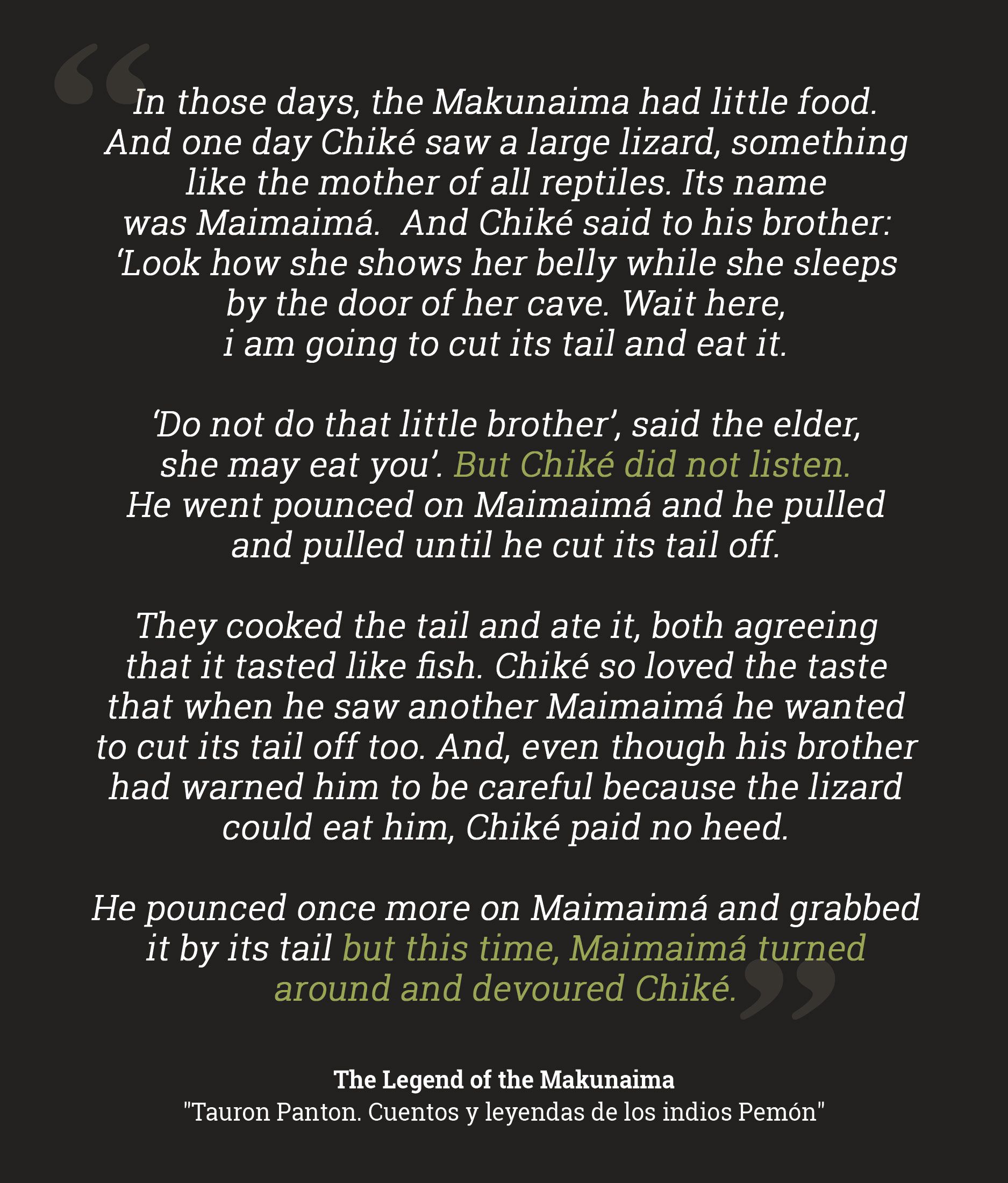
Timeline
An overview of the natural World Heritage Site’s strengths and threats


June 12: Canaima National Park is created by Presidential Decree N° 770.

The “Master Plan for Canaima National Park” is the first spatial plan drafted for an Area under Special Administrative Regime (ABRAE).
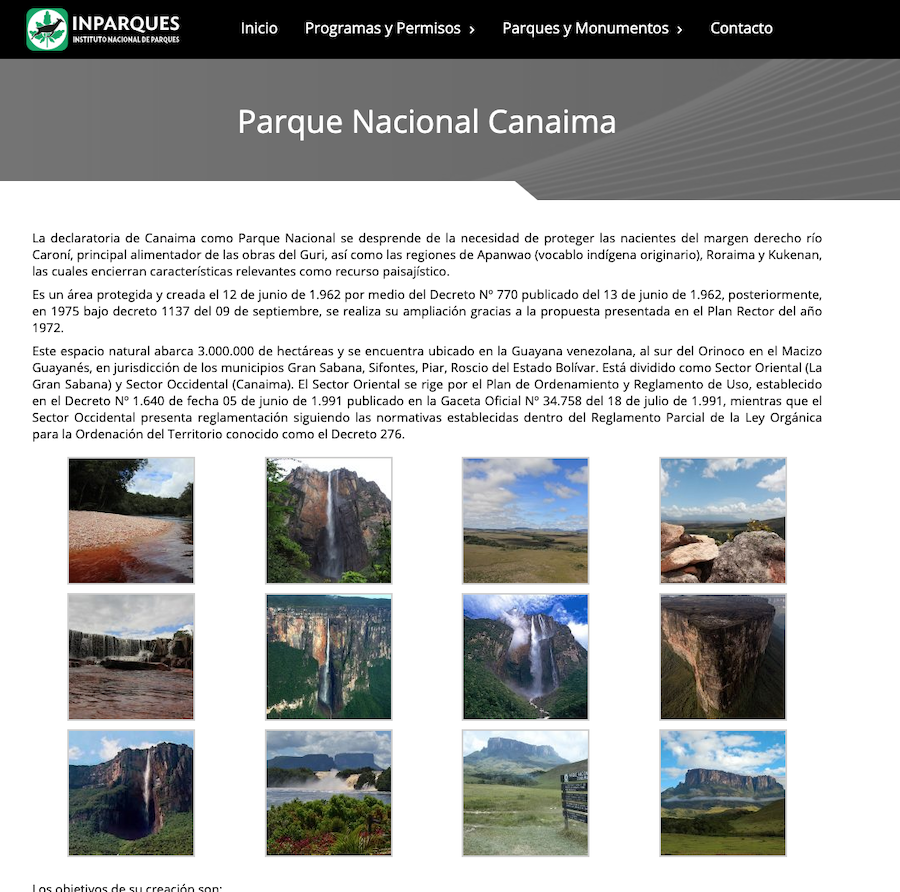

The borders of Canaima National Park are extended.

The Ministry of Environment and Renewable Natural Resources is created. It is the first of its kind in Latin America.

The Organic Law of Territorial Organization is enacted. This law formally establishes the Areas under Special Administrative Regime (ABRAE), which include areas that have been decreed by the National Executive Power to fulfill productive, protector and recreational functions because of their environmental characteristics and potential.

UNESCO declares Canaima National Park a World Heritage Site.

September 28: The Mining Law is enacted.

October 12: The “Guaicaipuro Mission” is formally launched. Originally ascribed to the Ministry of Environment and Natural Resources, it will later be transferred to the Ministry of Participation and Social Development and finally to the Ministry of Indigenous Peoples. Its purpose is to promote “the harmonious and sustainable development of indigenous peoples, strengthen the capacity of community management; promote the demarcation of habitats and lands and development of the traditional inhabitants in order to guarantee their social rights.
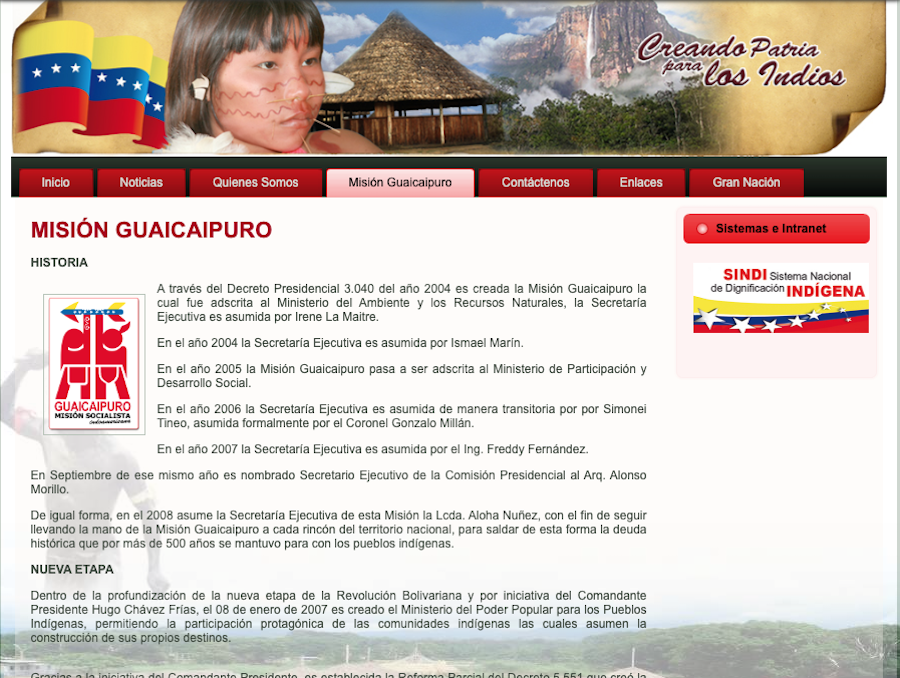
Creation of the “Piar Plan”, a social program aimed at small-scale and artisanal mine workers.

The “Piar Plan” is transformed into the “Piar Mission”.
The Organic Law on Indigenous Peoples and Communities (LOPCI) is enacted.

The Organic Law of Territorial Organization and Spatial Planning is enacted.

The Ministry of Indigenous Peoples is created. Official Gazette N° 334.396. https://app.box.com/s/ssq9s9ivixrx4hwxpkx3d36zw4adpl15

January 4: Alejandro Lanz, director of the Venezuelan Center for Environmental Research (CIEV for its acronym in Spanish) condemns illegal mining in the borders of Canaima and claims that 300 mining teams controlled by garimpeiros from Brazil, Guyana and Colombia are illegally trading more than 600 kilograms of gold a month. https://www.aporrea.org/actualidad/n148182.htm
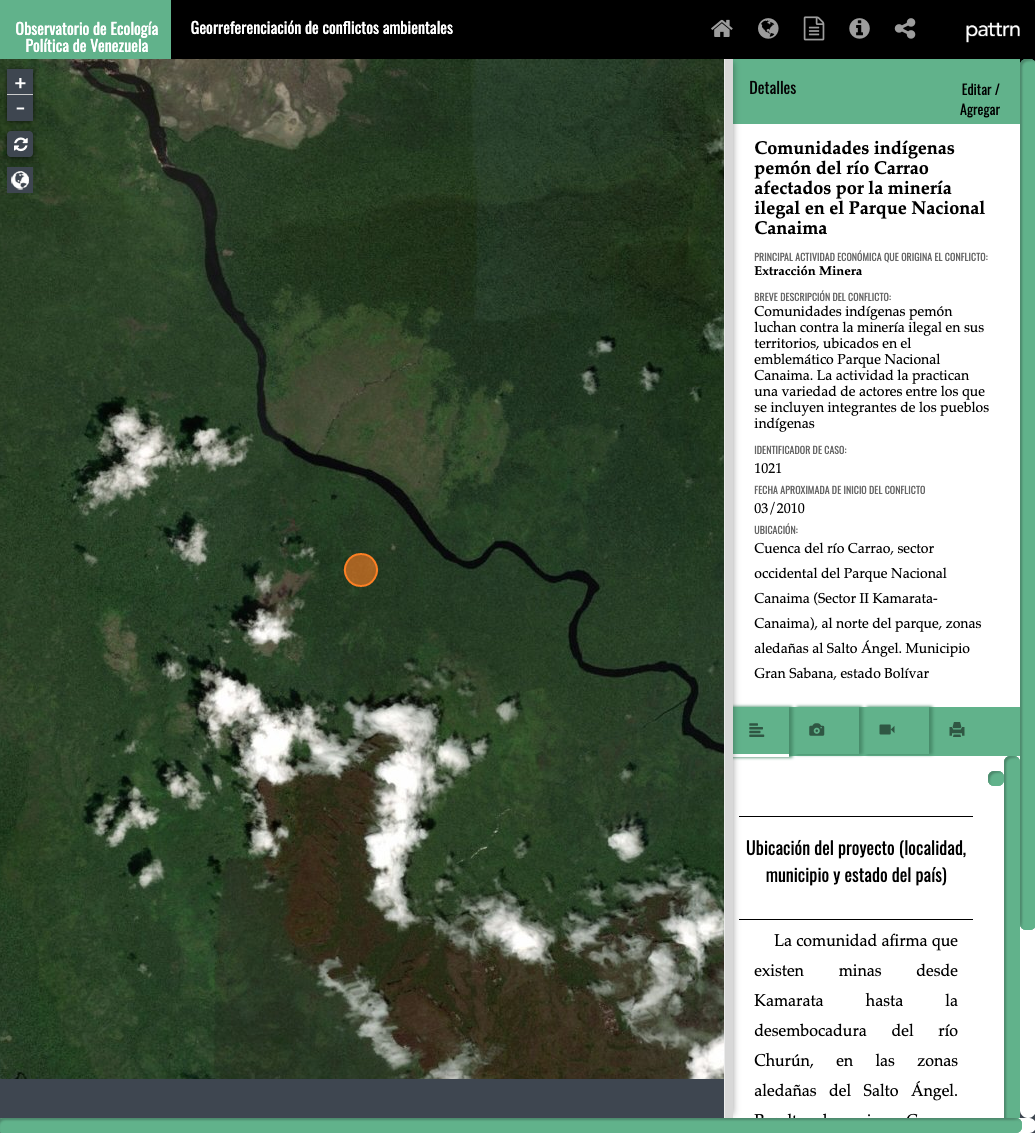
April: The “Caura Plan” is launched. This plan calls for the protection of the jungle from environmental crimes such as illegal mining, deforestation and river contamination by mercury, a mineral used to extract gold. 10,000 Venezuelans belonging to the Yekuana, Sanema and Joti y Jibi tribes live around this basin.

November 7: Venezuelan newspaper El Correo del Caroní reports that illegal mining penetrates Canaima National Park.
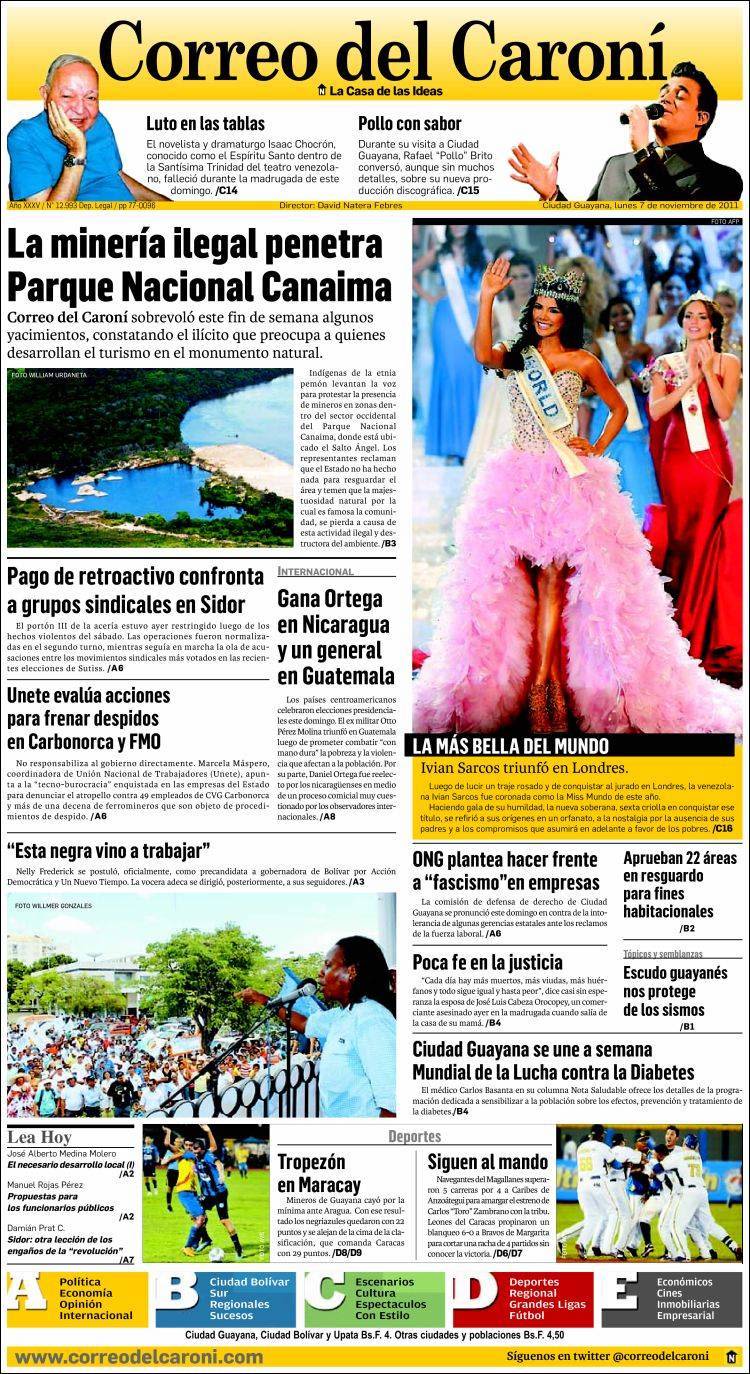

The General Caciques Council and the Pemón Territorial Guard are created.

The Comptroller General of Venezuela warns about the existence of mining activities without a permit that are endangering the park’s conservation: “An on-site inspection held on May 14, 2014 in the Indigenous Community of Campo Alegre, located in the Western sector of Canaima National Park, revealed the existence of mining activity in the proximity of the Kukenán River. Gold is being extracted with the use of gasoline operated water pumps and conveyor belts”.
The audit reveals that illegal mining originated in the area because the authorities failed to take environmental measures which could have avoided the deterioration of the ecosystem. “Excessive and irrational” gold mining operations by the residents of the Campo Alegre community contributed as well. The report concludes that “serious contamination damage has been caused not only to the main water source in the state of Bolívar and other parts of the Venezuelan territory but to Canaima National Park’s ecosystem as well”.
March 20: The Presidential Commission for the Protection, Development and Promotion of Licit Mining Activity in the Venezuelan Guayana Region is created by Decree N° 841, published in Official Gazette N° 40.376. Its main goal is to safeguard the biological, mineral, hydric and hydroelectric riches of Bolívar state.
June 10. The Minister of Tourism, Andrés Izarra is interviewed in the television program “En Contacto con Maduro” (Episode 11) broadcasted by the State-operated channel Venezolana de Televisión. During this interview, Izarra condemns the current depredation caused by “illegal mining” inside Canaima National Park, especially in the Carrao and Caroní rivers.
The Minister shows evidence of makeshift barges all across the park and states that illegal mining has become “the main threat of this World Heritage Site; it is devastating the park”. He shows aerial photographs which evidence areas “devastated” by mining “close to Campo Carrao” and says that “the mines have also reached Kavac”.
Mr. Izarra also says that “this will bring consequences, especially to the Guri Dam. The Caroní and Carrao rivers flow into this important reservoir and the sediments are affecting the turbines which generate 70% of the country’s electricity”. Towards the end of the program, he mentions that comprehensive action from the State is necessary in order to seriously attack the problem.
June 10: Tourism operators in the Western sector of Canaima National Park paralyze their operations due to fuel dispatch restrictions imposed by the Government.

June 26: The Public Prosecutor’s Office detains 11 people for their alleged participation in illegal mining in Bolívar state after six investigations begun in 2014 from the Division of Environmental Defense and Environmental Crime who requested interim environmental measures to preserve biological diversity.
October 29: Valentina Quintero, a journalist specialized in tourism, condemns the damages mining has caused inside Canaima National Park. She makes reference to the decline of tourism in the Canaima Lagoon (Western sector).
La minería ilegal acaba con PN Canaima. Este desastre ocurre en Campo Carrao, al lado Salto Ángel. Da dolor y rabia pic.twitter.com/M5ZeGEnHN2
— Valentina Quintero (@valendeviaje) October 29, 2014
Otro destrozo minero junto a río Caroní, al lado laguna Canaima. Defenderemos Canaima con todo. No a minería ilegal pic.twitter.com/y0q65Cbitn
— Valentina Quintero (@valendeviaje) October 29, 2014
November 3: On account of contamination prevention in the area, the Public Prosecutor’s Office orders the dismantling of nine tourist camps operating illegally in Canaima National Park.
November 6: The Minister of Defense, Vladimir Padrino López, says that “Operation Roraima” has dismantled more than 200 mining camps, 100 mines and evicted 870 people from Canaima National Park. “It is impossible to address the situation of illegal mining without the involvement of the indigenous community”, he says in a televised statement. Before the year ends, he promises, the Government shall have “freed the entire Canaima Park from the depredating capitalist model”.
November 13: Valentina Quintero reports again on mining in Canaima. She warns that there are mines inside the Aponwao, Kamá, Quebrada de Jaspe and Mirador del Oso waterfalls. This is the first time she mentions the Pemón people as destructors of the environment.
Minería se instaló en La Gran Sabana. Minas en Saltos Aponwao, Kamá, Quebrada de Jaspe y Mirador del Oso. Pemones destruyen PN Canaima
— Valentina Quintero (@valendeviaje) November 13, 2014
November 24: ABC España reports that mineral extraction is putting Canaima National Park in danger.
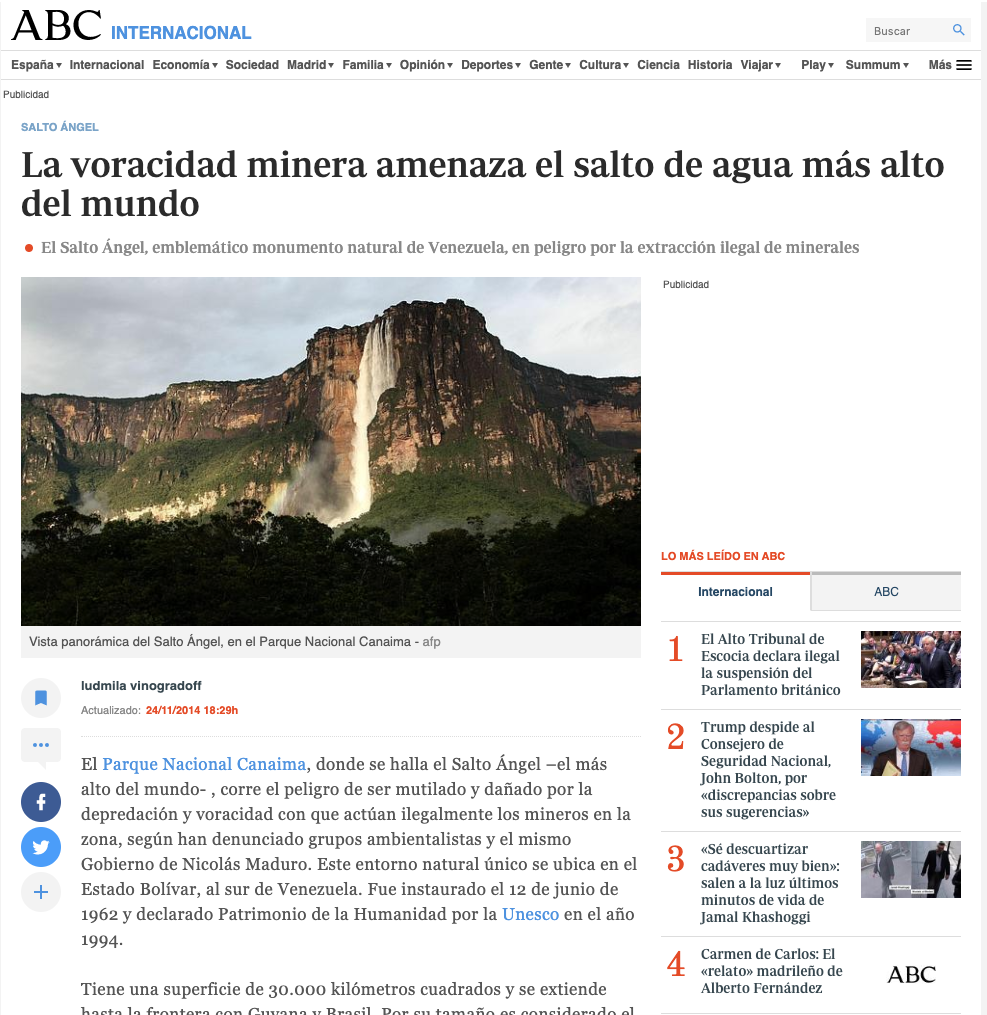
December 16: “Canaima National Park has been freed from illegal mining”, says the Minister of Defense Vladimir Padrino López. He announces the dismantling of seven camps in a joint operation with the Aviation, the Navy, the Army and Special Forces of the Bolivarian National Armed Forces. According to the Minister, 262 camps have been dismantled since the introduction of “Operation Roraima”.

May 31: Canaima residents protest against contamination of the Carrao River due to mining activities. A Pemón indigenous man assures that mining in the area began in 2010.
June 3: The Minister of Defense, Vladimir Padrino López denies the existence of mining in Canaima.
June 4: The Pemón indigenous peoples end their protest after President Nicolás Maduro promises to eradicate illegal mining.
Pemones levantan protesta en Canaima tras promesa del gobierno de erradicar la minería ilegal http://t.co/wfurf20wwN pic.twitter.com/OazB52M3YJ
— NTN24 Venezuela (@NTN24ve) June 4, 2015
June 9: Domingo Castro, a spokesperson for the Pemón peoples, assures in a television interview that illegal mining in the Carrao River is real. “You can’t cover it up”, he says, noting that the changes of color in the water between the months of February and March are evident.
June 11: Canaima National Park celebrates its 53rd anniversary. Approval of a Bs. 129.2 million maintenance fee is announced.

February 24: The “National Strategic Development Zone” or Orinoco Mining Arc is formally introduced (Decree N° 2.248, Official Gazette N° 40.855). This zone covers 111,846.7 km2 (11% of the national territory). Controversy arises on how this mining mega project will affect Canaima.
May 13: The Platform for the Invalidity of the Mining Arc Decree is launched. It is composed by several political organizations, social movements and activists who are against the mining megaproject backed by Nicolas Maduro’s government.
June 14: The National Assembly agrees to repeal the decree that established the Orinoco Mining Arc. Constitutional authorization to the Executive Power regarding the decree 2.248 dated 02/24/2016 in which Nicolás Maduro creates the mining megaproject is denied.
October 20: The National Assembly begins discussions on the Bill of Law entitled “Organic Law for the Creation and Protection of the National Mega Freshwater Reservoir, Biodiversity and Hydroelectric Potential in Southern Orinoco and the Amazon Rainforest”.
November 22: Caciques of the Pemón tribe establish a set of mining regulations for gold extraction.

June 10: The illegal “San Agustin” airstrip, located in Campo Grande (Angostura municipality), in close proximity to Canaima National Park is shut down.
The former Minister of Environmental Mining Development Jorge Arreaza announces formal talks with indigenous authorities to prevent further development of illegal mining in protected areas. The topic of area rehabilitation is also among the discussions.

January 11: Indigenous inhabitants of the Canaima Lagoon protest by closing down the airport’s runway.
Protesta comunidad indígena Kanaimo cierra pista de aterrizaje del Parque Nacional Canaima. pic.twitter.com/MpggtsiyAm
— @AereoMeteo (@AereoMeteo) January 14, 2018
March 4: NGO S.O.S. Orinoco claims that illegal miners have contaminated the Supamo River with mercury, cyanide and other hazardous pollutants.
A 49kms del Parque Nacional #Canaima Patrimonio de la Humanidad @unescowhc, mineros ilegales devastan el Rio Supamo con #Mercurio, #cianuro y otros contaminantes, mientras #FANB y @CAMIMPEG_FANB se benefician y son cómplices de la destrucción. https://t.co/FXgGjkxHyQ #SOSOrinoco pic.twitter.com/1kHjFDAnlF
— SOS Orinoco (@SOSOrinoco) March 4, 2018
20 Mayo. Pemones denuncian falta de bolívares en Canaima y que los pagos en la zona se están haciendo en oro y en dólares.
Donde está la soberanía que tanto predica @NicolasMaduro ?Donde están los billetes Venezolanos? En Canaima se paga ahora en Dolares y en oro porque los Bolívares desaparecieron pic.twitter.com/8Wy7SlZRCy
— Pemón Arrecho (@pemonarrecho01) May 20, 2018
July 23: Brigadier General Roberto González Cárdenas accuses the Pemón tribe, specifically Lisa Henrito, their leader, for promoting an alleged “secessionist movement” in Southern Venezuela.
The Indigenous Federation issues a statement against the criminalization of the Pemón leader.
July 24: The Council of General Caciques (Sectors II, III, V, VII, and VIII), main authority body of the Pemón tribe, release an official statement against the accusations set by Brigadier General Roberto González Cárdenas
July: The NGO S.O.S. Orinoco publishes its report on mining in Canaima National Park.
August 8: Amnesty International informs that a Venezuelan military official has accused Venezuelan indigenous environmental rights defender, Lisa Henrito, of “treason” due to her activism in defense of the Pemón Indigenous Peoples traditional territory.

October 5: The Commanding Officer of the Operational Strategic Command of the Bolivarian Armed Forces (CEOFANB), Remigio Ceballos Ichaso and the Ministers of Culture, Ernesto Villegas, Indigenous Peoples, Aloha Nuñez and Mining Development, Víctor Cano, meet with representatives of the Pemón tribe in Canaima to define attack measures against illegal mining in the Canaima National Park
En Parque Nac Canaima, Cmdte @ceofanb AJ @CeballosIchaso, Min @VillegasPoljak, Min @AlohaNueez y Min @vcano75 se reúnen con representantes de Etnia Pemon, para temas inherentes a la protección del Parque Nac y acciones para atacar la minería ilegal. “Integrar es vencer” pic.twitter.com/lCpmMAssra
— CEOFANB (@ceofanb) October 6, 2018
October 8: 22 indigenous communities organize a protest by closing a trunk road in Southern Bolívar (Troncal 10). These communities denounce that growing number of illegal gold miners in the area is in clear violation of their traditional territories.
October 14-15: Journalist Valentina Quintero publishes a video on her social media which shows how illegal mining in Canaima has destroyed Campo Carrao and the Carrao River.
La minería está dentro del PN Canaima. Ustedes lo saben @vcano75 @EcoMineriaVE y @HeryckRangel @MiEcosocialismo pic.twitter.com/vLUvXNdkQT
— Valentina Quintero (@valendeviaje) October 15, 2018
La mina de Campo Carrao es cada vez mas grande. Ustedes la vieron el viernes 5 de octubre. Los 3 estuvimos en Canaima el mismo día. @vcano75 @EcoMineriaVE @HeryckRangel @MEcosocialismo pic.twitter.com/B74a9uxIZE
— Valentina Quintero (@valendeviaje) October 15, 2018
October 15: Endes Palencia, Vice Minister of Citizen Prevention and Safety, confirms the launching of the operative action “Tepuy Protection Plan 2018” (Operation Tepui Protector 2018) which includes a “boarding operation” in Canaima National Park. This “civic-military plan is aimed at eradicating any illegal mining activity executed around the 11,600 square miles” of the protected area.
1. En el marco de la Operación de Acción Integral "Tepuy Protector 2018" y por instrucciones de nuestro Ministro @NestorReverol realizamos abordaje a nuestros pueblos indígenas del Parque Nacional Canaima el edo. Bolívar en apoyo al @Ceofanb y demás entes involucrados #15Oct pic.twitter.com/kxu6P2FweY
— GD Endes Palencia Ortiz (@PalenciaEndes) October 16, 2018
October 16: President Nicolás Maduro claims that mining is causing an ecocide in Canaima. “We are forced to liberate parks in Bolívar state and in all mining regions from ecocide mafias”, he says.
October 19: The Council of General Caciques of the Pemón Peoples releases an official statement denouncing the Maduro administration for setting them up to a “political ambush” after activating the “Tepuy Protection Plan” without the consent of indigenous communities.
The Council alleges that this plan was “orchestrated between military institutions and armed groups to undermine the Pemón peoples’ struggle with the excuse of eliminating mining inside Canaima National Park”.
October 31: Ismael Fernández Diez, former president of the La Salle Natural Science Society files a claim in the Public Prosecutor’s Office Division of Environmental Defense and Environmental Crime, regarding the existence of mining in Canaima National Park.
November 01: Former Senator, Alexander Luzardo Nava, condemns illegal mining as a crime against humanity and treason against the motherland in the forum: “Impact of the So-Called Mining Arc in Indigenous Peoples”.
November 28: The National Assembly unanimously passes the bill entitled “Organic Law for the Creation and Protection of the National Mega Freshwater Reservoir, Biodiversity and Hydroelectric Potential in Southern Orinoco and the Amazon Rainforest”.
The National Assembly also repeals Decree 2.248 which created the Orinoco Mining Arc on 02/24/2016. All mining concessions of any kind whatsoever issued by the Executive Power are considered void.
November 30: An interdisciplinary meeting is held at the headquarters of the Ministry of Foreign Affairs in Caracas to discuss the consequences of illegal mining in Canaima National Park. In attendance are: Stella Lugo, Minister of Tourism; Roberto Simón Figueroa, Captain General of the Kanaimó community; Antonio Hitcher, General Tourism Coordinator of Sector 2; Iván Gil, Vice Minister of Foreign Affairs to Europe; Felix Plasencia, Vice Minister of Foreign and Multilateral Affairs.; and Ernesto Villegas, Minister of Culture. Illegal mining activity in Canaima National Park is officially recognized by the government at this meeting.
December 8: In Canaima, members of the Bolivarian National Armed Forces (FANB), ambush the Pemón indigenous people in an undercover operation for the control of the mines located in the Carrao River, Arenal sector. One indigenous man dies and two are wounded in the attack.
December 9: Valentina Quintero speaks out against the Maduro administration for allowing mining operations inside Canaima National Park: “Now they don’t know how to control it”, she writes.
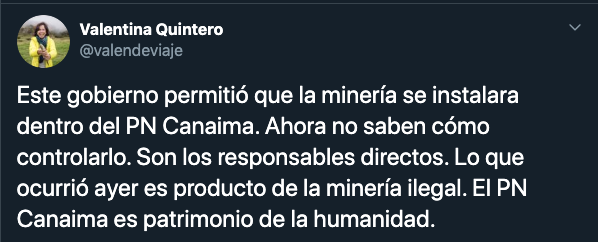
December 10: The Council of General Caciques of the Pemón Indigenous Peoples, the Communitarian Cacique of Canaima and the Council of Elders of Canaima, release a joint statement regarding the military assault in the Arenal sector of the national park.
December 11: The Minister of Defense, Vladimir Padrino López, declares that the Bolivarian National Armed Forces (FANB) and the Operational Strategic Command of the Bolivarian Armed Forces (CEOFANB) have dismantled illegal mining camps in Canaima National Park. “Several makeshift barges and extraction machinery which were destroying the groundcover of the river in the Arenales (sic) sector were dismantled”.
December 11: In Kanaimó, the Council of General Caciques of the Pemón Peoples activates special indigenous jurisdiction and issue a second statement: “Our indigenous brothers, Carlos Peñaloza and Charlie Peñaloza Rivas (deceased) were not carrying weapons at any time”.
December 11: Journalist Valentina Quintero releases a second video in which she condemns illegal mining in Campo Carrao.
December 12: President Nicolás Maduro announces that he supports the fight against illegal mining in Bolívar “which has cost the lives of many indigenous people in the region” who have battled against mafias and criminal groups.
Maduro accuses former governor Andrés Velásquez and Congressman Américo De Grazia of leading a mafia which has caused an ecocide in Canaima National Park.
December 13: The Pemón tribe condemns the death of a member of their community and accuse Vladimir Padrino López of being an “assassin and a coward” after the military operations in the area. They demand the withdrawal of the undercover military operation in Canaima.
December 14: “They want to displace us so they can give our lands to foreigners”, says the family of Charlie Peñaloza, the Pemón indigenous man murdered in the Canaima attacks.
December 20: Amnesty International releases a statement condemning the violent attack during the two-day military operation in Pemón ancestral territory.
December 21: The Council of General Caciques releases a third official statement regarding the military operation on December 8.

February 22-23: Three indigenous Pemón men in the Kumarakapay community, Gran Sabana municipality, Bolívar, are assassinated after security forces and dozens of buses filled with pro-government militias known as “colectivos” attack them for their efforts to get humanitarian aid into Venezuela.
Emilio González, Mayor of Santa Elena de Uairén, flees the country after being persecuted by military forces and takes refuge in the bordering town of Roraima, Brazil.
February 29: The Inter-American Commission on Human Rights grants precautionary measures in favor of the Pemón peoples from the Kumarakapay community and of indigenous rights defender Olanr Ortiz, national coordinator of indigenous peoples for the NGO Foro Penal, in the belief that they face a serious, urgent risk of suffering irreparable damages to their rights.
March 6: Nicolás Maduro declares that the region of “Guayana is an industrial alternative” of the national economy to sustain economic growth in times of blockade and imperialist persecution to achieve virtuous growth cycles of a new productive economy”.
April 9: The National Assembly issues a report on the situation of the Pemón indigenous people in Santa Elena de Uairén, Bolívar, after the February 22-23 events.
The Inter-American Commission on Human Rights announces it will continue to watch over the fulfillment of precautionary measures in favor of the Kumarakapay indigenous community and indigenous rights defender Olnar Ortiz.
April 23: Ángel Álvarez, Congressman for the state of Bolívar warns that 30,000 people are at risk of mercury contamination in the southern part of the state.
June 4: The Minister of Environmental Mining Development, Víctor Cano, insists that the government prohibits mining in national parks. He reiterates this message to Pemón indigenous leaders.
September 9: At the 42nd session of the Human Rights Council, The UN High Commissioner for Human Rights, Michelle Bachelet, presents an extended report on the situation in Venezuela under the government of Nicolás Maduro. In this report, the Commissioner alerts about the increase of militarization in Pemón territory; violence against the Warao indigenous people in Delta Amacuro state and the Curripaco in Amazonas. She also mentions the impact that mining of gold, diamonds, coltan and other metals in the Orinoco Mining Arc has had on the daily life of indigenous peoples as well as the environmental impact it has had on their lands. The document mentions that indigenous authorities and NGO’s insist that there was no previous consultation or adequate environmental impact studies during the establishment of the mining mega project.
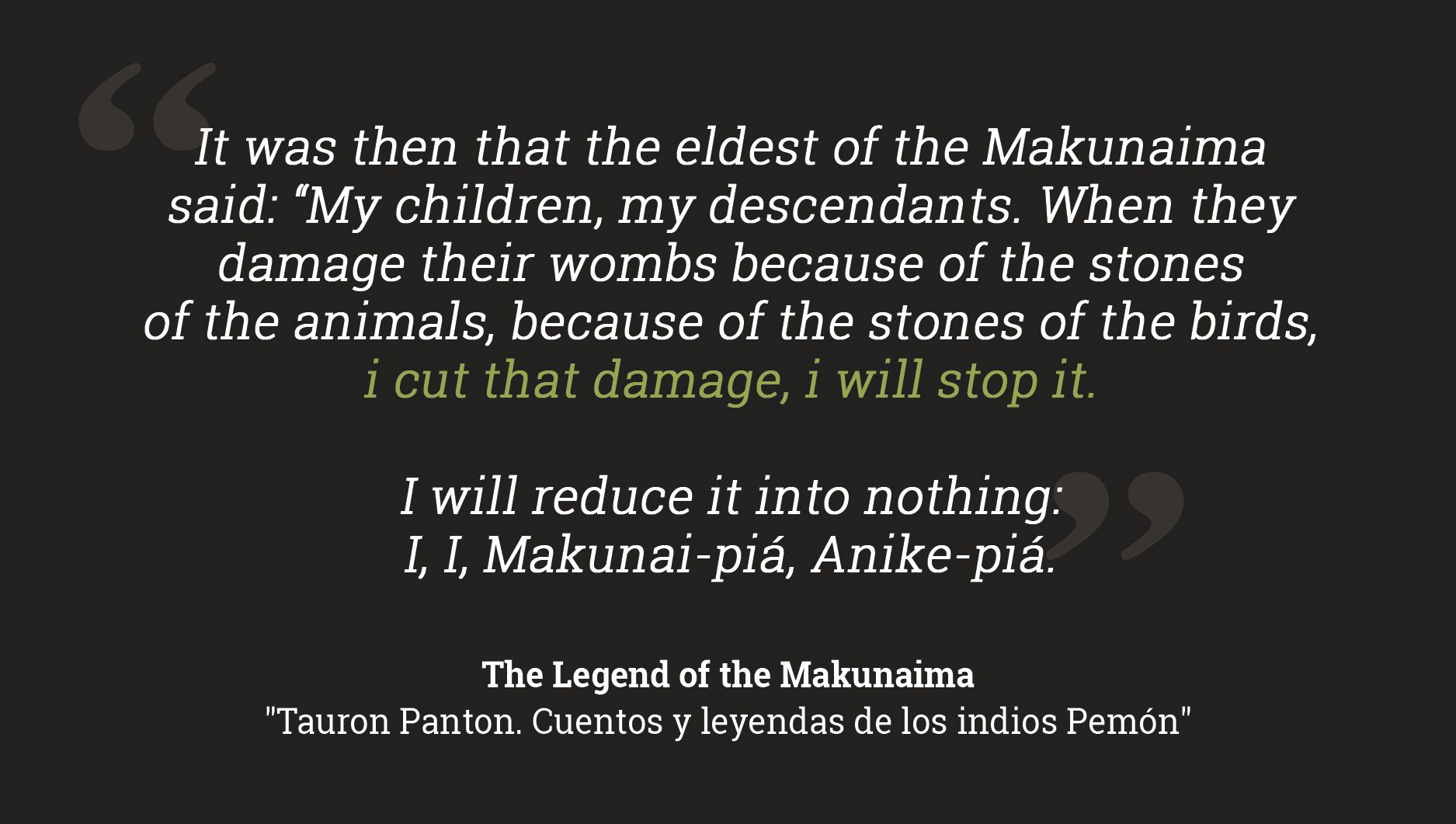
Text and Photos: Lisseth Boon and Lorena Meléndez
Design and Layout: Carmen Riera
Maps and infographics: Mayerlin Perdomo
Videos: Abrahan Moncada
Social Media: Andrea Bello
Editor: Laura Helena Castillo
General Production: Lisseth Boon


